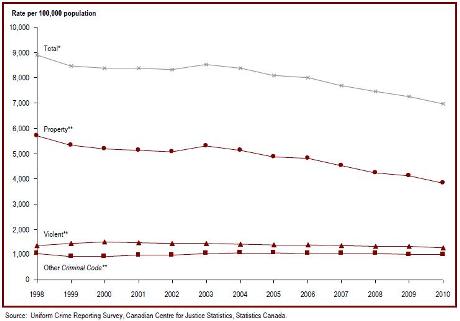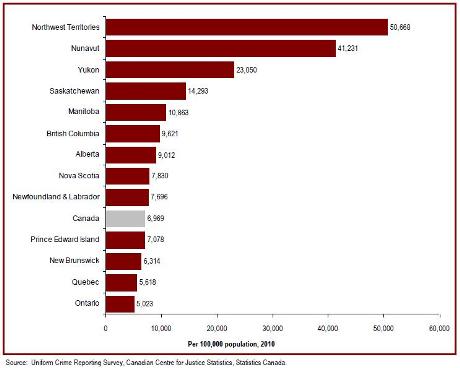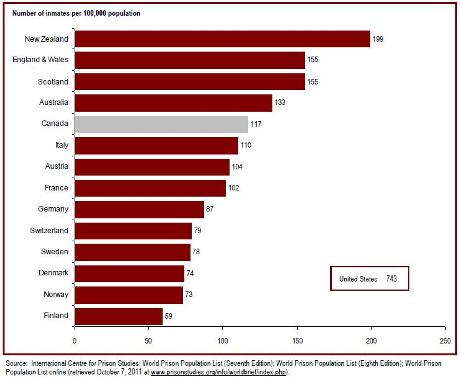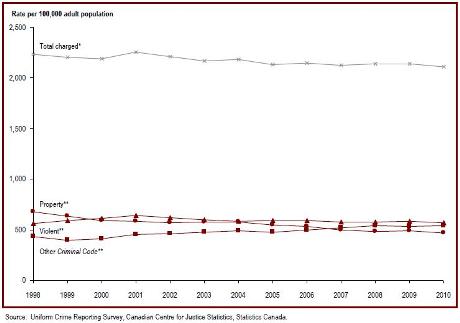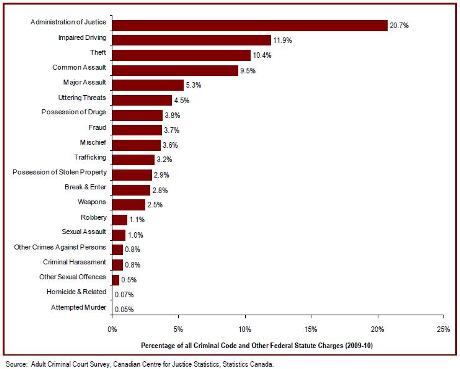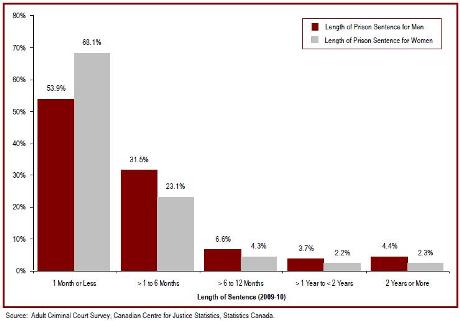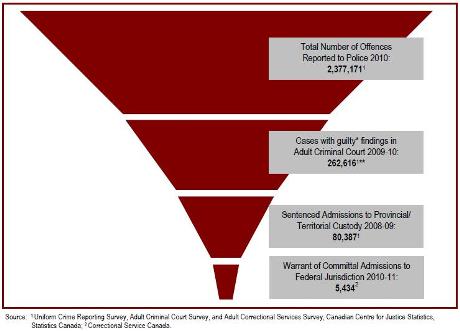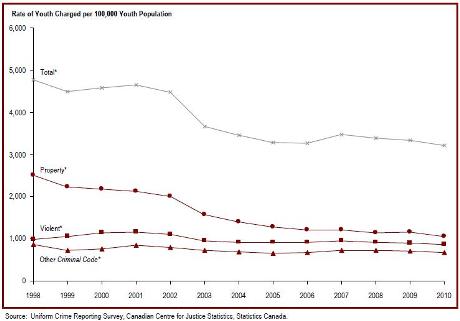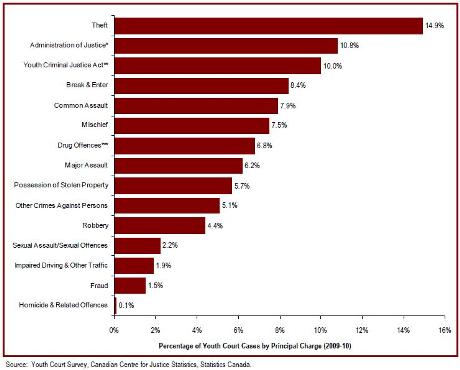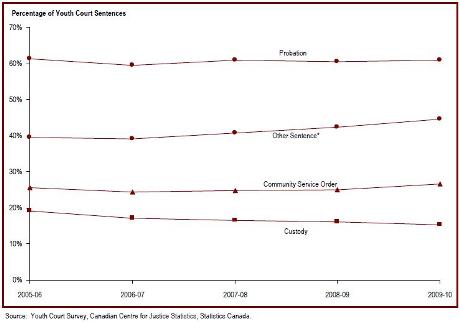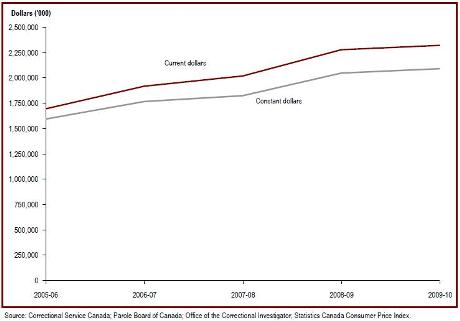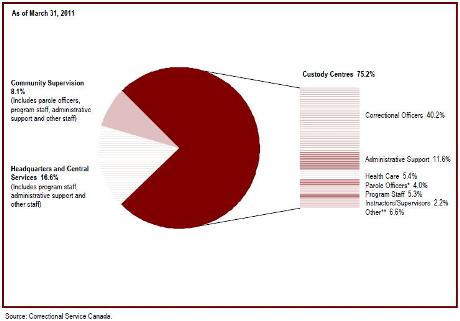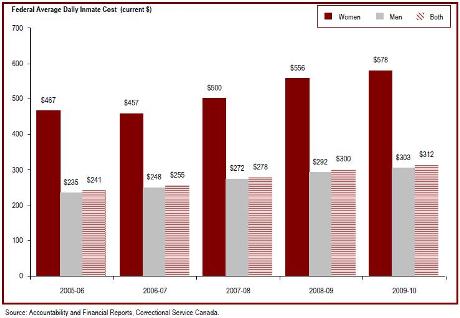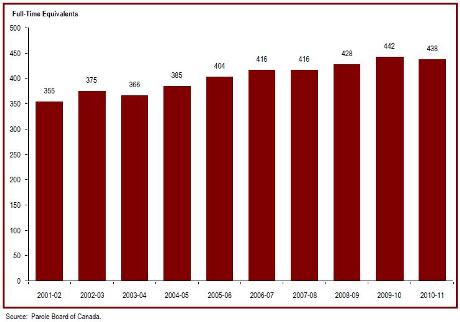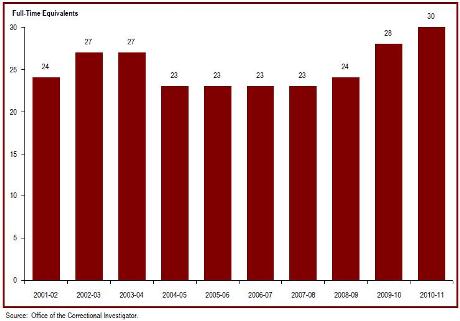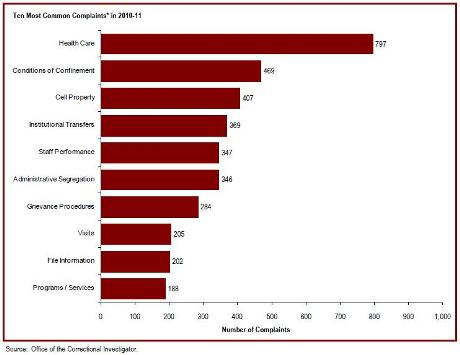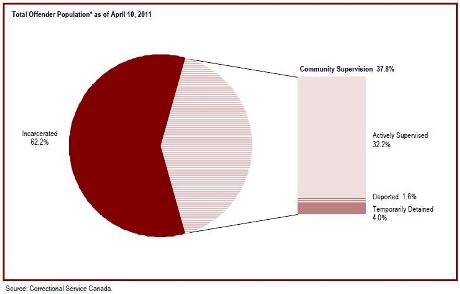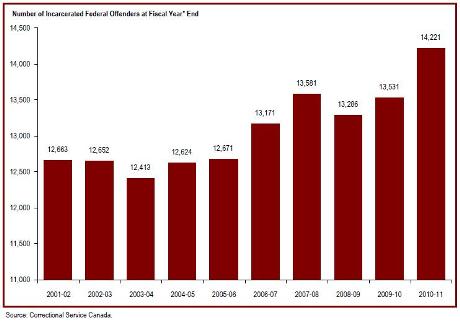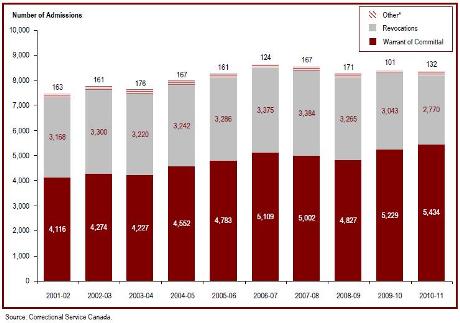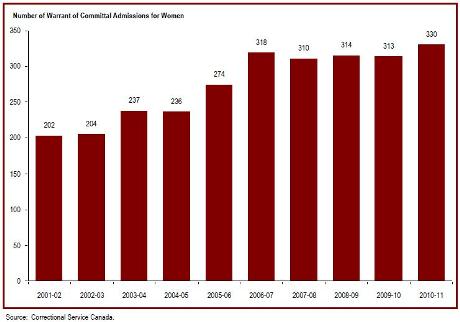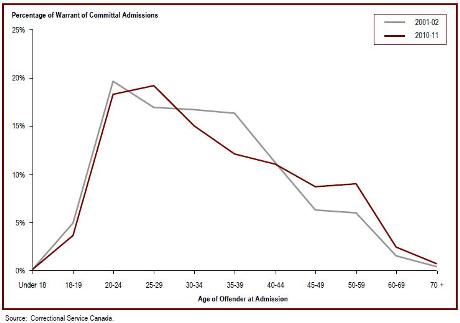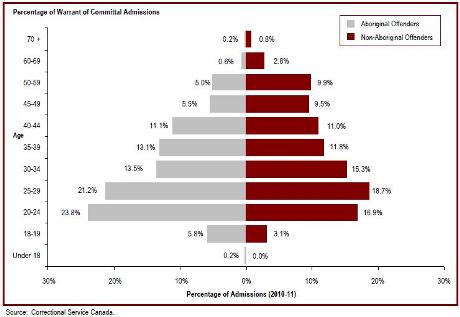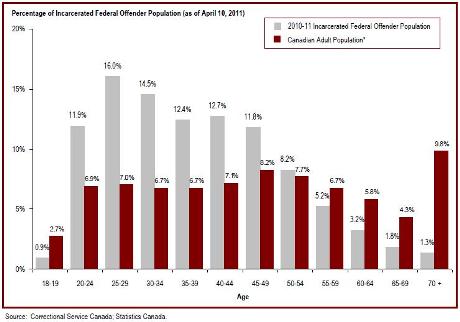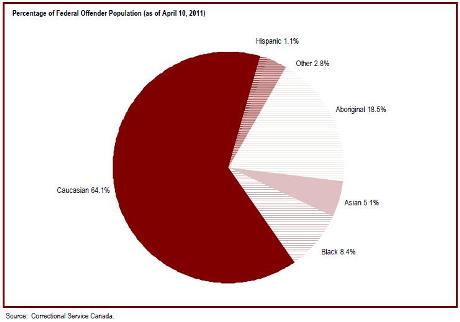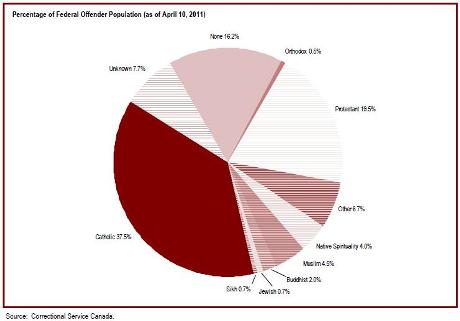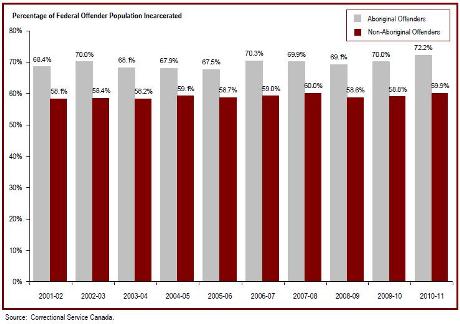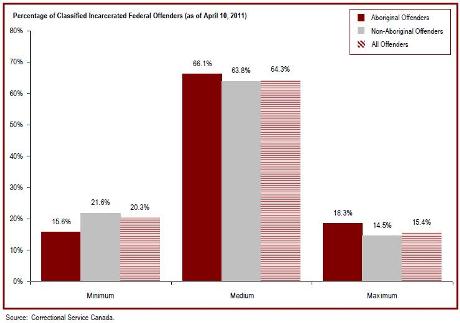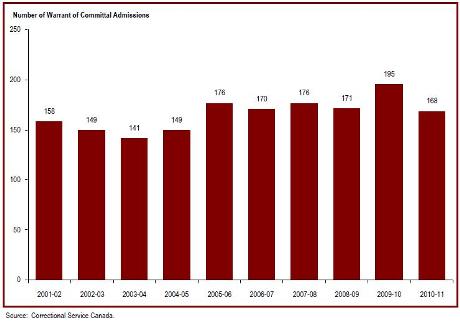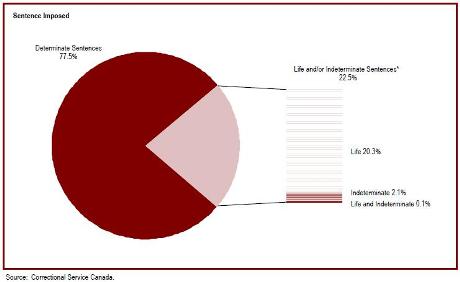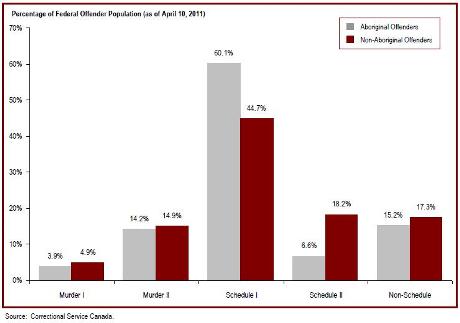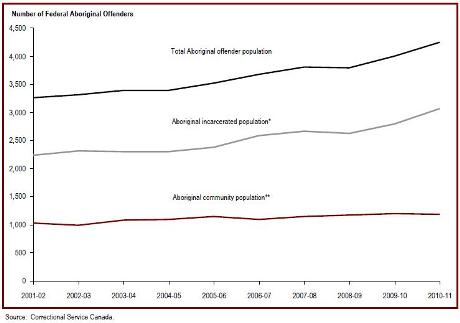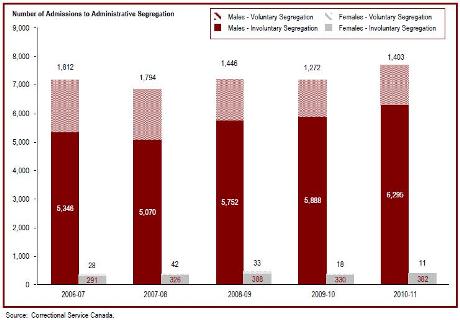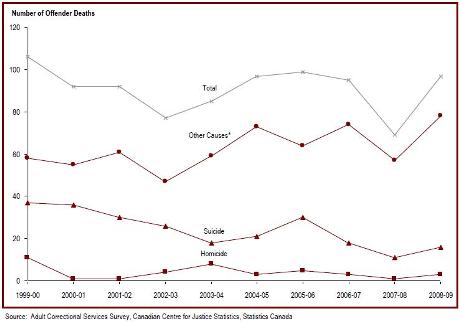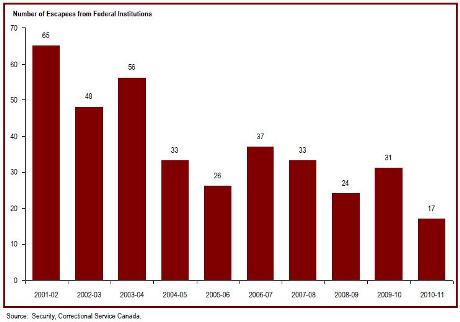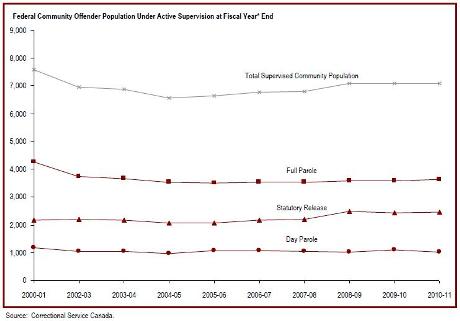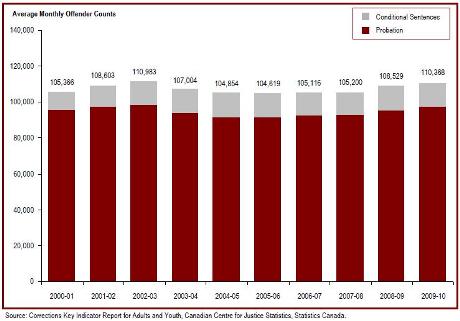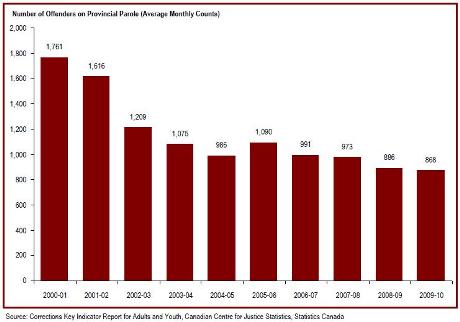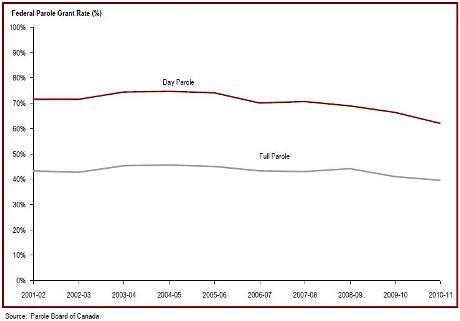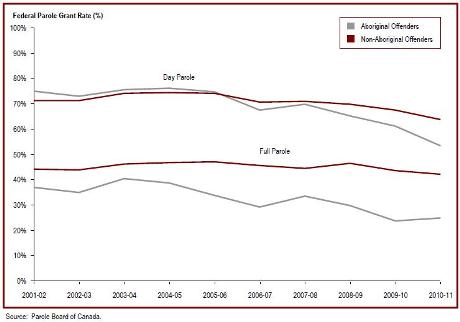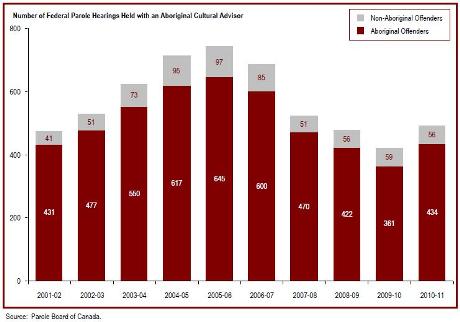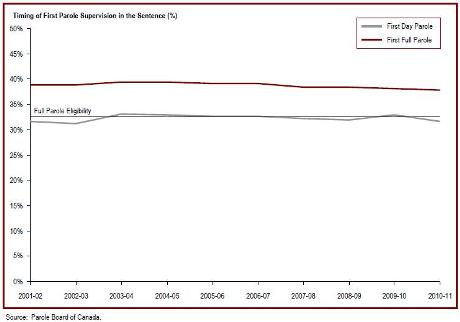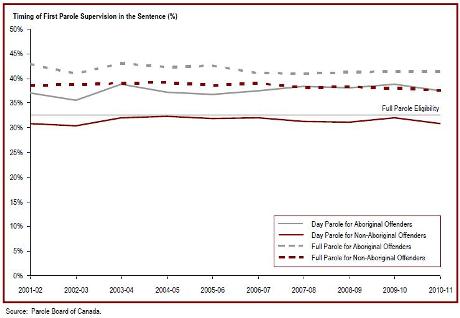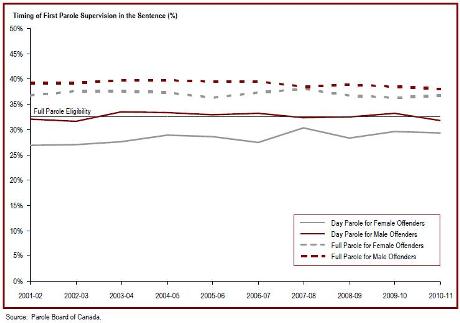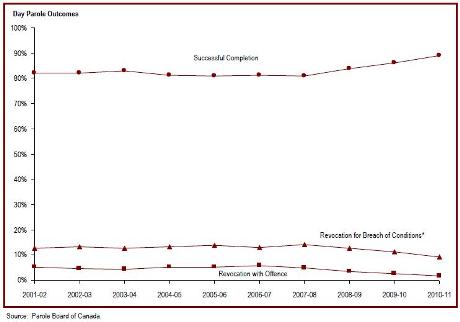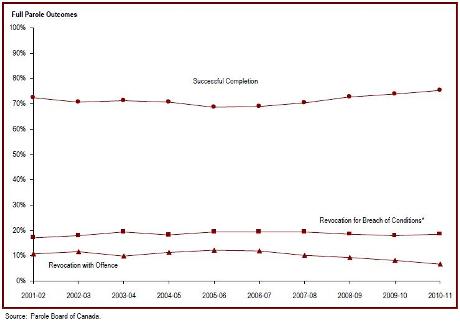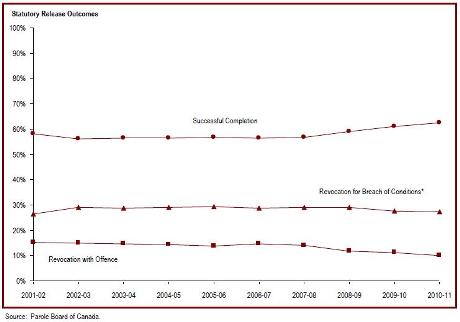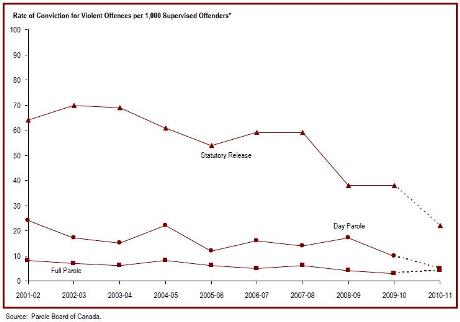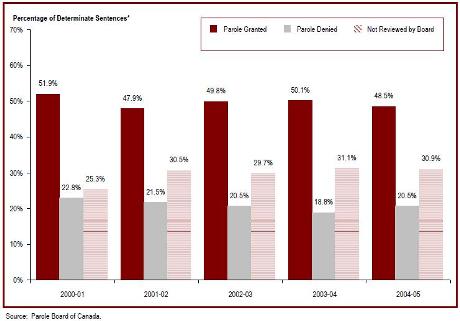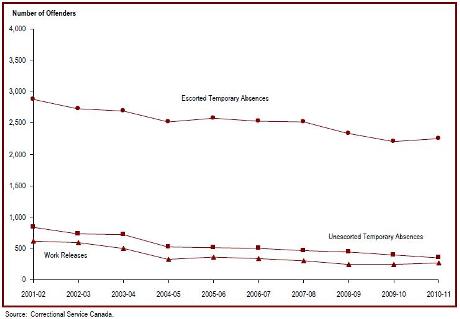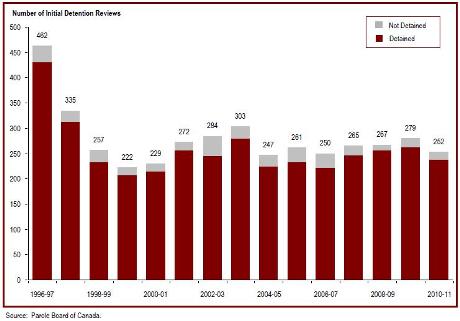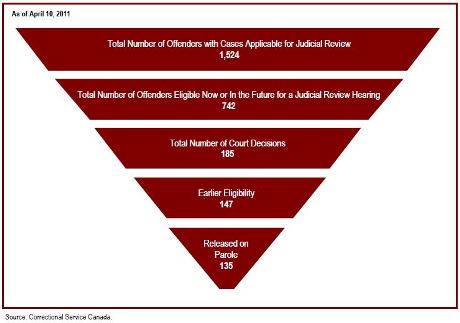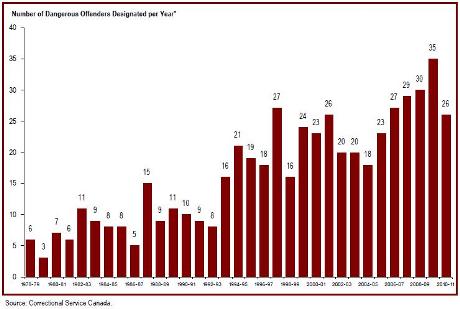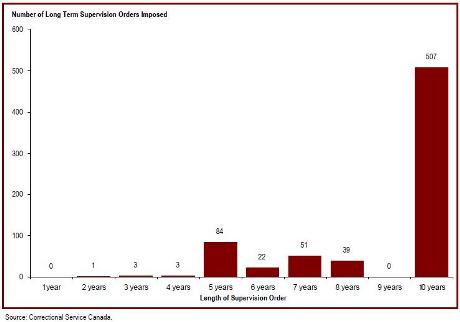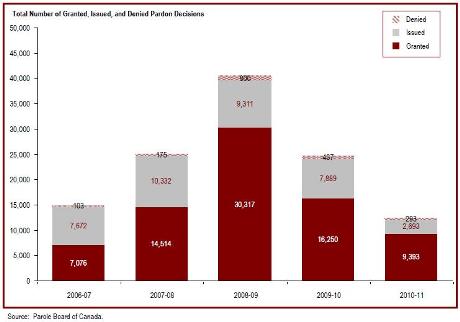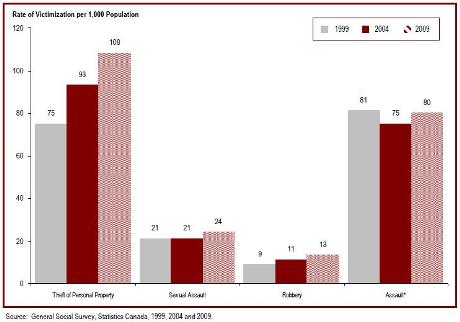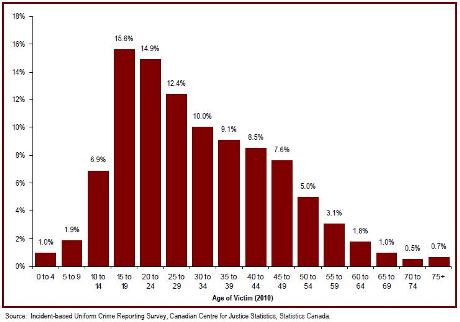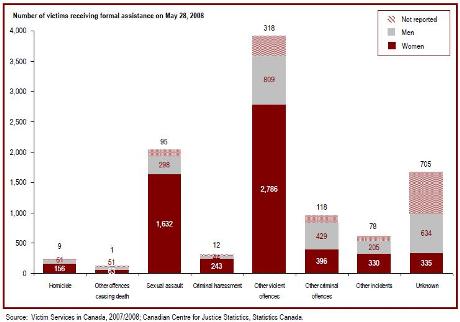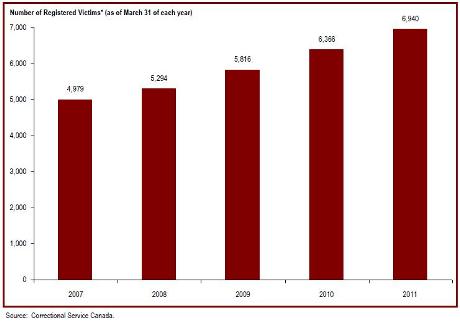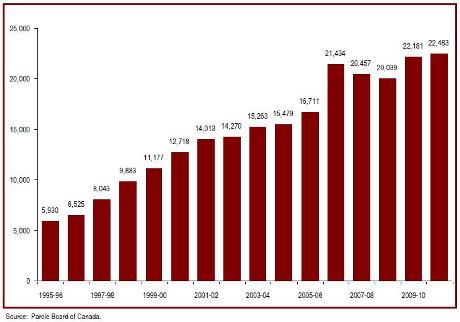2011 Corrections and Conditional Release Statistical Overview
Table of contents
Section A: Context - Crime and the Criminal Justice System
- Police-reported crime rate has been decreasing since 1998
- Crime rates are higher in the west and highest in the north
- Canada's incarceration rate is high relative to most western European countries
- The rate of adults charged has declined since 2001
- Administration of justice cases account for 21% of charges in adult courts
- Most adult custodial sentences ordered by the court are short
- Relatively few crimes result in sentences to federal penitentiaries
- The rate of youth charged has fluctuated over the past five years
- The most common youth court case is theft
- The most common sentence for youth is probation
Section B: Corrections Administration
- Federal expenditures on corrections increased in 2009-10
- CSC employees are concentrated in custody centres
- The cost of keeping an inmate incarcerated has increased
- The number of Parole Board of Canada employees
- The number of employees in the Office of the Correctional Investigator
- Health care is the most common area of offender complaint received by the Office of the Correctional Investigator
Section C: Offender Population
- Federal offenders under the jurisdiction of the Correctional Service of Canada
- The number of incarcerated federal offenders increased in 2010-11
- The number of admissions to federal jurisdiction has fluctuated
- The number of women admitted from the courts to federal jurisdiction has increased over the past decade
- Offender age at admission to federal jurisdiction is increasing
- The average age at admission is lower for Aboriginal offenders than for non-Aboriginal offenders
- 20% of the federal incarcerated offender population is aged 50 or over
- 64% of federal offenders are Caucasian
- The religious identification of the offender population is diverse
- The proportion of Aboriginal offenders incarcerated is higher than for non-Aboriginal offenders
- The majority of incarcerated federal offenders are classified as medium security risk
- Admissions with a life or indeterminate sentence increased in 2010-11
- Offenders with life or indeterminate sentences represent 23% of the total offender population
- 67% of federal offenders are serving a sentence for a violent offence
- The number of Aboriginal offenders under federal jurisdiction has increased
- The total number of admissions to administrative segregation has fluctuated
- The number of offender deaths while in custody has fluctuated
- The number of escapes has decreased
- The supervised federal offender population in the community has increased since 2004-05
- Over the last two years, the provincial/territorial community corrections population has increased
- The number of offenders on provincial parole has decreased over the past decade
Section D: Conditional Release
- The federal day and full parole grant rates are decreasing
- The federal day parole grant rate for Aboriginal offenders decreased in 2010-11
- Federal parole hearings involving an Aboriginal Cultural Advisor increased for the first time in the past four years
- Offenders serve about 40% of their sentence prior to starting first full parole
- Aboriginal offenders serve a higher proportion of their sentences before being released on parole
- Women serve a lower proportion of their sentences than men before being released on parole
- The majority of federal day paroles are successfully completed
- The majority of federal full paroles are successfully completed
- The majority of statutory releases are successfully completed
- Over the past decade, the rate of violent conviction for offenders while under supervision has declined
- Over 25% of offenders serving determinate sentences were not reviewed for parole
- The number of offenders granted temporary absences has decreased since 2001-02
Section E: Statistics on Special Applications of Criminal Justice
- The number of detention reviews has fluctuated over the past five years
- 80% of judicial review hearings result in earlier parole eligibility
- The number of dangerous offender designations has decreased in 2010-11
- Most long term supervision orders are for a 10-year period
- The number of pardon applications processed has decreased
Section F: Victims of Crime
- Victimization rates for theft of personal property have increased
- The majority of victims of violent crime are under 30
- The majority of victims receiving services are victims of violent crime
- The number of victims registered with the federal correctional system has increased
- Parole Board of Canada contacts with victims have increased
Section A: Context - Crime and the Criminal Justice System
Police-reported crime rate has been decreasing since 1998
- The overall crime rate has decreased 21.8% since 1998, from 8,915 per 100,000 to 6,969 in 2010.
- Over the same period, there was a 32.5% decrease in the property crime rate, from a rate of 5,696 per 100,000 to 3,846 in 2010. In contrast, the crime rate for drug offences has increased 35.3% since 1998, from 235 per 100,000 population to 318.
- The rate of violent crime has fluctuated over the last twelve years, peaking in 2000 at 1,494 per 100,000 population. Since 2000, the rate of violent crimes has decreased 14.2% to 1,282 in 2010.
- In general, the crime rates for traffic offences and other Criminal Code offences have fluctuated since 1998.
Note:
*Unlike Statistics Canada, the Total Crime Rate in the Corrections and Conditional Release Statistical Overview includes traffic offences and offences against federal statutes to provide a measure of all criminal offences. As a result, the Total Crime Rate reported here is higher than that reported by Statistics Canada.
**The definitions for Violent, Property and Other Criminal Code offences have been revised by Statistics Canada to better reflect definitions used by the policing community. As a result of these changes, comparable data are only available starting in 1998 and the data presented in this year's report are not comparable to the data reported in previous versions of the Corrections and Conditional Release Statistical Overview.
These crime statistics are based on crimes that are reported to the police. Since not all crimes are reported to the police, these figures underestimate actual crime. See Figure F1 for rates based on victimization surveys (drawn from the General Social Survey), an alternative method of measuring crime.
| Year | Type of offence | ||||||
|---|---|---|---|---|---|---|---|
| Violent** | Property** | Traffic | Other CCC** | Drugs | Other Fed. Statutes | Total* | |
| 1998 | 1,345 | 5,696 | 469 | 1,051 | 235 | 119 | 8,915 |
| 1999 | 1,440 | 5,345 | 388 | 910 | 264 | 128 | 8,474 |
| 2000 | 1,494 | 5,189 | 370 | 924 | 287 | 113 | 8,376 |
| 2001 | 1,473 | 5,124 | 393 | 989 | 288 | 123 | 8,390 |
| 2002 | 1,441 | 5,080 | 379 | 991 | 296 | 128 | 8,315 |
| 2003 | 1,435 | 5,299 | 373 | 1,037 | 274 | 115 | 8,532 |
| 2004 | 1,404 | 5,123 | 379 | 1,072 | 306 | 107 | 8,391 |
| 2005 | 1,389 | 4,884 | 378 | 1,052 | 290 | 97 | 8,090 |
| 2006 | 1,386 | 4,808 | 376 | 1,049 | 295 | 87 | 8,002 |
| 2007 | 1,352 | 4,519 | 402 | 1,028 | 307 | 90 | 7,697 |
| 2008 | 1,332 | 4,249 | 436 | 1,037 | 307 | 99 | 7,460 |
| 2009 | 1,318 | 4,111 | 433 | 1,015 | 291 | 94 | 7,262 |
| 2010 | 1,282 | 3,846 | 410 | 1,016 | 318 | 96 | 6,969 |
Source: Uniform Crime Reporting Survey, Canadian Centre for Justice Statistics, Statistics Canada.
Note:
*Unlike Statistics Canada, the Total Crime Rate in the Corrections and Conditional Release Statistical Overview includes traffic offences and offences against federal statutes to provide a measure of all criminal offences. As a result, the Total Crime Rate reported here is higher than that reported by Statistics Canada.
**The definitions for Violent, Property and Other Criminal Code offences have been revised by Statistics Canada to better reflect definitions used by the policing community. As a result of these changes, comparable data are only available starting in 1998 and the data presented in this year's report are not comparable to the data reported in previous versions of the Corrections and Conditional Release Statistical Overview.
Rates are based on incidents reported per 100,000 population.
Due to rounding, rates may not add to Totals.
Crime rates are higher in the west and highest in the north
- Crime rates are higher in the west and highest in the Territories. This general pattern has been stable over time.
- The Canadian crime rate* dropped from 8,002 in 2006 to 6,969 in 2010.
Note:
*Rates are based on 100,000 population.
Unlike Statistics Canada, the Crime Rate in the Corrections and Conditional Release Statistical Overview includes traffic offences and offences against federal statutes to provide a measure of all criminal offences. As a result, the Crime Rate reported here is higher than that reported by Statistics Canada. In addition, the definitions for Violent, Property and Other Criminal Code offences have been revised by Statistics Canada to better reflect definitions used by the policing community. As a result of these changes, comparable data are only available starting in 1998 and the data presented in this year's report are not comparable to the data reported in previous versions of the Corrections and Conditional Release Statistical Overview.
| Province/Territory | Crime Rate * | ||||
|---|---|---|---|---|---|
| 2006 | 2007 | 2008 | 2009 | 2010 | |
| Newfoundland & Labrador | 6,664 | 7,052 | 7,146 | 7,386 | 7,696 |
| Prince Edward Island | 7,510 | 6,791 | 6,895 | 7,072 | 7,078 |
| Nova ,Scotia | 8,747 | 8,218 | 7,751 | 7,742 | 7,830 |
| New Brunswick | 6,701 | 6,307 | 6,506 | 6,402 | 6,314 |
| Quebec | 6,133 | 5,891 | 5,952 | 5,845 | 5,618 |
| Ontario | 5,969 | 5,683 | 5,457 | 5,283 | 5,023 |
| Manitoba | 12,318 | 11,658 | 10,634 | 11,257 | 10,863 |
| Saskatchewan | 15,266 | 15,124 | 14,553 | 14,437 | 14,293 |
| Alberta | 10,173 | 10,059 | 10,058 | 9,578 | 9,012 |
| British Columbia | 12,375 | 11,702 | 10,800 | 10,180 | 9,621 |
| Yukon | 21,496 | 22,982 | 24,203 | 25,422 | 23,050 |
| Northwest Territories | 43,699 | 46,508 | 47,971 | 45,733 | 50,668 |
| Nunavut | 33,053 | 31,974 | 37,253 | 39,852 | 41,231 |
| Canada | 8,002 | 7,697 | 7,460 | 7,262 | 6,969 |
Source: Uniform Crime Reporting Survey, Canadian Centre for Justice Statistics, Statistics Canada.
Note:
*Rates are based on 100,000 population.
Unlike Statistics Canada, the Crime Rate in the Corrections and Conditional Release Statistical Overview includes traffic offences and offences against federal statutes to provide a measure of all criminal offences. As a result, the Crime Rate reported here is higher than that reported by Statistics Canada. In addition, the definitions for Violent, Property and Other Criminal Code offences have been revised by Statistics Canada to better reflect definitions used by the policing community. As a result of these changes, comparable data are only available starting in 1998 and the data presented in this year's report are not comparable to the data reported in previous versions of the Corrections and Conditional Release Statistical Overview.
Canada's incarceration rate is high relative to most western European countries
- Canada's incarceration rate is higher than the rates in most Western European countries but much lower than the United States, where the most recent incarceration rate was 743 per 100,000 general population.
- Based on the most up to date information available from the International Centre for Prison Studies, Canada's incarceration rate was 117 per 100,000, calculated based on the 2008 population.
Note:
The incarceration rate, in this figure, is a measure of the number of people (i.e., adults and youth) in custody per 100,000 people in the general population. Incarceration rates from the World Prison Population List are based on the most recently available data at the time the list was compiled. Due to variations in the availability of information, the 2006 and 2008 dates reported in Figure A3 refer to when the World Prison Population Lists (Seventh and Eighth Editions respectively) were published, but may not necessarily correspond to the date the data were obtained. For 2011, the data was retrieved online on October 7, 2011 from www.prisonstudies.org/info/worldbrief/index.php which contains the most up-to-date information available. These data reflect incarceration rates based on the country's population in 2011 except where noted. Additionally, different practices and variations in measurement in different countries limit the comparability of these figures.
| 1998 | 1999 | 2000 | 2001 | 2002 | 2003 | 2004 | 20061* | 20082* | 20113* | |
|---|---|---|---|---|---|---|---|---|---|---|
| United States | 682 | 682 | 699 | 700 | 701 | 714 | 723 | 738 | 756 | 743b |
| New Zealand | 150 | 149 | 149 | 145 | 155 | 168 | 168 | 186 | 185 | 199 |
| England & Wales | 125 | 125 | 124 | 125 | 141 | 142 | 141 | 148 | 153 | 155 |
| Scotland | 119 | 118 | 115 | 120 | 129 | 132 | 136 | 139 | 152 | 155 |
| Australia | 110 | 108 | 108 | 110 | 115 | 117 | 120 | 126 | 129 | 133a |
| Canada | 123 | 118 | 116 | 116 | 116 | 108 | 107 | 107 | 116 | 117c |
| Italy | 85 | 89 | 94 | 95 | 100 | 98 | 96 | 104 | 92 | 110 |
| Austria | 86 | 85 | 84 | 85 | 100 | 106 | 110 | 105 | 95 | 104a |
| France | 88 | 91 | 89 | 80 | 93 | 91 | 91 | 85 | 96 | 102 |
| Germany | 96 | 97 | 97 | 95 | 98 | 96 | 98 | 95 | 89 | 87 |
| Switzerland | 85 | 81 | 79 | 90 | 68 | 81 | 81 | 83 | 76 | 79a |
| Sweden | 60 | 59 | 64 | 65 | 73 | 75 | 81 | 82 | 74 | 78a |
| Denmark | 64 | 66 | 61 | 60 | 64 | 70 | 70 | 77 | 63 | 74 |
| Norway | 57 | 56 | - | 60 | 59 | 65 | 65 | 66 | 69 | 73 |
| Finland | 54 | 46 | 52 | 50 | 70 | 71 | 66 | 75 | 64 | 59 |
Source: International Centre for Prison Studies: 1 World Prison Population List (Seventh Edition); 2 World Prison Population List (Eighth Edition); 3 World Prison Population List online (retrieved October 7, 2011 at www.prisonstudies.org/info/worldbrief/index.php).
Note:
*Incarceration rates from the World Prison Population List are based on the most recently available data at the time the list was compiled. Due to variations in the availability of information, the 2006 and 2008 dates reported in Table A3 refer to when the World Prison Population Lists (Seventh and Eighth Editions respectively) were published, but may not necessarily correspond to the date the data were obtained. For 2011, the data was retrieved online on October 7, 2011 from www.prisonstudies.org/info/worldbrief/index.php which contains the most up to date information available. These data reflect incarceration rates based on the country's population in 2011 except where noted: a indicates the estimate was based on the country's population in 2010, b based on the 2009 population, and c based on the 2008 population. Additionally, different practices and variations in measurement in different countries limit the comparability of these figures. Rates are based on 100,000 population.
-- Figures not available.
The rate of adults charged has declined since 2001
- Since 1998, the rate of women charged has increased from 718 women per 100,000 women in the population to 818. However, the rate for men has decreased from 3,819 men per 100,000 men in the population to 3,454.
- Over the same period, the rate of women charged with violent crimes increased by 31.6%, such that in 2010, 194 women were charged per 100,000 women in the population. In comparison, the rate of men charged with violent crimes decreased by 3.5% over the last twelve years. Since reaching a peak of 1,109 men charged per 100,000 men in the population in 2001, the rate has since decreased to 961 in 2010.
- Similarly, the rate of women charged with traffic crimes has also increased, from 78 women charged per 100,000 women in the population in 1998, to 94 in 2010. Conversely, the rate of men charged with traffic crimes has decreased 26.4% since 1998, to 499 men charged per 100,000 men in the population in 2010.
Note:
*Unlike Statistics Canada, the Total Crime Rate in the Corrections and Conditional Release Statistical Overview includes traffic offences and offences against federal statutes to provide a measure of all criminal offences. As a result, the Total Crime Rate reported here is higher than that reported by Statistics Canada.
**The definitions for Violent, Property and Other Criminal Code offences have been revised by Statistics Canada to better reflect definitions used by the policing community. As a result of these changes, comparable data are only available starting in 1998 and the data presented in this year's report are not comparable to the data reported in previous versions of the Corrections and Conditional Release Statistical Overview.
Violent crimes include homicide, attempted murder, assault, sexual offences, abduction, extortion, robbery, firearms, and other violent offences such as uttering threats and criminal harassment.
Property crimes include break and enter, motor vehicle thefts, other thefts, possession of stolen property, fraud, mischief and arson.
| Year | Type of offence | ||||||
|---|---|---|---|---|---|---|---|
| Violent** | Property** | Traffic | Other CCC** | Drugs | Other Fed. Statutes | Total Charged* | |
| 1998 | 563 | 677 | 374 | 430 | 168 | 24 | 2,236 |
| 1999 | 590 | 632 | 371 | 396 | 185 | 30 | 2,203 |
| 2000 | 615 | 591 | 349 | 411 | 198 | 26 | 2,190 |
| 2001 | 641 | 584 | 349 | 451 | 202 | 28 | 2,256 |
| 2002 | 617 | 569 | 336 | 460 | 199 | 29 | 2,211 |
| 2003 | 598 | 573 | 326 | 476 | 172 | 23 | 2,168 |
| 2004 | 584 | 573 | 314 | 490 | 187 | 30 | 2,180 |
| 2005 | 589 | 550 | 299 | 479 | 185 | 29 | 2,131 |
| 2006 | 593 | 533 | 300 | 498 | 198 | 27 | 2,149 |
| 2007 | 576 | 499 | 298 | 520 | 208 | 28 | 2,128 |
| 2008 | 574 | 485 | 306 | 538 | 207 | 31 | 2,142 |
| 2009 | 582 | 488 | 309 | 530 | 200 | 33 | 2,143 |
| 2010 | 572 | 469 | 293 | 540 | 210 | 31 | 2,114 |
Source: Uniform Crime Reporting Survey, Canadian Centre for Justice Statistics, Statistics Canada.
Note:
*Unlike Statistics Canada, the Total Crime Rate in the Corrections and Conditional Release Statistical Overview includes traffic offences and offences against federal statutes to provide a measure of all criminal offences. As a result, the Total Crime Rate reported here is higher than that reported by Statistics Canada.
**The definitions for Violent, Property and Other Criminal Code offences have been revised by Statistics Canada to better reflect definitions used by the policing community. As a result of these changes, comparable data are only available starting in 1998 and the data presented in this year's report are not comparable to the data reported in previous versions of the Corrections and Conditional Release Statistical Overview.
Rates are based on 100,000 population, 18 years of age and older.
Due to rounding, rates may not add to Totals.
Violent crimes include homicide, attempted murder, assault, sexual offences, abduction, extortion, robbery, firearms, and other violent offences such as uttering threats and criminal harassment.
Property crimes include break and enter, motor vehicle thefts, other thefts, possession of stolen property, fraud, mischief and arson.
Administration of justice cases account for 21% of cases* in adult courts
- Administration of justice cases (offences related to case proceedings such as failure to appear in court, failure to comply with a court order, breach of probation, and unlawfully at large) account for more than one fifth of cases completed in adult criminal courts.
- Apart from administration of justice cases, impaired driving is the most frequent federal statute case in adult courts.
Note:
*Cases completed in adult criminal courts.
The concept of a case has changed to more closely reflect court processing. Statistics from the Adult Criminal Court Survey used in this report should not be compared to editions of the Corrections and Conditional Release Statistical Overview prior to 2007. A case is one or more charges against an accused person or corporation, processed by the courts at the same time, and where all of the charges in the case received a final disposition. Where a case has more than one charge, it is necessary to select a charge to represent the case. An offence is selected by applying two rules. First, the “most serious decision” rule is applied. In cases where two or more offences have the same decision, the “most serious offence” rule is applied. All charges are ranked according to an offence seriousness scale.
Superior Court data are not reported to the Adult Criminal Court Survey for Quebec, Ontario, Manitoba and Saskatchewan. In addition, information from Quebec's municipal courts (which account for approximately 25% of Criminal Code charges in the provinces) is not collected.
The graph excludes Youth Criminal Justice Act / Young Offenders Act offences. The Adult Criminal Court Survey groups these offences under “Other Federal Statutes”.
The Canadian Centre for Justice Statistics continues to make updates to the offence library used to classify offence data sent by the provinces and territories. These improvements have resulted in minor changes in the counts of charges and cases as well as the distributions by type of offence. Data presented have been revised to account for these updates.
| Type of Charge | Criminal Code and Other Federal Statute Charges | |||||
|---|---|---|---|---|---|---|
| 2007-2008 | 2008-2009 | 2009-2010 | ||||
| # | % | # | % | # | % | |
| Crimes Against the Person | 94,063 | 23.92 | 95,114 | 23.86 | 95,345 | 23.64 |
| Homicide and Related | 301 | 0.08 | 275 | 0.07 | 263 | 0.07 |
| Attempted Murder | 235 | 0.06 | 167 | 0.04 | 193 | 1.08 |
| Robbery | 4,486 | 1.14 | 4,466 | 1.12 | 4,360 | 0.99 |
| Sexual Assault | 4,137 | 1.05 | 4,145 | 1.04 | 4,008 | 0.50 |
| Other Sexual Offences | 1,908 | 0.49 | 2,046 | 0.51 | 2,023 | 5.34 |
| Major Assault (Levels 2 & 3) | 20,863 | 5.31 | 21,509 | 5.39 | 21,549 | 9.49 |
| Common Assault (Level 1) | 37,630 | 9.57 | 37,496 | 9.40 | 38,276 | 4.55 |
| Uttering Threats | 18,196 | 4.63 | 18,578 | 4.66 | 18,337 | 0.78 |
| Criminal Harassment | 3,099 | 0.79 | 3,185 | 0.80 | 3,150 | 0.79 |
| Other Crimes Against Persons | 3,208 | 0.82 | 3,247 | 0.81 | 3,186 | 24.02 |
| Crimes Against Property | 94,570 | 24.05 | 93,056 | 23.34 | 96,863 | 10.42 |
| Theft | 39,042 | 9.93 | 38,802 | 9.73 | 42,010 | 2.83 |
| Break and Enter | 11,889 | 3.02 | 11,722 | 2.94 | 11,422 | 3.71 |
| Fraud | 15,188 | 3.86 | 14,656 | 3.68 | 14,957 | 3.65 |
| Mischief | 13,616 | 3.46 | 13,952 | 3.50 | 14,716 | 2.93 |
| Possession of Stolen Property | 12,674 | 3.22 | 11,921 | 2.99 | 11,822 | 0.48 |
| Other Property Crimes | 2,161 | 0.55 | 2,003 | 0.50 | 1,936 | 20.71 |
| Administration of Justice | 82,106 | 20.88 | 83,499 | 20.94 | 83,530 | 1.15 |
| Fail to Appear | 5,293 | 1.35 | 5,123 | 1.28 | 4,627 | 7.75 |
| Breach of probation | 30,091 | 7.65 | 30,581 | 7.67 | 31,243 | 0.62 |
| Unlawfully at large | 2,661 | 0.68 | 2,552 | 0.64 | 2,496 | 9.01 |
| Fail to Comply with Order | 35,361 | 8.99 | 36,298 | 9.10 | 36,321 | 2.19 |
| Other Admin. Justice | 8,700 | 2.21 | 8,945 | 2.24 | 8,843 | 4.73 |
| Other Criminal Code | 19,295 | 4.91 | 19,048 | 4.78 | 19,085 | 2.46 |
| Weapons | 9,916 | 2.52 | 9,933 | 2.49 | 9,911 | 0.42 |
| Prostitution | 1,811 | 0.46 | 1,632 | 0.41 | 1,704 | 0.42 |
| Disturbing the Peace | 2,069 | 0.53 | 1,823 | 0.46 | 1,741 | 0.43 |
| Residual Criminal Code | 5,499 | 1.40 | 5,660 | 1.42 | 5,729 | 1.42 |
| Criminal Code Traffic | 55,520 | 14.12 | 58,282 | 14.62 | 59,668 | 14.79 |
| Impaired Driving | 44,240 | 11.25 | 46,268 | 11.60 | 48,111 | 11.93 |
| Other CC Traffic | 11,280 | 2.87 | 12,014 | 3.01 | 11,557 | 2.87 |
| Other Federal Statutes | 47,639 | 12.12 | 49,698 | 12.47 | 48,849 | 12.11 |
| Drug Possession | 15,340 | 3.90 | 15,713 | 3.94 | 15,272 | 3.79 |
| Drug Trafficking | 12,243 | 3.11 | 12,974 | 3.25 | 12,709 | 3.15 |
| Residual Federal Statutes | 18,877 | 4.80 | 19,785 | 4.96 | 19,470 | 4.83 |
| Total Offences | 393,193 | 100.00 | 398,697 | 100.00 | 403,340 | 100.0 |
Source: Adult Criminal Court Survey, Canadian Centre for Justice Statistics, Statistics Canada.
Note:
*Cases completed in adult criminal courts.
The concept of a case has changed to more closely reflect court processing. Statistics from the Adult Criminal Court Survey used in this report should not be compared to editions of the Corrections and Conditional Release Statistical Overview prior to 2007.
The table excludes Youth Criminal Justice Act / Young Offenders Act offences. The Adult Criminal Court Survey groups these offences under “Other Federal Statutes”.
Superior Court data are not reported to the Adult Criminal Court Survey for Quebec, Ontario, Manitoba and Saskatchewan. In addition, information from Quebec's municipal courts (which account for approximately 25% of Criminal Code charges in the provinces) is not collected.
The Canadian Centre for Justice Statistics continues to make updates to the offence library used to classify offence data sent by the provinces and territories. These improvements have resulted in minor changes in the counts of charges and cases as well as the distributions by type of offence. Data presented have been revised to account for these updates.
Due to rounding, percentages may not add to 100 percent.
Most adult custodial sentences ordered by the court are short
- Over half (55.4%) of all custodial sentences imposed by adult criminal courts are one month or less.
- Prison sentences for men tend to be longer than for women. Over two-thirds (68.1%) of women and just over half of men (53.9%) who are incarcerated upon guilty* finding receive a sentence of one month or less, and 91.2% of women and 85.4% of men receive a sentence of six months or less.
- Of all guilty findings that result in custody, only 4.2% result in federal jurisdiction (i.e., a sentence of two years or more).
Note:
*The type of decision group “guilty” includes guilty of the offence, of an included offence, of an attempt of the offence, or of an attempt of an included offence. This category also includes cases where an absolute or conditional discharge has been imposed.
The concept of a case has changed to more closely reflect court processing. Statistics from the Adult Criminal Court Survey used in this report should not be compared to editions of the Corrections and Conditional Release Statistical Overview prior to 2007.
Excludes Youth Criminal Justice Act / Young Offenders Act offences, cases where length of prison sentence and/or sex was not known, data for Manitoba as information on both sentence length and gender were not available, and data on corporations.
Superior Court data are not reported to the Adult Criminal Court Survey for Quebec, Ontario, Manitoba and Saskatchewan. In addition, information from Quebec's municipal courts (which account for approximately 25% of Criminal Code charges in the provinces) is not collected.
The Canadian Centre for Justice Statistics continues to make updates to the offence library used to classify offence data sent by the provinces and territories. These improvements have resulted in minor changes in the counts of charges and cases as well as the distributions by type of offence. Data presented have been revised to account for these updates.
Due to rounding, totals may not add to 100 percent.
| Length of Prison Sentence | 2005-06 | 2006-07 | 2007-08 | 2008-09 | 2009-10 |
|---|---|---|---|---|---|
| % | % | % | % | % | |
| 1 Month or Less | |||||
| Women | 68.8 | 69.6 | 69.6 | 67.7 | 68.1 |
| Men | 52.4 | 52.7 | 53.4 | 53.9 | 53.9 |
| Total | 54.1 | 54.6 | 55.3 | 55.5 | 55.4 |
| More Than 1 Month to 6 Months | |||||
| Women | 23.0 | 22.2 | 22.3 | 24.2 | 23.1 |
| Men | 32.6 | 32.1 | 31.6 | 31.4 | 31.5 |
| Total | 31.6 | 31.0 | 30.6 | 30.6 | 30.6 |
| More Than 6 Months to 12 Months | |||||
| Women | 4.1 | 4.1 | 4.3 | 4.2 | 4.3 |
| Men | 6.9 | 7.0 | 7.0 | 6.9 | 6.6 |
| Total | 6.6 | 6.6 | 6.7 | 6.6 | 6.3 |
| More Than 1 Year to Less Than 2 Years | |||||
| Women | 2.0 | 2.1 | 1.9 | 1.9 | 2.2 |
| Men | 3.8 | 3.7 | 3.7 | 3.7 | 3.7 |
| Total | 3.6 | 3.5 | 3.5 | 3.5 | 3.5 |
| 2 Years or More | |||||
| Women | 2.1 | 2.1 | 1.9 | 2.1 | 2.3 |
| Men | 4.3 | 4.6 | 4.2 | 4.0 | 4.4 |
| Total | 4.1 | 4.3 | 4.0 | 3.8 | 4.2 |
Source: Adult Criminal Court Survey, Canadian Centre for Justice Statistics, Statistics Canada.
Note:
The concept of a case has changed to more closely reflect court processing. Statistics from the Adult Criminal Court Survey used in this report should not be compared to editions of the Corrections and Conditional Release Statistical Overview prior to 2007.
Excludes Youth Criminal Justice Act / Young Offenders Act offences, cases where length of prison sentence and/or sex was not known, data for Manitoba as information on both sentence length and gender were not available, and data on corporations.
Superior Court data are not reported to the Adult Criminal Court Survey for Quebec, Ontario, Manitoba and Saskatchewan. In addition, information from Quebec's municipal courts (which account for approximately 25% of Criminal Code charges in the provinces) is not collected.
The Canadian Centre for Justice Statistics continues to make updates to the offence library used to classify offence data sent by the provinces and territories. These improvements have resulted in minor changes in the counts of charges and cases as well as the distributions by type of offence. Data presented have been revised to account for these updates.
Due to rounding, totals may not add to 100 percent.
Relatively few crimes result in sentences to federal penitentiaries
- There were about 2.4 million crimes reported to police in 2010.
- During 2010-11, 5,434 offenders were sentenced to federal jurisdiction (i.e., two years or more).
Note:
*The type of decision group “guilty” includes guilty of the offence, of an included offence, of an attempt of the offence, or of an attempt of an included offence. This category also includes cases where an absolute or conditional discharge has been imposed.
**This figure only includes cases in provincial court and partial data from Superior Court. Superior Court data are not reported to the Adult Criminal Court Survey for Quebec, Ontario, Manitoba and Saskatchewan. In addition, information from Quebec's municipal courts (which account for approximately 25% of Criminal Code charges in the provinces) is not collected.
The concept of a case has changed to more closely reflect court processing. Statistics from the Adult Criminal Court Survey used in this report should not be compared to editions of the Corrections and Conditional Release Statistical Overview prior to 2007. A case is one or more charges against an accused person or corporation, processed by the courts at the same time, and where all of the charges in the case received a final disposition.
Police data are reported on a calendar year basis whereas court and prison data are reported on a fiscal year basis (April 1 through March 31).
| 2006-07 | 2007-08 | 2008-09 | 2009-10 | 2010-11 | |
|---|---|---|---|---|---|
| Total Number of Offences Reported to Police1 | 2,606,887 | 2,534,730 | 2,485,207 | 2,448,805 | 2,377,171 |
| Cases with guilty* findings in Adult Criminal Court1** | 247,509 | 255,487 | 263,948 | 262,616 | Not available |
| Sentenced Admissions to Provincial/Territorial Custody1*** | 79,862 | 79,724 | 80,387 | Not available | Not available |
| Warrant of Committal Admissions to Federal Facilities2 | 5,109 | 5,002 | 4,827 | 5,434 | 5,434 |
Source: 1 Uniform Crime Reporting Survey, Adult Criminal Court Survey, and Adult Correctional Services Survey, Canadian Centre for Justice Statistics, Statistics Canada; 2 Correctional Service Canada.
Note:
*The type of decision group “guilty” includes guilty of the offence, of an included offence, of an attempt of the offence, or of an attempt of an included offence. This category also includes cases where an absolute or conditional discharge has been imposed.
**This figure only includes cases convicted in provincial court and partial data from Superior Court. Superior Court data are not reported to the Adult Criminal Court Survey for Quebec, Ontario, Manitoba and Saskatchewan. In addition, information from Quebec's municipal courts (which account for approximately 25% of Criminal Code charges in the provinces) is not collected.
The concept of a case has changed to more closely reflect court processing. Statistics from the Adult Criminal Court Survey used in this report should not be compared to editions of the Corrections and Conditional Release Statistical Overview prior to 2007. A case is one or more charges against an accused person or corporation, processed by the courts at the same time, and where all of the charges in the case received a final disposition.
***In order to make comparisons, data exclude Prince Edward Island and Nunavut.
Police data are reported on a calendar year basis whereas court and prison data are reported on a fiscal year basis (April 1 through March 31).
The rate of youth charged has fluctuated over the past five years
- The rate of youth** charged has fluctuated over the past five years.
- In 2003, there was a notable decrease in all major crime categories, in part attributable to the implementation of the Youth Criminal Justice Act (YCJA) in April 2003, which places greater emphasis on diversion.
- The rates*** of female youth charged with violent or property crimes have decreased since 2003, by 9.3% and 18.8% respectively. In 2010, the rate of female youth charged was 449 per 100,000 for violent crime and 526 per 100,000 for property crime.
- Over the same seven year period, the rate*** of male youth charged with violent crime decreased by 8.1% to 1,275 per 100,000 in 2010. Similarly, the rate of male youth charged with property crime declined by 36%, to 1,565 per 100,000 in 2010.
Note:
*Unlike Statistics Canada, the Total Crime Rate in the Corrections and Conditional Release Statistical Overview includes traffic offences and offences against federal statutes to provide a measure of all criminal offences. As a result, the Total Crime Rate reported here is higher than that reported by Statistics Canada. In addition, the definitions for Violent, Property and Other Criminal Code offences have been revised by Statistics Canada to better reflect definitions used by the policing community. As a result of these changes, comparable data are only available starting in 1998 and the data presented in this year's report are not comparable to the data reported in previous versions of the Corrections and Conditional Release Statistical Overview.
**For criminal justice purposes, youth are defined under Canadian law as persons aged 12 to 17 years.
***Rates for females are based on the number of female youth charged per 100,000 female youth population (12 to 17 years) and rates for males are based on the number of male youth charged per 100,000 male youth population (12 to 17 years).
Violent crimes include homicide, attempted murder, assault, sexual offences, abduction, extortion, robbery, firearms, and other violent offences such as uttering threats and criminal harassment.
Property crimes include break and enter, motor vehicle thefts, other thefts, possession of stolen property, fraud, mischief and arson.
| Year | Type of Offence | ||||||
|---|---|---|---|---|---|---|---|
| Violent* | Property* | Traffic | Other CCC* | Drugs | Other Fed. Statutes | Total Charged* | |
| 1998 | 994 | 2,500 | - | 870 | 226 | 184 | 4,775 |
| 1999 | 1,060 | 2,237 | - | 728 | 266 | 209 | 4,500 |
| 2000 | 1,136 | 2,177 | - | 760 | 317 | 198 | 4,589 |
| 2001 | 1,157 | 2,119 | - | 840 | 343 | 195 | 4,656 |
| 2002 | 1,102 | 2,009 | - | 793 | 337 | 235 | 4,476 |
| 2003 | 953 | 1,570 | - | 726 | 208 | 204 | 3,662 |
| 2004 | 918 | 1,395 | - | 691 | 230 | 222 | 3,457 |
| 2005 | 924 | 1,276 | - | 660 | 214 | 212 | 3,287 |
| 2006 | 917 | 1,217 | - | 680 | 240 | 216 | 3,270 |
| 2007 | 945 | 1,214 | 75 | 733 | 261 | 239 | 3,467 |
| 2008 | 915 | 1,137 | 75 | 734 | 269 | 260 | 3,390 |
| 2009 | 898 | 1,156 | 69 | 706 | 241 | 263 | 3,333 |
| 2010 | 872 | 1,058 | 63 | 679 | 271 | 275 | 3,217 |
Source: Uniform Crime Reporting Survey, Canadian Centre for Justice Statistics, Statistics Canada.
Note:
*Unlike Statistics Canada, the Total Crime Rate in the Corrections and Conditional Release Statistical Overview includes traffic offences and offences against federal statutes to provide a measure of all criminal offences. As a result, the Total Crime Rate reported here is higher than that reported by Statistics Canada. In addition, the definitions for Violent, Property and Other Criminal Code offences have been revised by Statistics Canada to better reflect definitions used by the policing community. As a result of these changes, comparable data are only available starting in 1998 and the data presented in this year's report are not comparable to the data reported in previous versions of the Corrections and Conditional Release Statistical Overview.
**Data for Youth Charged and Youth Not Charged for Impaired Driving are not available prior to 2007. As a result, comparisons to Total Charged and Other CCC (including traffic) over time should be made with caution.
For criminal justice purposes, youth are defined under Canadian law as persons aged 12 to 17 years.
Rates for “Total” are based on 100,000 youth population (12 to 17 years).
Violent crimes include homicide, attempted murder, assault, sexual offences, abduction, extortion, robbery, firearms, and other violent offences such as uttering threats and criminal harassment.
Property crimes include break and enter, motor vehicle thefts, other thefts, possession of stolen property, fraud, mischief and arson.
The most common youth court case is theft
- Following the enactment of the Youth Criminal Justice Act in 2003, fewer youth are in court.
- Theft is the most common case in youth court.
- Homicides and related offences account for 0.1% of all youth cases.
- Females account for 24% of all cases, but they account for 36% of common assaults****.
Note:
*“Administration of Justice” includes the offences failure to appear, failure to comply, and breach of recognizance.
**Youth Criminal Justice Act offences include failure to comply with a disposition or undertaking, contempt against youth court, assisting a youth to leave a place of custody and harbouring a youth unlawfully at large. Also included are similar offences under the Young Offenders Act, which preceded the Youth Criminal Justice Act.
***“Drug Offences” includes possession and trafficking.
****The data exclude cases where gender is unknown. In Manitoba, gender is unknown for all cases.
The concept of a case has changed to more closely reflect court processing. Statistics from the Youth Court Survey used in this report should not be compared to editions of the Corrections and Conditional Release Statistical Overview prior to 2007. A case is one or more charges against an accused person or corporation, processed by the courts at the same time, and where all of the charges in the case received a final disposition. Where a case has more than one charge, it is necessary to select a charge to represent the case. An offence is selected by applying two rules. First, the “most serious decision” rule is applied. In cases where two or more offences have the same decision, the “most serious offence” rule is applied. All charges are ranked according to an offence seriousness scale.
The Canadian Centre for Justice Statistics continues to make updates to the offence library used to classify offence data sent by the provinces and territories. These improvements have resulted in minor changes in the counts of charges and cases as well as the distributions by type of offence. Data presented have been revised to account for these updates.
| Type of Case | Number of Youth Court Cases | |||||
|---|---|---|---|---|---|---|
| 2005-06 | 2006-07 | 2007-08 | 2008-09 | 2009-10 | ||
| Crimes Against the Person | 14,838 | 14,793 | 15,395 | 15,614 | 14,633 | |
| Homicide and Attempted Murder | 68 | 70 | 70 | 76 | 70 | |
| Robbery | 2,112 | 2,377 | 2,637 | 2,768 | 2,496 | |
| Sexual Assault / Other Sexual Offences | 1,367 | 1,254 | 1,140 | 1,283 | 1,231 | |
| Major Assault | 3,657 | 3,618 | 3,845 | 3,729 | 3,500 | |
| Common Assault | 4,871 | 4,575 | 4,696 | 4,767 | 4,458 | |
| Other Crimes Against the Person* | 2,763 | 2,899 | 3,007 | 2,991 | 2,878 | |
| Crimes Against Property | 22,808 | 22,517 | 22,612 | 22,219 | 22,015 | |
| Theft | 7,992 | 8,079 | 8,026 | 8,262 | 8,389 | |
| Break and Enter | 5,734 | 5,162 | 5,203 | 4,855 | 4,750 | |
| Fraud | 840 | 830 | 852 | 818 | 825 | |
| Mischief | 3,944 | 4,159 | 4,362 | 4,330 | 4,226 | |
| Possession of Stolen Property | 3,531 | 3,586 | 3,416 | 3,258 | 3,217 | |
| Other Crimes Against Property | 767 | 701 | 753 | 696 | 608 | |
| Administration of Justice | 6,053 | 6,230 | 6,327 | 6,353 | 6,054 | |
| Escape / Unlawfully at Large | 615 | 566 | 592 | 527 | 417 | |
| Other Administration of Justice** | 5,438 | 5,664 | 5,735 | 5,826 | 5,637 | |
| Other Criminal Code | 3,117 | 3,187 | 3,038 | 3,064 | 2,910 | |
| Weapons / Firearms | 2,000 | 2,164 | 2,064 | 2,083 | 1,985 | |
| Prostitution | 25 | 19 | 12 | 17 | 10 | |
| Disturbing the Peace | 226 | 233 | 207 | 232 | 186 | |
| Residual Criminal Code | 866 | 771 | 755 | 732 | 729 | |
| Criminal Code Traffic | 1,088 | 1,112 | 1,237 | 1,170 | 1,085 | |
| Impaired Driving / Other CC traffic | 1,088 | 1,112 | 1,237 | 1,170 | 1,085 | |
| Other Federal Statutes | 9,563 | 9,643 | 10,101 | 10,548 | 9,537 | |
| Drug Possession | 2,252 | 2,445 | 2,725 | 2,919 | 2,540 | |
| Drug Trafficking | 1,304 | 1,339 | 1,475 | 1,459 | 1,267 | |
| Youth Criminal Justice Act*** | 5,777 | 5,605 | 5,649 | 5,917 | 5,647 | |
| Residual Federal Statutes | 230 | 254 | 252 | 253 | 83 | |
| Total | 57,467 | 57,482 | 58,710 | 58,968 | 56,234 | |
Source: Youth Court Survey, Canadian Centre for Justice Statistics, Statistics Canada.
Note:
*“Other Crimes Against the Person” includes the offences uttering threats and criminal harassment.
**“Other Administration of Justice” includes the offences failure to appear, failure to comply, and breach of recognizance.
***Youth Criminal Justice Act offences include failure to comply with a disposition or undertaking, contempt against youth court, assisting a youth to leave a place of custody and harbouring a youth unlawfully at large. Also included are similar offences under the Young Offenders Act, which preceded the Youth Criminal Justice Act.
The concept of a case has changed to more closely reflect court processing. Statistics from the Youth Court Survey used in this report should not be compared to editions of the Corrections and Conditional Release Statistical Overview prior to 2007. A case is one or more charges against an accused person or corporation, processed by the courts at the same time, and where all of the charges in the case received a final disposition. Where a case has more than one charge, it is necessary to select a charge to represent the case. An offence is selected by applying two rules. First, the “most serious decision” rule is applied. In cases where two or more offences have the same decision, the “most serious offence” rule is applied. All charges are ranked according to an offence seriousness scale.
The Canadian Centre for Justice Statistics continues to make updates to the offence library used to classify offence data sent by the provinces and territories. These improvements have resulted in minor changes in the counts of charges and cases as well as the distributions by type of offence. Data presented have been revised to account for these updates.
The most common sentence for youth is probation
- Consistent with the objectives of the YCJA, fewer youth are sentenced to custody. In 2009-10, about 15% of all guilty cases resulted in the youth being sentenced to custody. This compares to 18% of all guilty cases in 2005-06.
- In 2009-10, 61% of youth found guilty were given probation. This rate has remained relatively stable since the implementation of the YCJA in April 2003.
- Of the new YCJA sentences, deferred custody and supervision orders were handed down most frequently. In 2009-10, almost 5% of all guilty cases received such an order.
Note:
*“Other Sentence” includes absolute discharge, restitution, prohibition, seizure, forfeiture, compensation, pay purchaser, essays, apologies, counselling programs and conditional discharge, conditional sentence, intensive support and supervision, attendance at non-residential program(s) and reprimand. This category also includes deferred custody and supervision, intensive support and supervision, attendance at non-residential program(s) and reprimand where sentencing data under the Youth Criminal Justice Act (YCJA) are not available.
Each case may receive more than one sentence. Therefore, sanctions are not mutually exclusive and will not add to 100%.
The concept of a case has changed to more closely reflect court processing. Statistics from the Youth Court Survey used in this report should not be compared to editions of the Corrections and Conditional Release Statistical Overview prior to 2007.
Excludes data on corporations and where sex of accused was unknown.
| Type of Sentence | Gender | Year | |||||
|---|---|---|---|---|---|---|---|
| 2005-06 | 2006-07 | 2007-08 | 2008-09 | 2009-10 | |||
| % | % | % | % | % | |||
| Probation | Female | 59.8 | 57.6 | 58.1 | 59.7 | 58.4 | |
| Male | 61.6 | 60.1 | 61.6 | 60.8 | 61.7 | ||
| Total | 60.9 | 59.2 | 60.8 | 60.3 | 60.6 | ||
| Custody | Female | 15.1 | 13.4 | 13.0 | 12.4 | 12.5 | |
| Male | 20.0 | 18.1 | 17.5 | 17.1 | 16.2 | ||
| Total | 18.4 | 16.6 | 15.9 | 15.4 | 14.7 | ||
| Community Service Order | Female | 23.7 | 21.9 | 21.6 | 22.6 | 24.1 | |
| Male | 26.0 | 25.1 | 25.6 | 25.7 | 27.3 | ||
| Total | 24.6 | 23.8 | 24.0 | 24.1 | 25.9 | ||
| Fine | Female | 4.1 | 4.1 | 4.3 | 3.8 | 3.2 | |
| Male | 5.8 | 5.8 | 5.8 | 6.2 | 4.8 | ||
| Total | 5.5 | 5.4 | 5.4 | 5.6 | 4.3 | ||
| Deferred Custody and Supervision | Female | 3.0 | 2.6 | 3.4 | 3.2 | 4.3 | |
| Male | 3.7 | 3.5 | 3.9 | 4.1 | 5.0 | ||
| Total | 3.5 | 3.2 | 3.6 | 3.8 | 4.6 | ||
| Other Sentence* | Female | 36.4 | 36.2 | 38.1 | 38.7 | 42.7 | |
| Male | 40.2 | 39.8 | 41.3 | 43.4 | 45.1 | ||
| Total | 37.8 | 37.5 | 39.0 | 40.5 | 42.3 | ||
Source: Youth Court Survey, Canadian Centre for Justice Statistics, Statistics Canada.
Note:
*“Other Sentence” includes absolute discharge, restitution, prohibition, seizure, forfeiture, compensation, pay purchaser, essays, apologies, counselling programs and conditional discharge, conditional sentence, intensive support and supervision, attendance at non-residential program(s) and reprimand. This category also includes deferred custody and supervision, intensive support and supervision, attendance at non-residential program(s) and reprimand where sentencing data under the Youth Criminal Justice Act (YCJA) are not available.
Each case may receive more than one sentence. Therefore, sanctions are not mutually exclusive and will not add to 100%.
The concept of a case has changed to more closely reflect court processing. Statistics from the Youth Court Survey used in this report should not be compared to editions of the Corrections and Conditional Release Statistical Overview prior to 2007.
Excludes data on corporations and where sex of accused was unknown.
Section B: Corrections Administration
Federal expenditures on corrections increased in 2009-10
- In 2009-10, expenditures on federal corrections in Canada totaled approximately $2.3 billion. This represents a 36.6% increase from 2005-06.
- Federal expenditures on corrections, in constant dollars, increased 30.9% from 2005-06 to 2009-10.
- Provincial/territorial expenditures totaled just over $1.78 billion in 2008-09. The per capita cost in 2009-10, adjusted for inflation, was $61.86, representing an increase of 25.2% from the $49.42 per capita cost in 2005-06 (see Adult Correctional Services Survey, Statistics Canada).
Note:
Federal expenditures on corrections include spending by the Correctional Service Canada (CSC), the Parole Board of Canada (PBC), and the Office of the Correctional Investigator (OCI). The expenditures for the CSC include both operating and capital costs. CSC expenditures exclude CORCAN (a Special Operating Agency that conducts industrial operations within penitentiaries).
Constant dollars represent dollar amounts calculated on a one-year base that adjusts for inflation, thus allowing the yearly amounts to be directly comparable. Changes in the Consumer Price Index were used to calculate constant dollars.
| Year | Current Dollars | Constant 2002 Dollars | ||||||
|---|---|---|---|---|---|---|---|---|
| Operating | Capital | Total | Per capita | Operating | Capital | Total | Per capita | |
| $'000 | $ | $'000 | $ | |||||
| 2005-06 | ||||||||
| CSC | 1,533,498 | 116,843 | 1,650,341 | 51.18 | 1,440,716 | 109,774 | 1,550,489 | 48.08 |
| PBC | 42,800 | -- | 42,800 | 1.33 | 40,210 | -- | 40,210 | 1.25 |
| OCI | 3,115 | -- | 3,115 | 0.10 | 2,927 | -- | 2,927 | 0.09 |
| Total | 1,579,413 | 116,843 | 1,696,256 | 52.60 | 1,483,853 | 109,774 | 1,593,626 | 49.42 |
| 2006-07 | ||||||||
| CSC | 1,743,847 | 124,538 | 1,868,386 | 57.35 | 1,608,418 | 114,866 | 1,723,285 | 52.90 |
| PBC | 43,400 | -- | 43,400 | 1.33 | 40,030 | -- | 40,030 | 1.23 |
| OCI | 3,156 | -- | 3,156 | 0.10 | 2,911 | -- | 2,911 | 0.09 |
| Total | 1,790,403 | 124,538 | 1,914,942 | 58.78 | 1,651,359 | 114,866 | 1,766,226 | 54.22 |
| 2007-08 | ||||||||
| CSC | 1,827,839 | 140,641 | 1,968,480 | 59.78 | 1,650,717 | 127,013 | 1,777,730 | 53.99 |
| PBC | 43,400 | -- | 43,400 | 1.32 | 39,194 | -- | 39,194 | 1.19 |
| OCI | 3,132 | -- | 3,132 | 0.10 | 2,829 | -- | 2,829 | 0.09 |
| Total | 1,874,371 | 140,641 | 2,015,012 | 61.20 | 1,692,740 | 127,013 | 1,819,753 | 55.27 |
| 2008-09 | ||||||||
| CSC | 2,024,839 | 197,992 | 2,222,831 | 66.72 | 1,822,015 | 178,160 | 2,000,175 | 60.04 |
| PBC | 48,600 | -- | 48,600 | 1.46 | 43,732 | -- | 43,732 | 1.31 |
| OCI | 3,854 | -- | 3,854 | 0.12 | 3,468 | -- | 3,468 | 0.10 |
| Total | 2,077,293 | 197,992 | 2,275,285 | 68.29 | 1,869,215 | 178,160 | 2,047,375 | 61.45 |
| 2009-10 | ||||||||
| CSC | 2,065,085 | 200,357 | 2,265,442 | 67.18 | 1,859,112 | 180,373 | 2,039,486 | 60.48 |
| PBC | 47,300 | -- | 47,300 | 1.40 | 42,582 | -- | 1.26 | 1.26 |
| OCI | 4,375 | -- | 4,375 | 0.13 | 3,939 | -- | 3,939 | 0.12 |
| Total | 2,116,760 | 200,357 | 2,317,117 | 68.72 | 1,905,633 | 180,373 | 2,086,007 | 61.86 |
Source: Correctional Service Canada; Parole Board of Canada; Office of the Correctional Investigator; Statistics Canada Consumer Price Index.
Note:
Due to rounding, constant dollar amounts may not add to "Total".
Per capita cost is calculated by dividing the total expenditures by the total Canadian population and thus represents the cost per Canadian for federal correctional services.
Constant dollars represent dollar amounts calculated on a one-year base (2002) that adjusts for inflation allowing the yearly amounts to be directly comparable. Changes in the Consumer Price Index were used to calculate constant dollars.
CSC employees are concentrated in custody centres
- The Correctional Service of Canada (CSC) has a total staff of about 17,900.***
- Approximately 75% of CSC staff work in institutions.
- Staff employed in community supervision account for 8% of the total.
Note:
*These parole officers are situated within institutions, with the responsibility of preparing offenders for release.
**The “Other” category represents job classifications such as trades and food services.
***CSC has changed its definition of employee. Previously, the total number of employees included casual employees, employees on leave without pay and suspended employees. These categories have been removed from the total as of 2005-06. These numbers represent active employees and employees on leave with pay as of March 31, 2011.
Due to rounding, percentages may not add to 100 percent.
| Service Area | Number of Staff | Percent |
|---|---|---|
| Headquarters and Central Services | 2,979 | 16.6 |
| Administration | 2,530 | 14.1 |
| Health Care | 130 | 0.7 |
| Program Staff | 102 | 0.6 |
| Correctional Officers | 41 | 0.2 |
| Instructors/Supervisors | 14 | 0.1 |
| Parole Officers/Parole Supervisors | 1 | 0.0 |
| Other* | 161 | 0.9 |
| Custody Centres | 13,469 | 75.2 |
| Correctional Officers | 7,194 | 40.2 |
| Administration | 2,079 | 11.6 |
| Health Care | 973 | 5.4 |
| Parole Officers/Parole Supervisors** | 942 | 5.3 |
| Program Staff | 708 | 4.0 |
| Instructors/Supervisors | 400 | 2.2 |
| Other* | 1,173 | 6.6 |
| Community Supervision | 1,456 | 8.1 |
| Parole Officers/Parole Supervisors | 771 | 4.3 |
| Administration | 362 | 2.0 |
| Program Staff | 222 | 1.2 |
| Health Care | 76 | 0.4 |
| Correctional Officers | 14 | 0.1 |
| Instructor/Supervisor | 1 | 0.0 |
| Other* | 10 | 0.1 |
| Total*** | 17,904 | 100.0 |
Source: Correctional Service Canada.
Note:
*The “Other” category represents job classifications such as trades and food services.
**These parole officers are situated within institutions, with the responsibility of preparing offenders for release.
***CSC has changed its definition of employee. Previously, the total number of employees included casual employees, employees on leave without pay and suspended employees. These categories have been removed from the total as of 2005-06. These numbers represent active employees and employees on leave with pay as of March 31, 2011.
Due to rounding, percentages may not add to 100 percent.
The cost of keeping an inmate incarcerated has increased
- The federal average daily inmate cost has increased from $241 in 2005-06 to $312 in 2009-10.
- In 2009-10, the annual average cost of keeping an inmate incarcerated was $113,974 per year, up from $88,067 per year in 2005-06. In 2009-10, the annual average cost of keeping a male inmate incarcerated was $110,786 per year, whereas the annual average cost for incarcerating a woman was $211,093.
- It costs substantially less to maintain an offender in the community than to keep that individual incarcerated ($29,537 per year versus $113,974 per year).
Note:
The average daily inmate cost includes those costs associated with the operation of the institutions, such as salaries and employee benefit plan contributions, but excludes capital expenditures and expenditures related to CORCAN (a Special Operating Agency that conducts industrial operations within penitentiaries).
In 2001-02, the cost allocation methodology was refined to better reflect expenditures directly related to offenders. In addition, the cost of keeping a woman incarcerated includes the cost of maximum security units for women co-located within institutions for men.
| Categories | Annual Average Costs per Offender (current $) | |||||
|---|---|---|---|---|---|---|
| 2005-06 | 2006-07 | 2007-08 | 2008-09 | 2009-10 | ||
| Incarcerated Offenders | ||||||
| Maximum Security (males only) | 113,645 | 121,294 | 135,870 | 147,135 | 150,808 | |
| Medium Security (males only) | 75,251 | 80,545 | 87,498 | 93,782 | 98,219 | |
| Minimum Security (males only) | 82,676 | 83,297 | 89,377 | 93,492 | 95,038 | |
| Women's Facilities | 170,684 | 166,830 | 182,506 | 203,061 | 211,093 | |
| Exchange of Services Agreements | 71,605 | 77,428 | 77,762 | 87,866 | 89,800 | |
| Incarcerated Average | 88,067 | 93,030 | 101,664 | 109,699 | 113,974 | |
| Offenders in the Community | 23,105 | 23,076 | 24,825 | 29,476 | 29,537 | |
| Total Incarcerated and Community | 71,004 | 74,261 | 81,932 | 91,498 | 93,916 | |
Source: Accountability and Financial Reports, Correctional Service Canada.
Note:
The average daily inmate cost includes those costs associated with the operation of the institutions, such as salaries and employee benefit plan contributions, but excludes capital expenditures and expenditures related to CORCAN (a Special Operating Agency that conducts industrial operations within penitentiaries).
In 2001-02, the cost allocation methodology was refined to better reflect expenditures directly related to offenders. In addition, the cost of keeping a woman incarcerated includes the cost of maximum security units for women co-located within institutions for men.
The number of Parole Board of Canada employees
- The total number of full-time equivalents used by the Parole Board of Canada has increased since 2001-02.
Note:
Section 103 of the Corrections and Conditional Release Act limits the Parole Board of Canada to 45 full-time members.
| Full-Time Equivalents | ||||||
|---|---|---|---|---|---|---|
| 2006-07 | 2007-08 | 2008-09 | 2009-10 | 2010-11 | ||
| Strategic Outcome* | 278 | 288 | 291 | 299 | 297 | |
| Conditional Release Decisions | 57 | 53 | 58 | 64 | 57 | |
| Conditional Release Openness and Accountability | 32 | 36 | 39 | 40 | 38 | |
| Pardon Decisions and Clemency Recommendations | 49 | 39 | 40 | 39 | 46 | |
| Corporate Management | 416 | 416 | 428 | 442 | 438 | |
| Total | ||||||
| Type of Employees | 40 | 41 | 37 | 40 | 40 | |
| Full-time Board Members | 19 | 22 | 25 | 25 | 21 | |
| Part-time Board Members | 357 | 353 | 366 | 377 | 377 | |
| Staff | 416 | 416** | 428 | 442 | 438 | |
| Total | ||||||
Source: Parole Board of Canada.
Note:
*As of 2006-07, the Receiver General and Treasury Board Secretariat reporting requirements have been changed from Business Line to Strategic Outcome. Consequently, data regarding Conditional Release Openness and Accountability is unavailable prior to 2006-07.
**The Parole Board of Canada transferred the Information Technology function to the Correctional Service of Canada effective April 1st, 2007. This represented a reduction of 23 full-time equivalents.
Section 103 of the Corrections and Conditional Release Act limits the Parole Board of Canada to 45 full-time members.
The number of employees in the Office of the Correctional Investigator
- The total number of full-time equivalents at the Office of the Correctional Investigator has increased over the last year.
- In 2010-11, 5,914 complaints/inquires* were received by the Office of the Correctional Investigator.
Note:
*The Office of the Correctional Investigator (OCI) may commence an investigation on receipt of a complaint by or on behalf of an offender or on its own initiative. Complaints are made by telephone, letter and during interviews with the OCI's investigative staff at federal correctional facilities. The dispositions in response to complaints involve a combination of internal responses (where the information or assistance sought by the offender can generally be provided by the OCI's investigative staff) and investigations (where, further to a review/analysis of law, policies and documentation, OCI investigative staff make an inquiry or several interventions with Correctional Service Canada and submit recommendations to address the complaint). Investigations vary considerably in terms of scope, complexity, duration and resources required.
| Full-Time Equivalents | ||||||
|---|---|---|---|---|---|---|
| 2006-07 | 2007-08 | 2008-09 | 2009-10 | 2010-11 | ||
| Type of Employees | ||||||
| Correctional Investigator | 1 | 1 | 1 | 1 | 1 | |
| Senior Management and Legal Counsel/Advisor | 5 | 5 | 5 | 5 | 5 | |
| Investigative Services | 13 | 13 | 16 | 20 | 20 | |
| Administrative Services | 4 | 4 | 2 | 2 | 4 | |
| Total | 23 | 23 | 24 | 28 | 30 | |
Source: Office of the Correctional Investigator.
Health care is the most common area of offender complaint received by the Office of the Correctional Investigator
- There were 5,914 complaints/inquires* received at the Office of the Correctional Investigator in 2010-11.
- Health care (13.5%), conditions of confinement (7.9%), and cell property (6.9%) accounted for 28.3% of all complaints.
- The number of individual complaints processed by the OCI has decreased in recent years because the OCI has reallocated resources to sharpen its focus on systemic issues and death in custody investigations.
Note:
*The Office of the Correctional Investigator (OCI) may commence an investigation on receipt of a complaint by or on behalf of an offender or on its own initiative. Complaints are made by telephone, letter and during interviews with the OCI's investigative staff at federal correctional facilities. The dispositions in response to complaints involve a combination of internal responses (where the information or assistance sought by the offender can generally be provided by the OCI's investigative staff) and investigations (where, further to a review/analysis of law, policies and documentation, OCI investigative staff make an inquiry or several interventions with Correctional Service Canada and submit recommendations to address the complaint). Investigations vary considerably in terms of scope, complexity, duration and resources required.
| Category of Complaint | Number of Complaints* | ||||
|---|---|---|---|---|---|
| 2006-07 | 2007-08 | 2008-09 | 2009-10 | 2010-11 | |
| # | # | # | # | # | |
| Health Care (including Dental) | 916 | 849 | 851 | 821 | 797 |
| Conditions of Confinement | 374 | 350 | 373 | -- ** | 469 |
| Cell Property | 686 | 520 | 416 | 388 | 407 |
| Institutional Transfers | 610 | 555 | 447 | 393 | 369 |
| Staff Performance | 452 | 316 | 357 | 370 | 347 |
| Administrative Segregation | 453 | 406 | 423 | 390 | 346 |
| Grievance Procedures | 296 | 264 | 209 | 236 | 284 |
| Visits (includes Private Family Visits) | 357 | 315 | 311 | 277 | 205 |
| File Information | 343 | 297 | 253 | 152 | 202 |
| Programs/Services | 239 | 180 | 186 | 163 | 188 |
| Telephone | 180 | 189 | 195 | 165 | 168 |
| Security Classification | 193 | 172 | 138 | 102 | 135 |
| Decisions (General) - Implementation | -- *** | -- *** | -- *** | -- *** | 129 |
| Correspondence | -- *** | -- *** | -- *** | -- *** | 115 |
| Mental Health | -- *** | -- *** | -- *** | -- *** | 112 |
| Case Preparation for Decisions | 429 | 379 | 257 | 157 | 111 |
| Safety/Security of Offender | 167 | 176 | 165 | 137 | 90 |
| Other**** | 1,155 | 852 | 978 | 1,357 | 1,253 |
| Outside OCI's Terms of Reference | 290 | 203 | 216 | 174 | 187 |
| Total | 7,140 | 6,023 | 5,775 | 5,282 | 5,914 |
Source: Office of the Correctional Investigator.
Note:
*The Office of the Correctional Investigator (OCI) may commence an investigation on receipt of a complaint by or on behalf of an offender or on its own initiative. Complaints are made by telephone, letter and during interviews with the OCI's investigative staff at federal correctional facilities. The dispositions in response to complaints involve a combination of internal responses (where the information or assistance sought by the offender can generally be provided by the OCI's investigative staff) and investigations (where, further to a review/analysis of law, policies and documentation, OCI investigative staff make an inquiry or several interventions with Correctional Service Canada and submit recommendations to address the complaint). Investigations vary considerably in terms of scope, complexity, duration and resources required.
OCI has updated the categories of complaints to better reflect their corporate priorities and the changing nature of the complaints that they received in the 2010-11 fiscal year. As a result, some categories reported in previous years have been changed or removed.
- **As of 2009-10, the “Conditions of Confinement” category was eliminated to better capture the specific nature of the complaint filed. Therefore, no data are available for 2009-10.
- ***Previously, Decisions (General) - Implementation, Correspondence, and Mental Health were reported in “Other”, therefore, numbers previous to 2010-11 are not reported.
- ****“Other” refers to other types of complaints not specified in the table and includes: Cell Placement, Claims Against the Crown, Community Programs/Supervision, Conditional Release, Death or Serious Injury, Diets, Discipline, Discrimination, Double Bunking, Employment, Financial Matters, Food Services, Harassment, Health and Safety - Inmate Worksites/Programs, Hunger Strike, Inmate Requests, Ion Scan/Drug Dog, Methadone, OCI, Official Languages, Operation/Decisions of the OCI, Release Procedures, Religious/Spiritual, Safety/Security - Incompatibles/Worksite, Search and Seizure, Sentence Administration, Temporary Absence, Temporary Absence Decision, Uncategorized, Urinalysis and Use of Force. In 2010-11, Cell Placement, Conditional Release, Employment, Financial Matters, Inmate Requests, OCI, Religious/Spiritual, Safety/Security - Incompatibles/Worksite, and Temporary Absence were added to the “Other” category, and Correspondence, General Decision/Implementation, and Mental Health were removed.
The number of individual complaints processed by the OCI has decreased in recent years because the OCI has reallocated resources to sharpen its focus on systemic issues and death in custody investigations.
Section C: Offender Population
Federal offenders under the jurisdiction of the Correctional Service of Canada
Definitions:
Total Offender Population includes male and female federal offenders who are incarcerated (serving their sentences in federal or provincial institutions and those on temporary absence), offenders who are temporarily detained, actively supervised and those that have been deported.
Incarcerated includes male and female federal offenders serving their sentences in federal or provincial institutions.
Community Supervision includes federal offenders on day parole, full parole, statutory release, or in the community supervised on a long term supervision order, as well as those who are temporarily detained or paroled for deportation.
Actively Supervised includes federal offenders on day parole, full parole or statutory release, as well as those who are in the community on long term supervision orders.
Temporarily Detained includes offenders who are physically held in a provincial detention centre or a federal institution after being suspended for a breach of a parole condition or to prevent a breach of parole conditions.
Deported includes offenders for whom a deportation order has been enforced by Citizenship and Immigration Canada.
In addition to that total offender population, there are excluded groups such as:
On Bail includes offenders on a judicial interim release; they have appealed their conviction or sentence and have been released to await the results of a new trial.
Escaped includes offenders who have absconded from either a correctional facility or while on a temporary absence and whose whereabouts are unknown.
Unlawfully at Large includes offenders who have been released to the community on day parole, full parole, statutory release or a long term supervision order for whom a warrant for suspension has been issued, but has not yet been executed.
Note:
*The definition of “Offender Population” changed in the 2010 edition of the Corrections and Conditional Release Statistical Overview (CCRSO). As such, comparisons to editions of the CCRSO prior to December 2010 should be done with caution.
| Status | Federal Offenders | |||||
|---|---|---|---|---|---|---|
| # | % | |||||
| Incarcerated | 14,221 | 62.2 | ||||
| Community Supervision | 8,642 | 37.8 | ||||
| Actively Supervised | 7,369 | 32.2 | ||||
| Day Parole | 1,012 | 4.4 | ||||
| Full Parole | 3,633 | 15.9 | ||||
| Statutory Release | 2,455 | 10.7 | ||||
| Long Term Supervision Order | 269 | 1.2 | ||||
| Temporarily Detained, while on: | 913 | 4.0 | ||||
| Day Parole | 104 | 0.5 | ||||
| Full Parole | 124 | 0.5 | ||||
| Statutory Release | 658 | 2.9 | ||||
| Long Term Supervision Order | 27 | 0.1 | ||||
| Deported | 360 | 1.6 | ||||
| Total | 22,863* | 100.0 | ||||
Source: Correctional Service Canada.
Note:
*In addition to this total offender population, 72 offenders were on bail, 122 offenders had escaped, and 497 offenders were unlawfully at large.
It is possible for an offender under federal jurisdiction to serve his or her sentence in a provincial institution. The data presented include these offenders as they are still under federal jurisdiction.
The definition of “Offender Population” changed in the 2010 edition of the Corrections and Conditional Release Statistical Overview (CCRSO). As such, comparisons to editions of the CCRSO prior to December 2010 should be done with caution.
The number of incarcerated federal offenders increased in 2010-11
- Following consecutive increases from 2005-06 to 2007-08, there was a decrease in 2008-09, then an increase of 5.2% in 2010-11.
- The provincial/territorial sentenced offender population in custody decreased 9% from 2000-01 to 2008-09 while the remand population increased by more than 80% during this period. Since 2005-06, the number of remanded inmates has exceeded the number of sentenced inmates in provincial/ territorial custody.**
Note:
*The data reflect the number of offenders incarcerated at the end of each fiscal year. A fiscal year runs from April 1 to March 31 of the following year.
The term “Incarcerated Federal Offenders” includes male and female offenders and refers to those offenders who are currently serving a sentence of two years or more in a federal or provincial correctional facility. These numbers include those offenders who are in the community on some form of temporary absence at the time of the count. These numbers do not include those offenders who have had their supervision period suspended and are temporarily detained.
**Source: Corrections Key Indicator Report for Adults and Youth, Canadian Centre for Justice Statistics, Statistics Canada
| Year | Incarcerated,Offenders | |||||
|---|---|---|---|---|---|---|
| Federal1 | Provincial/Territorial2 | Total | ||||
| Sentenced | Remand | Other/Temporary Detention | Total | |||
| 2001-02 | 12,663 | 10,850 | 7,933 | 316 | 19,099 | 31,762 |
| 2002-03 | 12,652 | 10,499 | 8,686 | 332 | 19,516 | 32,168 |
| 2003-04 | 12,413 | 9,750 | 9,118 | 336 | 19,204 | 31,617 |
| 2004-05 | 12,624 | 9,727 | 9,587 | 339 | 19,653 | 32,277 |
| 2005-06 | 12,671 | 9,560 | 10,875 | 301 | 20,736 | 33,407 |
| 2006-07 | 13,171 | 9,915 | 12,104 | 302 | 22,321 | 35,492 |
| 2007-08 | 13,581 | 9,665 | 12,914 | 340 | 22,919 | 36,500 |
| 2008-09 | 13,286 | 9,815 | 13,486 | 334 | 23,635 | 36,921 |
| 2009-10 | 13,531 | 9,836 | 13,600 | 325 | 23,762 | 37,293 |
| 2010-11 | 14,221 | -- | -- | -- | -- | -- |
Source: 1Correctional Service Canada.; 2Corrections Key Indicator Report for Adults and Youth, Canadian Centre for Justice Statistics, Statistics Canada
Note:
Incarcerated includes male and female federal offenders who are currently serving a sentence of two years or more in a federal or provincial correctional facility. These numbers include those offenders who are in the community on some form of temporary absence at the time of the count. These numbers do not include those offenders who have had their supervision period suspended and are temporarily detained.
The figures for federal offenders reflect yearly snapshots as of the last day of each fiscal year. A fiscal year runs from April 1 to March 31 of the following year.
The figures for provincial and territorial offenders reflect annual average counts. Provincial and territorial data exclude Prince Edward Island and Nunavut.
-- Data not available.
The number of admissions to federal jurisdiction has fluctuated
- After peaking at 8,608 in 2006-07, the number of admissions has decreased by 3.2% to 8,336 in 2010-11.
- The number of warrant of committal admissions has fluctuated over the past decade, and increased by 3.9% from 2009-10 to 2010-11.
- The number of women admitted to federal jurisdiction under warrants of committal increased from 318 in 2006-07 to 330 in 2010-11.
Note:
*“Other” includes transfers from other jurisdictions (exchange of services), terminations, transfers from foreign countries, and admissions where a release is interrupted as a consequence of a new conviction.
These numbers refer to the federal jurisdiction admissions during each fiscal year and may be greater than the actual number of offenders admitted, since an individual offender may be admitted more than once in a given year. A fiscal year runs from April 1 to March 31 of the following year.
| 2006-07 | 2007-08 | 2007-08 | 2009-10 | 2010-11 | ||||||
|---|---|---|---|---|---|---|---|---|---|---|
| Women | Men | Women | Men | Women | Men | Women | Men | Women | Men | |
| Warrant of Committal | ||||||||||
| 1st Federal Sentence | 276 | 3,401 | 275 | 3,346 | 279 | 3,269 | 282 | 3,566 | 292 | 3,712 |
| All Others | 42 | 1,390 | 35 | 1,346 | 35 | 1,244 | 31 | 1,350 | 38 | 1,392 |
| Subtotal | 318 | 4,791 | 310 | 4,692 | 314 | 4,513 | 313 | 4,916 | 330 | 5,104 |
| Total | 5,109 | 5,002 | 4,827 | 5,229 | 5,434 | |||||
| Revocations | 156 | 3,219 | 147 | 3,237 | 167 | 3,098 | 179 | 2,864 | 152 | 2,618 |
| Total | 3,375 | 3,384 | 3,265 | 3,043 | 2,770 | |||||
| Other* | 8 | 116 | 11 | 156 | 20 | 151 | 5 | 96 | 8 | 124 |
| Total | 124 | 167 | 171 | 101 | 132 | |||||
| 482 | 8,126 | 468 | 8,085 | 501 | 7,762 | 497 | 7,876 | 490 | 7,846 | |
| Total Admissions | 8,608 | 8,553 | 8,263 | 8,373 | 8,336 | |||||
Source: Correctional Service Canada.
Note:
*“Other” includes transfers from other jurisdictions through exchange of services, terminations, transfers from foreign countries, and admissions where a release is interrupted as a consequence of a new conviction.
These numbers refer to the federal jurisdiction admissions during each fiscal year and may be greater than the actual number of offenders admitted, since an individual offender may be admitted more than once in a given year. A fiscal year runs from April 1 to March 31 of the following year.
The number of women admitted from the courts to federal jurisdiction has increased over the past decade
- In the last ten years, the number of women admitted to federal jurisdiction increased 63.4% from 202 in 2001-02 to 330 in 2010-11. During the same time period, there was an increase of 30.4 % in the number of men admitted to federal jurisdiction.
- The number of women admitted to federal jurisdiction under warrants of committal has increased by 3.8% from 2006-07 to 2010-11.
- Overall, women continue to represent a small proportion of the total number of admissions (i.e., 6.1% in 2010-11).
- As of April 10, 2011, there were 570 women incarcerated in Canada under federal jurisdiction.
Note:
A warrant of committal is a new admission to federal jurisdiction from the courts.
| Year | Warrant of Committal Admissions | Total | |||
|---|---|---|---|---|---|
| Women | Men | ||||
| # | % | # | % | ||
| 2001-02 | 202 | 4.9 | 3,914 | 95.1 | 4,116 |
| 2002-03 | 204 | 4.8 | 4,070 | 95.2 | 4,274 |
| 2003-04 | 237 | 5.6 | 3,990 | 94.4 | 4,227 |
| 2004-05 | 236 | 5.2 | 4,316 | 94.8 | 4,552 |
| 2005-06 | 274 | 5.7 | 4,509 | 94.3 | 4,783 |
| 2006-07 | 318 | 6.2 | 4,791 | 93.8 | 5,109 |
| 2007-08 | 310 | 6.2 | 4,692 | 93.8 | 5,002 |
| 2008-09 | 314 | 6.5 | 4,513 | 93.5 | 4,827 |
| 2009-10 | 313 | 6.0 | 4,916 | 94.0 | 5,229 |
| 2010-11 | 330 | 6.1 | 5,104 | 93.9 | 5,434 |
Source: Correctional Service Canada.
Note:
A warrant of committal is a new admission to federal jurisdiction from the courts.
Offender age at admission to federal jurisdiction is increasing
- In 2010-11, 37.5% of offenders admitted to federal jurisdiction were between the ages of 20 and 29, and 27.1% were between 30 and 39 years of age.
- The distribution of age upon admission is similar for both men and women.
- The median age of the population upon admission is the same in 2010-11 as it was in 2001-02, 32 years of age.
- The number of offenders between the ages of 40 and 49 at admission has increased from 720 (17.5%) in 2001-02 to 1,073 (19.7%) in 2010-11, whereas the number of offenders between the ages of 30 and 34 increased from 686 (16.7%) in 2001-02 to 813 (15.0%) in 2010-11.
Note:
A warrant of committal is a new admission to federal jurisdiction from the courts.
Due to rounding, percentages may not add to 100 percent.
| Age at Admission | 2001-02 | 2010-11 | ||||||||||
|---|---|---|---|---|---|---|---|---|---|---|---|---|
| Women | Men | Total | Women | Men | Total | |||||||
| # | % | # | % | # | % | # | % | # | % | # | % | |
| Under 18 | 0 | 0.0 | 6 | 0.2 | 6 | 0.1 | 0 | 0.0 | 4 | 0.1 | 4 | 0.1 |
| 18 and 19 | 6 | 3.0 | 197 | 5.0 | 203 | 4.9 | 12 | 3.6 | 184 | 3.6 | 196 | 3.6 |
| 20 to 24 | 36 | 17.8 | 771 | 19.7 | 807 | 19.6 | 50 | 15.2 | 943 | 18.5 | 993 | 18.3 |
| 25 to 29 | 32 | 15.8 | 664 | 17.0 | 696 | 16.9 | 66 | 20.0 | 977 | 19.1 | 1 043 | 19.2 |
| 30 to 34 | 42 | 20.8 | 644 | 16.5 | 686 | 16.7 | 57 | 17.3 | 756 | 14.8 | 813 | 15.0 |
| 35 to 39 | 34 | 16.8 | 637 | 16.3 | 671 | 16.3 | 42 | 12.7 | 615 | 12.0 | 657 | 12.1 |
| 40 to 44 | 26 | 12.9 | 435 | 11.1 | 461 | 11.2 | 42 | 12.7 | 556 | 10.9 | 598 | 11.0 |
| 45 to 49 | 14 | 6.9 | 245 | 6.3 | 259 | 6.3 | 30 | 9.1 | 445 | 8.7 | 475 | 8.7 |
| 50 to 59 | 8 | 4.0 | 241 | 6.2 | 249 | 6.0 | 26 | 7.9 | 461 | 9.0 | 487 | 9.0 |
| 60 to 69 | 3 | 1.5 | 59 | 1.5 | 62 | 1.5 | 3 | 0.9 | 126 | 2.5 | 129 | 2.4 |
| 70 and over | 1 | 0.5 | 15 | 0.4 | 16 | 0.4 | 2 | 0.6 | 37 | 0.7 | 39 | 0.7 |
| Total | 202 | 3,914 | 4,116 | 330 | 5,104 | 5,434 | ||||||
Source: Correctional Service Canada.
Note:
A warrant of committal is a new admission to federal jurisdiction from the courts.
Due to rounding, percentages may not add to 100 percent.
The average age at admission is lower for Aboriginal offenders than for non-Aboriginal offenders
- Of those offenders admitted to federal jurisdiction in 2010-11, 51.0% of Aboriginal offenders were under the age of 30, compared to 38.8% of non-Aboriginal offenders.
- The median age of Aboriginal offenders at admission is 29, compared to a median age of 33 for non-Aboriginal offenders.
Note:
A warrant of committal is a new admission to federal jurisdiction from the courts.
Due to rounding, percentages may not add to 100 percent.
| Age at Admission | 2001-02 | 2010-11 | ||||||||||
|---|---|---|---|---|---|---|---|---|---|---|---|---|
| Aboriginal | Non- Aboriginal | Total | Aboriginal | Non- Aboriginal | Total | |||||||
| # | % | # | % | # | % | # | % | # | % | # | % | |
| Under 18 | 4 | 0.5 | 2 | 0.1 | 6 | 0.1 | 2 | 0.2 | 2 | 0.0 | 4 | 0.1 |
| 18 and 19 | 43 | 5.6 | 160 | 4.8 | 203 | 4.9 | 61 | 5.8 | 135 | 3.1 | 196 | 3.6 |
| 20 to 24 | 195 | 25.5 | 612 | 18.3 | 807 | 19.6 | 252 | 23.8 | 741 | 16.9 | 993 | 18.3 |
| 25 to 29 | 142 | 18.6 | 554 | 16.5 | 696 | 16.9 | 225 | 21.2 | 818 | 18.7 | 1.043 | 19.2 |
| 30 to 34 | 147 | 19.2 | 539 | 16.1 | 686 | 16.7 | 143 | 13.5 | 670 | 15.3 | 813 | 15.3 |
| 35 to 39 | 121 | 15.8 | 550 | 16.4 | 671 | 16.3 | 139 | 13.1 | 518 | 11.8 | 657 | 12.1 |
| 40 to 44 | 56 | 7.3 | 405 | 12.1 | 461 | 11.2 | 118 | 11.1 | 480 | 11.0 | 598 | 11.0 |
| 45 to 49 | 31 | 4.1 | 228 | 6.8 | 259 | 6.3 | 58 | 5.5 | 417 | 9.5 | 475 | 8.7 |
| 50 to 59 | 23 | 3.0 | 226 | 6.7 | 249 | 6.0 | 53 | 5.0 | 434 | 9.9 | 487 | 9.0 |
| 60 to 69 | 2 | 0.3 | 60 | 1.8 | 62 | 1.5 | 6 | 0.6 | 123 | 2.8 | 129 | 2.4 |
| 70 and over | 0 | 0.0 | 16 | 0.5 | 16 | 0.4 | 2 | 0.2 | 37 | 0.8 | 39 | 0.7 |
| Total | 764 | 3,352 | 4,116 | 1,059 | 4,375 | 5,434 | ||||||
Source: Correctional Service Canada.
Note:
A warrant of committal is a new admission to federal jurisdiction from the courts.
Due to rounding, percentages may not add to 100 percent.
20% of the federal incarcerated offender population is aged 50 or over
- In 2010-11, 55.9% of incarcerated offenders were under the age of 40.
- In 2010-11, 19.6% of the incarcerated federal offender population was aged 50 and over.
- The community federal offender population was older than the incarcerated population; 31.7% of offenders in the community were aged 50 and over, compared to 19.6% of the incarcerated offenders in this age group.
Note:
*2010 Postcensal Estimates, Demography Division, Statistics Canada.
Incarcerated includes male and female federal offenders serving their sentences in federal or provincial institutions, as well as those on temporary absences.
Community supervision includes federal offenders on day parole, full parole, statutory release, or in the community supervised on a long term supervision order, as well as those who are temporarily detained or paroled for deportation.
The data presented is a snapshot of the offender population as of April 10, 2011.
Due to rounding, percentages may not add to 100 percent.
| Age | Incarcerated | Community | Total | % of Canadian Adult Population* | |||
|---|---|---|---|---|---|---|---|
| # | % | # | % | # | % | % | |
| Under 18 | 3 | 0.0 | 0 | 0.0 | 3 | 0.0 | 20.3 |
| 18 and 19 | 132 | 0.9 | 7 | 0.1 | 139 | 0.6 | 2.7 |
| 20 to 24 | 1,699 | 11.9 | 627 | 7.3 | 2,326 | 10.2 | 6.9 |
| 25 to 29 | 2,274 | 16.0 | 1,134 | 13.1 | 3,408 | 14.9 | 7.0 |
| 30 to 34 | 2,066 | 14.5 | 1,088 | 12.6 | 3,154 | 13.8 | 6.7 |
| 35 to 39 | 1,769 | 12.4 | 963 | 11.1 | 2,732 | 11.9 | 6.7 |
| 40 to 44 | 1,809 | 12.7 | 1,047 | 1,047 | 2,856 | 12.5 | 7.1 |
| 45 to 49 | 1,675 | 11.8 | 1,040 | 12.0 | 2,715 | 11.9 | 8.2 |
| 50 to 54 | 1,167 | 8.2 | 900 | 10.4 | 2,067 | 9.0 | 7.7 |
| 55 to 59 | 742 | 5.2 | 643 | 7.4 | 1,385 | 6.1 | 6.7 |
| 60 to 64 | 448 | 3.2 | 510 | 5.9 | 958 | 4.2 | 5.8 |
| 65 to 69 | 250 | 1.8 | 325 | 3.8 | 575 | 2.5 | 4.3 |
| 70 and over | 187 | 1.3 | 358 | 4.1 | 545 | 2.4 | 9.8 |
| Total | 14,221 | 100.0 | 8,642 | 100.0 | 22,863 | 100.0 | 100.0 |
Source: Correctional Service Canada; Statistics Canada.
Note:
*2010 Postcensal Estimates, Demography Division, Statistics Canada.
Incarcerated includes male and female federal offenders serving their sentences in federal or provincial institutions, as well as those on temporary absences.
Community supervision includes federal offenders on day parole, full parole, statutory release, or in the community supervised on a long term supervision order, as well as those who are temporarily detained or paroled for deportation.
The data presented is a snapshot of the offender population as of April 10, 2011.
Due to rounding, percentages may not add to 100 percent.
64% of federal offenders are Caucasian
- The federal offender population is diverse; however, 64.1% of offenders identify themselves as Caucasian.
- Since 2005-06, the Aboriginal population has increased from 3,514 to 4,236.
Note:
These data are self-identified by offenders while they are incarcerated, and the categories are not comprehensive; therefore, the reader should interpret these data with caution.
“Aboriginal” includes offenders who are Inuit, Innu, Métis and North American Indian.
“Asian” includes offenders who are Arab, Asiatic, Chinese, East Indian, Filipino, Japanese, Korean, South East Asian and South Asian.
“Hispanic” includes offenders who are Hispanic and Latin American.
The data reflects the total offender population, which includes male and female federal offenders who are incarcerated (serving their sentences in federal or provincial institutions, and those on temporary absence) and offenders who are on community supervision. Community supervision includes federal offenders on day parole, full parole, statutory release, or in the community supervised on a long term supervision order, as well as those who are temporarily detained or paroled for deportation.
The data reflect the number of offenders active at the end of each fiscal year. A fiscal year runs from April 1 to March 31 of the following year.
Due to rounding, percentages may not add to 100 percent.
| Offender Population | ||||
|---|---|---|---|---|
| 2005-06 | 2010-11 | |||
| # | % | # | % | |
| Aboriginal | 3,514 | 16.7 | 4,236 | 18.5 |
| Inuit | 135 | 0.6 | 196 | 0.9 |
| Métis | 980 | 4.7 | 1,082 | 4.7 |
| North American Indian | 2,399 | 11.4 | 2,958 | 12.9 |
| Asian | 860 | 4.2 | 1,172 | 5.1 |
| Arab/West Asian | 123 | 0.6 | 268 | 1.2 |
| Asiatic | 159 | 0.8 | 72 | 0.3 |
| Chinese | 109 | 0.5 | 144 | 0.6 |
| East Indian | 37 | 0.2 | 24 | 0.1 |
| Filipino | 34 | 0.2 | 65 | 0.3 |
| Japanese | 5 | 0.0 | 4 | 0.0 |
| Korean | 13 | 0.1 | 20 | 0.1 |
| South East Asian | 254 | 1.2 | 373 | 1.6 |
| South Asian | 126 | 0.6 | 202 | 0.9 |
| Black | 1,327 | 6.3 | 1,925 | 8.4 |
| Caucasian | 14,658 | 69.7 | 14,646 | 64.1 |
| Hispanic | 133 | 0.6 | 234 | 1.1 |
| Hispanic | 22 | 0.1 | 14 | 0.1 |
| Latin American | 111 | 0.5 | 220 | 1.0 |
| Other/Unknown | 544 | 2.5 | 650 | 2.8 |
| Total | 21,036 | 100.0 | 22,863 | 100.0 |
Source: Correctional Service Canada.
Note:
These data are self-identified by offenders while they are incarcerated, and the categories are not comprehensive; therefore, the reader should interpret these data with caution.
“Aboriginal” includes offenders who are Inuit, Innu, Métis and North American Indian.
“Asian” includes offenders who are Arab, Asiatic, Chinese, East Indian, Filipino, Japanese, Korean, South East Asian and South Asian.
“Hispanic” includes offenders who are Hispanic and Latin American.
The data reflects the total offender population, which includes male and female federal offenders who are incarcerated (serving their sentences in federal or provincial institutions, and those on temporary absence) and offenders who are on community supervision. Community supervision includes federal offenders on day parole, full parole, statutory release, or in the community supervised on a long term supervision order, as well as those who are temporarily detained or paroled for deportation.
The data reflect the number of offenders active at the end of each fiscal year. A fiscal year runs from April 1 to March 31 of the following year.
Due to rounding, percentages may not add to 100 percent.
The religious identification of the offender population is diverse
- The religious identification of the current federal offender population is diverse. The two most frequently declared religions are Catholic (37.5%), and Protestant (19.5%).
- Religious identification is unknown for 7.7% of offenders, whereas 16.2% stated they have no religion.
Note:
Religious identification is self-declared by offenders while they are incarcerated, and the categories are not comprehensive; therefore, the reader should interpret these data with caution.
“Catholic” includes offenders who are Catholic, Roman-Catholic, Greek-Catholic, Native-Catholic and Ukrainian-Catholic.
“Orthodox” includes offenders who are Greek Orthodox, Russian Orthodox and Ukrainian Orthodox.
“Protestant” includes offenders who are Anglican, Baptist, Christian Missionary, Christian Reform, Church of Science, Hutterite, Lutheran, Mennonite, Moravian, Native Spirit, Nazarene Christ, Pentecostal, Philadelphia Church of God, Presbyterian, Protestant, Salvation Army, Seventh Day Adventist, United Church, Christ Methodist, Christ Wesleyan and Worldwide Church.
“Other” includes other declared identifications such as Agnostic, Atheist, Baha'i, Christian Science, Hindu, Independent Spirit, Jehovah's Witness, Mormon, Rastafarian, Scientology, Siddha Yoga, Taoism, Unitarian, Pagan, Sufiism, Wicca and Zoroastrian.
The data reflect the total offender population, which includes federal offenders who are incarcerated (serving their sentences in federal or provincial institutions, and those on temporary absence) and federal offenders who are on community supervision. Community supervision includes federal offenders on day parole, full parole, statutory release, or in the community supervised on a long term supervision order, as well as those who are temporarily detained or paroled for deportation.
The data reflect the number of offenders active at the end of each fiscal year. A fiscal year runs from April 1 to March 31 of the following year.
Due to rounding, percentages may not add to 100 percent.
| Offender Population | ||||
|---|---|---|---|---|
| 2005-06 | 2010-11 | |||
| # | % | # | % | |
| Catholic | 8,755 | 41,6 | 8,571 | 37,5 |
| Protestant | 4,328 | 20,6 | 4,446 | 19,5 |
| Muslim | 776 | 3,7 | 1,029 | 4,5 |
| Native Spirituality | 765 | 3,6 | 909 | 4,0 |
| Buddhist | 380 | 1,8 | 468 | 2,0 |
| Jewish | 155 | 0,7 | 164 | 0,7 |
| Orthodox | 106 | 0,5 | 106 | 0,5 |
| Sikh | 106 | 0,5 | 149 | 0,7 |
| Other | 1,363 | 6,5 | 1,539 | 6,7 |
| None | 3,257 | 15,5 | 3,709 | 16,2 |
| Unknown | 1,045 | 5,0 | 1,753 | 7,7 |
| Total | 21,036 | 100,0 | 22,863 | 100,0 |
Source: Correctional Service Canada.
Note:
Religious identification is self-declared by offenders while they are incarcerated, and the categories are not comprehensive; therefore, the reader should interpret these data with caution.
“Catholic” includes offenders who are Catholic, Roman-Catholic, Greek-Catholic, Native-Catholic and Ukrainian-Catholic.
“Orthodox” includes offenders who are Greek Orthodox, Russian Orthodox and Ukrainian Orthodox.
“Protestant” includes offenders who are Anglican, Baptist, Christian Missionary, Christian Reform, Church of Science, Hutterite, Lutheran, Mennonite, Moravian, Native Spirit, Nazarene Christ, Pentecostal, Philadelphia Church of God, Presbyterian, Protestant, Salvation Army, Seventh Day Adventist, United Church, Christ Methodist, Christ Wesleyan and Worldwide Church.
“Other” includes other declared identifications such as Agnostic, Atheist, Baha'i, Christian Science, Hindu, Independent Spirit, Jehovah's Witness, Mormon, Rastafarian, Scientology, Siddha Yoga, Taoism, Unitarian, Pagan, Sufiism, Wicca and Zoroastrian.
The data reflect the total offender population, which includes federal offenders who are incarcerated (serving their sentences in federal or provincial institutions, and those on temporary absence) and federal offenders who are on community supervision. Community supervision includes federal offenders on day parole, full parole, statutory release, or in the community supervised on a long term supervision order, as well as those who are temporarily detained or paroled for deportation.
The data reflect the number of offenders active at the end of each fiscal year. A fiscal year runs from April 1 to March 31 of the following year.
Due to rounding, percentages may not add to 100 percent.
The proportion of Aboriginal offenders incarcerated is higher than for non-Aboriginal offenders
- As of April 10, 2011, the proportion of offenders incarcerated was about 12.3% greater for Aboriginal offenders (72.2%) than for non-Aboriginal offenders (59.9%).
- Aboriginal incarcerated women represent 31.9% of all incarcerated women while Aboriginal incarcerated men represent 21.1% of all incarcerated men.
- In 2010-11, Aboriginal offenders represented 18.5% of the total federal offender population while Aboriginal adults represent 3.0% of the Canadian adult population*.
- Aboriginal offenders accounted for 21.5% of the incarcerated population and 13.6% of the community population in 2010-11.
Note:
*2006 Census, Statistics Canada.
Incarcerated includes male and female federal offenders serving their sentences in federal or provincial institutions, as well as those on temporary absence. The data reflect the number of offenders active at the end of each fiscal year. A fiscal year runs from April 1 to March 31 of the following year.
| Incarcerated | Community | Total | ||||
|---|---|---|---|---|---|---|
| # | % | # | % | |||
| Men | ||||||
| 2007-08 | Aboriginal | 2,493 | 70.7 | 1,031 | 29.3 | 3,524 |
| Non-Aboriginal | 10,593 | 60.8 | 6,842 | 39.2 | 17,435 | |
| Total | 13,086 | 62.4 | 7,873 | 37.6 | 20,959 | |
| 2008-09 | Aboriginal | 2,460 | 69.9 | 1,058 | 30.1 | 3,518 |
| Non-Aboriginal | 10,326 | 59.3 | 7,083 | 40.7 | 17,409 | |
| Total | 12,786 | 61.1 | 8,141 | 38.9 | 20,927 | |
| 2009-10 | Aboriginal | 2,629 | 70.6 | 1,097 | 29.4 | 3,726 |
| Non-Aboriginal | 10,399 | 59.6 | 7,048 | 40.4 | 17,447 | |
| Total | 13,028 | 61.5 | 8,145 | 38.5 | 21,173 | |
| 2010-11 | Aboriginal | 2,875 | 72.8 | 1,072 | 27.2 | 3,947 |
| Non-Aboriginal | 10,776 | 60.5 | 7,041 | 39.5 | 17,817 | |
| Total | 13,651 | 62.7 | 8,113 | 37.3 | 21,764 | |
| Women | ||||||
| 2007-08 | Aboriginal | 164 | 58.8 | 115 | 41.2 | 279 |
| Non-Aboriginal | 331 | 42.6 | 446 | 57.4 | 777 | |
| Total | 495 | 46.9 | 561 | 53.1 | 1,056 | |
| 2008-09 | Aboriginal | 157 | 58.1 | 113 | 41.9 | 270 |
| Non-Aboriginal | 343 | 42.6 | 462 | 57.4 | 805 | |
| Total | 500 | 46.5 | 575 | 53.5 | 1,075 | |
| 2009-10 | Aboriginal | 164 | 62.4 | 99 | 37.6 | 263 |
| Non-Aboriginal | 339 | 42.2 | 465 | 57.8 | 804 | |
| Total | 503 | 47.1 | 564 | 52.9 | 1,067 | |
| 2010-11 | Aboriginal | 182 | 63.0 | 107 | 37.0 | 289 |
| Non-Aboriginal | 388 | 91.9 | 422 | 52.1 | 810 | |
| Total | 570 | 51.9 | 529 | 48.1 | 1,099 | |
Source: Correctional Service Canada.
Note:
Incarcerated includes male and female federal offenders serving their sentences in federal or provincial institutions, as well as those on temporary absence.
Community supervision includes federal offenders on day parole, full parole, statutory release, or in the community supervised on a long term supervision order, as well as those who are temporarily detained or paroled for deportation.
The data reflect the number of offenders active at the end of each fiscal year. A fiscal year runs from April 1 to March 31 of the following year.
The majority of incarcerated federal offenders are classified as medium security risk
- Approximately two-thirds (64.3%) of federal offenders are classified as medium security risk.
- Compared to non-Aboriginal offenders, a lower percentage of Aboriginal offenders are classified as minimum security risk (15.6% vs. 21.6%) and a higher percentage are classified as medium (66.1% vs. 63.8%) and maximum (18.3% vs. 14.5%) security risk.
Note:
The data represent the offender security level decision, as of April 10, 2011.
Incarcerated offenders include male and female federal offenders serving their sentences in federal or provincial institutions, as well as those on temporary absence.
| Security Risk Level | Aboriginal | Non-Aboriginal | Total | |||
|---|---|---|---|---|---|---|
| # | % | # | % | # | % | |
| Minimum | 454 | 15.6 | 2,216 | 21.6 | 2,670 | 20.3 |
| Medium | 1,919 | 66.1 | 6,537 | 63.8 | 8,456 | 64.3 |
| Maximum | 531 | 18.3 | 1,487 | 14.5 | 2,018 | 15.4 |
| Total | 2,904 | 100.0 | 10,240 | 100.0 | 13,144 | 100.0 |
| Not Yet Determined* | 153 | 924 | 1,077 | |||
| Total | 3,057 | 11,164 | 14,221 | |||
Source: Correctional Service Canada.
Note:
The data represent the offender security level decision, as of April 10, 2011.
*The “Not Yet Determined” category includes offenders who have not yet been classified.
Incarcerated offenders include male and female federal offenders serving their sentences in federal or provincial institutions, as well as those on temporary absence.
Admissions with a life or indeterminate sentence increased in 2010-11
- From 2001-02 to 2010-11, the number of admissions to federal jurisdiction with a life/indeterminate* sentence increased by 6.3%, from 158 to 168.
- As of April 10, 2011, there were a total of 3,273 offenders incarcerated with a life/indeterminate sentence. Of these, 3,170 (96.9%) were men and 103 (3.1%) were women; 673 (20.6%) were Aboriginal and 2,600 (79.4%) were non-Aboriginal.
- As of April 10, 2011, 22.4% of the total federal population was serving a life/indeterminate sentence. Of these offenders, 63.8% were incarcerated and 36.2% were supervised in the community.
Note:
*Although life sentences and indeterminate sentences both may result in imprisonment for life, they are different. A life sentence is a sentence of life imprisonment, imposed by a judge at the time of sentence, for example, for murder. An indeterminate sentence is a result of a designation, where an application is made to the court to declare an offender a Dangerous Offender, and the consequence of this designation is imprisonment for an indeterminate period.
A warrant of committal is a new admission to federal jurisdiction from the courts.
| Year | Aboriginal Offenders | Non-Aboriginal Offenders | Total | ||||||
|---|---|---|---|---|---|---|---|---|---|
| Women | Men | Total | Women | Men | Total | Women | Men | Total | |
| 2001-02 | 2 | 36 | 38 | 4 | 116 | 120 | 6 | 152 | 158 |
| 2002-03 | 1 | 33 | 34 | 3 | 112 | 115 | 4 | 145 | 149 |
| 2003-04 | 0 | 20 | 20 | 2 | 119 | 121 | 2 | 139 | 141 |
| 2004-05 | 1 | 24 | 25 | 5 | 119 | 124 | 6 | 143 | 149 |
| 2005-06 | 4 | 40 | 44 | 9 | 123 | 132 | 13 | 163 | 176 |
| 2006-07 | 5 | 34 | 39 | 10 | 121 | 131 | 15 | 155 | 170 |
| 2007-08 | 4 | 30 | 34 | 4 | 138 | 142 | 8 | 168 | 176 |
| 2008-09 | 4 | 31 | 35 | 2 | 134 | 136 | 6 | 165 | 171 |
| 2009-10 | 5 | 41 | 46 | 9 | 140 | 149 | 14 | 181 | 195 |
| 2010-11 | 3 | 24 | 27 | 6 | 135 | 141 | 9 | 159 | 168 |
Source: Correctional Service Canada.
Note:
This table combines offenders serving life sentences and offenders serving indeterminate sentences.
Although life sentences and indeterminate sentences both may result in imprisonment for life, they are different. A life sentence is a sentence of life imprisonment, imposed by a judge at the time of sentence, for example, for murder. An indeterminate sentence is a result of a designation, where an application is made to the court to declare an offender a Dangerous Offender, and the consequence of this designation is imprisonment for an indeterminate period.
Offenders with life or indeterminate sentences represent 23% of the total offender population
- As of April 10, 2011, there were 5,136 offenders serving a life sentence and/or an indeterminate sentence. This represents 22.5% of the total offender population. The majority (63.8%) of these offenders were in custody. Of the 1,859 offenders who were being supervised in the community, the majority (80.6%) are serving a life sentence for 2nd Degree Murder.
- There are 20 offenders who are serving both a life sentence and an indeterminate sentence*.
- There are 473 offenders who are serving an indeterminate sentence as a result of a special designation. The remaining 4,643 offenders have not received a special designation, but are serving a life sentence.
- 96.6% of the 437 Dangerous Offenders with indeterminate sentences were incarcerated and 3.4% were supervised in the community. In contrast, 42.4% of the 33 Dangerous Sexual Offenders and one out of three Habitual Offenders was incarcerated.
Note:
*Although life sentences and indeterminate sentences may both result in imprisonment for life, they are different. A life sentence is a sentence of life imprisonment, imposed by a judge at the time of sentence, for example, for murder. An indeterminate sentence is a result of a designation, where an application is made to the court to declare an offender a Dangerous Offender, and the consequence of this designation is imprisonment for an indeterminate period. The Dangerous Sexual Offender and Habitual Offender designations were replaced with Dangerous Offender Legislation in 1977.
| Offenders under CSC Jurisdiction |
Current Status | |||||
|---|---|---|---|---|---|---|
| Custody | Community | |||||
| Incarcerated | Day Parole | Full Parole | Other*** | |||
| # | % | |||||
| Offenders with a life sentence for: | ||||||
| 1st Degree Murder | 1,054 | 4.6 | 842 | 35 | 177 | 0 |
| 2nd Degree Murder | 3,364 | 14.7 | 1,866 | 192 | 1,306 | 0 |
| Other Offences* | 225 | 1.0 | 114 | 14 | 97 | 0 |
| Total | 4,643 | 20.3 | 2,822 | 241 | 1,580 | 0 |
| Offenders with indeterminate sentences resulting from the special designation of: | ||||||
| Dangerous Offender | 437 | 1.9 | 422 | 3 | 12 | 0 |
| Dangerous Sexual Offender | 33 | 0.1 | 14 | 3 | 16 | 0 |
| Habitual Offenders | 3 | 0.0 | 1 | 0 | 2 | 0 |
| Total | 473 | 2.1 | 437 | 6 | 30 | 0 |
| Offenders serving an indeterminate sentence (due to a special designation) and a life sentence (due to an offence): | ||||||
| 20 | 0.1 | 18 | 0 | 2 | 0 | |
| Total offenders with Life and/or Indeterminate sentence | 5,136 | 22.5 | 3,277 | 247 | 1,612 | 0 |
| Offenders Serving Determinate sentences** | 17,727 | 77.5 | 10,944 | 880 | 2,428 | 3,475 |
| Total | 22,863 | 100.0 | 14,221 | 1,127 | 4,040 | 3,475 |
Source: Correctional Service Canada.
Note:
*“Other offences” include Schedule 1, Schedule 2 and Non-Schedule types of offences.
**This includes two offenders designated as Dangerous Offenders who are serving determinate sentences.
***“Other” in the Community includes federal offenders on statutory release or on a long term supervision order.
Among the 20 offenders serving an indeterminate sentence (due to a special designation) and a life sentence (due to an offence), there is one Dangerous Sexual Offender and one Habitual Offender.
67% of federal offenders are serving a sentence for a violent offence*
- As of April 10, 2011, a greater proportion of Aboriginal offenders than non-Aboriginal offenders were serving a sentence for a violent offence (78.2% versus 64.5%, respectively).
- 74.7% of Aboriginal women offenders were serving a sentence for a violent offence compared to 46.7% of non-Aboriginal women offenders.
- Of those offenders serving a sentence for Murder, 4.2% were women and 17.2% were Aboriginal.
- A greater proportion of Aboriginal offenders than non-Aboriginal offenders were serving a sentence for a Schedule I offence (60.1% versus 44.7%, respectively).
- 6.6% of Aboriginal offenders were serving a sentence for a Schedule II offence compared to 18.2% of non-Aboriginal offenders.
- 26.6% of women were serving a sentence for a Schedule II offence compared to 15.5% for men.
Note:
*Violent offences include Murder I, Murder II and Schedule I offences.
Schedule I is comprised of sexual offences and other violent crimes excluding first and second degree murder (see the Corrections and Conditional Release Act).
Schedule II is comprised of serious drug offences or conspiracy to commit serious drug offences (see the Corrections and Conditional Release Act).
In cases where the offender is serving a sentence for more than one offence, the data reflect the most serious offence.
| Offence Category | Aboriginal | Non-Aboriginal | Total | ||||||
|---|---|---|---|---|---|---|---|---|---|
| Women | Men | Total | Women | Men | Total | Women | Men | Total | |
| Murder I | 7 | 159 | 166 | 31 | 873 | 904 | 38 | 1,032 | 1,070 |
| Percent | 2.4 | 4.0 | 3.9 | 3.8 | 4.9 | 4.9 | 3.5 | 4.7 | 4.7 |
| Murder II | 41 | 559 | 600 | 107 | 2,673 | 2,780 | 148 | 3,232 | 3,380 |
| Percent | 14.2 | 14.2 | 14.2 | 13.2 | 15.0 | 14.9 | 13.5 | 14.9 | 14.8 |
| Schedule I | 168 | 2,377 | 2,545 | 240 | 8,095 | 8,335 | 408 | 10,472 | 10,880 |
| Percent | 58.1 | 60.2 | 60.1 | 29.6 | 45.4 | 44.7 | 37.1 | 48.1 | 47.6 |
| Schedule II | 35 | 245 | 280 | 257 | 3,128 | 3,385 | 292 | 3,373 | 3,665 |
| Percent | 12.1 | 6.2 | 6.6 | 31.7 | 17.6 | 18.2 | 26.6 | 15.5 | 16.0 |
| Non-Schedule | 38 | 607 | 645 | 175 | 3,048 | 3,223 | 213 | 3,655 | 3,868 |
| Percent | 13.1 | 15.4 | 15.2 | 21.6 | 17.1 | 17.3 | 19.4 | 16.8 | 16.9 |
| 289 | 3,947 | 810 | 17,817 | 1,099 | 21,764 | ||||
| Total | 4,236 | 18,627 | 22,863 | ||||||
Source: Correctional Service Canada.
Note:
*Violent offences include Murder I, Murder II and Schedule I offences.
Schedule I is comprised of sexual offences and other violent crimes excluding first and second degree murder (see the Corrections and Conditional Release Act).
Schedule II is comprised of serious drug offences or conspiracy to commit serious drug offences (see the Corrections and Conditional Release Act).
In cases where the offender is serving a sentence for more than one offence, the data reflect the most serious offence.
The data reflect the total offender population, which includes male and female federal offenders who are incarcerated (serving their sentences in federal or provincial institutions, and those on temporary absence) and federal offenders who are on community supervision. Community supervision includes federal offenders on day parole, full parole, statutory release, or in the community supervised on a long term supervision order, as well as those who are temporarily detained or paroled for deportation.
These figures are based on the offender population as of April 10, 2011.
The number of Aboriginal offenders under federal jurisdiction has increased
- From 2001-02 to 2010-11, the Aboriginal incarcerated population under federal jurisdiction increased by 37.3%.
- The number of incarcerated Aboriginal women increased steadily from 98 in 2001-02 to 182 in 2010-11, an increase of 85.7% in the last ten years. The increase for incarcerated Aboriginal men was 35.0% for the same period, increasing from 2,129 to 2,875.
- From 2001-02 to 2010-11, the number of Aboriginal offenders on community supervision increased 14.5%, from 1,030 to 1,179. The Aboriginal community population accounted for 13.6% of the total community population in 2010-11.
Note:
*Incarcerated includes male and female federal offenders serving their sentences in federal or provincial institutions, as well as those on temporary absence.
**Community supervision includes federal offenders on day parole, full parole, statutory release, or in the community supervised on a long term supervision order, as well as those who are temporarily detained or paroled for deportation.
| Aboriginal Offenders | Fiscal Year | |||||
|---|---|---|---|---|---|---|
| 2006-07 | 2007-08 | 2008-09 | 2009-10 | 2010-11 | ||
| Incarcerated | ||||||
| Atlantic Region | Men | 110 | 120 | 118 | 111 | 109 |
| Women | 7 | 4 | 5 | 9 | 9 | |
| Quebec Region | Men | 218 | 226 | 250 | 273 | 323 |
| Women | 6 | 14 | 10 | 12 | 10 | |
| Ontario Region | Men | 323 | 351 | 373 | 398 | 417 |
| Women | 24 | 25 | 25 | 24 | 40 | |
| Prairie Region | Men | 1,367 | 1,357 | 1,292 | 1,418 | 1,577 |
| Women | 93 | 99 | 89 | 100 | 94 | |
| Pacific Region | Men | 414 | 439 | 427 | 429 | 449 |
| Women | 18 | 22 | 28 | 19 | 29 | |
| National Total | Men | 2,432 | 2,493 | 2,460 | 2,629 | 2,875 |
| Women | 148 | 164 | 157 | 164 | 182 | |
| Total | 2,580 | 2,657 | 2,617 | 2,793 | 3,057 | |
| Community | ||||||
| Atlantic Region | Men | 25 | 37 | 45 | 50 | 48 |
| Women | 8 | 10 | 6 | 6 | 9 | |
| Quebec Region | Men | 85 | 81 | 83 | 103 | 105 |
| Women | 1 | 1 | 2 | 1 | 6 | |
| Ontario Region | Men | 121 | 152 | 142 | 165 | 170 |
| Women | 12 | 21 | 21 | 18 | 21 | |
| Prairie Region | Men | 550 | 543 | 574 | 534 | 526 |
| Women | 68 | 62 | 64 | 54 | 56 | |
| Pacific Region | Men | 208 | 218 | 214 | 245 | 223 |
| Women | 14 | 21 | 20 | 20 | 15 | |
| National Total | Men | 989 | 1,031 | 1,058 | 1,097 | 1,072 |
| Women | 103 | 115 | 113 | 99 | 107 | |
| Total | 1,092 | 1,146 | 1,171 | 1,196 | 1,179 | |
| Total Incarcerated & Community | 3,672 | 3,803 | 3,788 | 3,989 | 4,236 | |
Source: Correctional Service Canada.
Note:
Regional statistics for the Correctional Service of Canada account for data relating to the northern territories in the following manner: data for Nunavut are reported in the Ontario Region, data for the Northwest Territories are reported in the Prairies region, and data for the Yukon Territories are reported in the Pacific Region.
The total number of admissions to administrative segregation has fluctuated
- Over the past five years, the total number of admissions to administrative segregation has fluctuated between 7,232 and 8,091. Approximately 95% of the total admissions are men, and admissions of Aboriginals account for approximately 24.4%.
- On April 1, 2011, there were 801 offenders in administrative segregation. Of these, 790 were men and 11 were women. A total of 215 Aboriginal offenders were in administrative segregation.
- Just under half (48%) of offenders stay in administrative segregation for 30 days or less, and 24% stay between 30 and 60 days. 13% of offenders in administrative segregation stay more than 120 days.
- The majority of women (80.0%) stay in administrative segregation for 30 days or less.
- The number of offenders who stay more than 120 days in administrative segregation is relatively the same for Aboriginal (12.2%) and non-Aboriginal offenders (12.7%).
Note:
These reports count admissions, not offenders. Offenders admitted multiple times to segregation are counted once for each admission. Offenders segregated under paragraph (f), subsection 44(1) of the Corrections and Conditional Release Act (Disciplinary Segregation) are not included.
Administrative segregation is the involuntary or voluntary separation, when specific legal requirements are met, of an inmate from the general population, other than pursuant to a disciplinary decision.
Voluntary administrative segregation is when the inmate requests placement in administrative segregation, and the Institutional Head believes, on reasonable grounds, that the continued presence of the inmate in the general population would jeopardize the inmate's own safety and that there is no reasonable alternative to placement in administrative segregation.
Involuntary administrative segregation is when the placement meets the requirements of subsection 31(3) of the Corrections and Conditional Release Act and the placement in administrative segregation is not voluntary.
| Year and Type of Administrative Segregation | By Gender | By Race | ||||
|---|---|---|---|---|---|---|
| Women | Men | Total | Aboriginal | Non- Aboriginal | Total | |
| 2006-07 | ||||||
| Involuntary | 291 | 5,346 | 5,637 | 1,318 | 4,319 | 5,637 |
| Voluntary | 28 | 1,812 | 1,840 | 408 | 1,432 | 1,840 |
| Total | 319 | 7,158 | 7,477 | 1,726 | 5,751 | 7,477 |
| 2007-08 | ||||||
| Involuntary | 326 | 5,070 | 5,396 | 1,243 | 4,153 | 5,396 |
| Voluntary | 42 | 1,794 | 1,836 | 415 | 1,421 | 1,836 |
| Total | 368 | 6,864 | 7,232 | 1,658 | 5,574 | 7,232 |
| 2008-09 | ||||||
| Involuntary | 388 | 5,752 | 6,140 | 1,445 | 4,695 | 6,140 |
| Voluntary | 33 | 1,446 | 1,479 | 386 | 1,093 | 1,479 |
| Total | 421 | 7,198 | 7,619 | 1,831 | 5,788 | 7,619 |
| 2009-10 | ||||||
| Involuntary | 330 | 5,888 | 6,218 | 1,532 | 4,686 | 6,218 |
| Voluntary | 18 | 1,272 | 1,290 | 367 | 923 | 1,290 |
| Total | 348 | 7,160 | 7,508 | 1,899 | 5,609 | 7,508 |
| 2010-11 | ||||||
| Involuntary | 382 | 6,295 | 6,677 | 1,726 | 4,951 | 6,677 |
| Voluntary | 11 | 1,403 | 1,414 | 427 | 987 | 1,414 |
| Total | 393 | 7,698 | 8,091 | 2,153 | 5,938 | 8,091 |
Source: Correctional Service Canada.
Note:
These reports count admissions, not offenders. Offenders admitted multiple times to segregation are counted once for each admission. Offenders segregated under paragraph (f), subsection 44(1) of the Corrections and Conditional Release Act (Disciplinary Segregation) are not included.
Administrative segregation is the involuntary or voluntary separation, when specific legal requirements are met, of an inmate from the general population, other than pursuant to a disciplinary decision.
Voluntary administrative segregation is when the inmate requests placement in administrative segregation, and the Institutional Head believes, on reasonable grounds, that the continued presence of the inmate in the general population would jeopardize the inmate's own safety and that there is no reasonable alternative to placement in administrative segregation.
Involuntary administrative segregation is when the placement meets the requirements of subsection 31(3) of the Corrections and Conditional Release Act and the placement in administrative segregation is not voluntary.
The number of offender deaths while in custody has fluctuated
- In the ten-year period from 1999-00 to 2008-09, 533 federal offenders and 376 provincial offenders have died while in custody.
- During this time period, suicides accounted for 18.6% of federal offender deaths and 38.3% of provincial offender deaths. The suicide rate was approximately 77 per 100,000 for incarcerated federal offenders, and approximately 71 per 100,000 for incarcerated provincial offenders**. These rates are significantly higher than Canada's 2007 rate of 10.2 suicides per 100,000 people.
- Between 1999-00 and 2008-09, 5.8% of the federal offender deaths were due to homicide, whereas homicide accounted for 2.4% of provincial offender deaths. The homicide rate for incarcerated federal offenders was approximately 24 per 100,000 and 4 per 100,000 for incarcerated provincial offenders**. These rates are significantly higher than the national homicide rate of 1.6 per 100,000 people in 2007.
Note:
*Other causes of death include: natural causes, accidental deaths, death as a result of a legal intervention, other causes of death and where cause of death was not stated.
**For the calculation of rates, the total actual in-count numbers between 1999-00 and 2008-09 was used as the denominator.
The data on cause of death are subject to change following an official review or investigation, and should be used/interpreted with caution. The data presented were provided by the Canadian Centre for Justice Statistics at Statistics Canada, and may not reflect the outcome of recent reviews or investigations on cause of death.
| Year | Type of Death | ||||||
|---|---|---|---|---|---|---|---|
| Homicide | Suicide | Other* | Total | ||||
| # | % | # | % | # | % | # | |
| Federal | |||||||
| 1999-00 | 8 | 13.6 | 11 | 18.6 | 40 | 67.8 | 59 |
| 2000-01 | 0 | 0.0 | 9 | 20.9 | 34 | 79.1 | 43 |
| 2001-02 | 1 | 2.0 | 13 | 25.5 | 37 | 72.5 | 51 |
| 2002-03 | 2 | 4.1 | 12 | 24.5 | 35 | 71.4 | 49 |
| 2003-04 | 8 | 11.9 | 11 | 16.4 | 48 | 71.6 | 67 |
| 2004-05 | 3 | 6.1 | 9 | 18.4 | 37 | 75.5 | 49 |
| 2005-06 | 3 | 6.1 | 10 | 20.4 | 36 | 73.5 | 49 |
| 2006-07 | 3 | 4.9 | 10 | 16.4 | 48 | 78.7 | 61 |
| 2007-08 | 1 | 2.5 | 5 | 12.5 | 34 | 85.0 | 40 |
| 2008-09 | 2 | 3.1 | 9 | 13.8 | 54 | 83.1 | 65 |
| Total | 31 | 5.8 | 99 | 18.6 | 403 | 75.6 | 533 |
| Provincial | |||||||
| 1999-00 | 3 | 6.4 | 26 | 55.3 | 18 | 38.3 | 47 |
| 2000-01 | 1 | 2.0 | 27 | 55.1 | 21 | 42.9 | 49 |
| 2001-02 | 0 | 0.0 | 17 | 41.5 | 24 | 58.5 | 41 |
| 2002-03 | 2 | 7.1 | 14 | 50.0 | 12 | 42.9 | 28 |
| 2003-04 | 0 | 0.0 | 7 | 38.9 | 11 | 61.1 | 18 |
| 2004-05 | 0 | 0.0 | 12 | 25.0 | 36 | 75.0 | 48 |
| 2005-06 | 2 | 4.0 | 20 | 40.0 | 28 | 56.0 | 50 |
| 2006-07 | 0 | 0.0 | 8 | 23.5 | 26 | 76.5 | 34 |
| 2007-08 | 0 | 0.0 | 6 | 20.7 | 23 | 79.3 | 29 |
| 2008-09 | 1 | 3.1 | 7 | 21.9 | 24 | 75.0 | 32 |
| Total | 9 | 2.4 | 144 | 38.3 | 223 | 59.3 | 376 |
| Total Federal and Provincial Offender Deaths | 40 | 4.4 | 243 | 26.7 | 626 | 68.9 | 909 |
Source: Adult Correctional Services Survey, Canadian Centre for Justice Statistics, Statistics Canada
Note:
*Other causes of death include: natural causes, accidental deaths, death as a result of a legal intervention, other causes of death and where cause of death was not stated.
Percent calculation include deaths where the cause was unknown. Between 1999-00 and 2008-09, there were 14 deaths in federal custody and 53 deaths in provincial custody where the cause was unknown.
The data on cause of death are subject to change following an official review or investigation, and should be used/interpreted with caution. The data presented were provided by the Canadian Centre for Justice Statistics at Statistics Canada, and may not reflect the outcome of recent reviews or investigations on cause of death.
The number of escapes has decreased
- In 2010-11, there were 14 escape incidents involving a total of 17 inmates. Of these 17 escapees, 15 had been recaptured as of April 1, 2011.
- In 2010-11, all of the escapees were from minimum security facilities.
- Inmates who escaped from federal institutions in 2010-11 represented less than 0.1% of the inmate population.
| Type of Escapes | 2006-07 | 2007-08 | 2008-09 | 2009-10 | 2010-11 |
|---|---|---|---|---|---|
| Escapes from Multi-level Institutions | 0 | 0 | 1 | 0 | 0 |
| Number of Escapees | 0 | 0 | 1 | 0 | 0 |
| Escapes from Maximum Security Level Institutions | 0 | 0 | 0 | 0 | 0 |
| Number of Escapees | 0 | 0 | 0 | 0 | 0 |
| Escapes from Medium Security Level Institutions | 0 | 0 | 0 | 1 | 0 |
| Number of Escapees | 0 | 0 | 0 | 1 | 0 |
| Escapes from Minimum Security Level Institutions | 31 | 29 | 21 | 28 | 14 |
| Number of Escapees | 37 | 33 | 23 | 30 | 17 |
| Total Number of Escape Incidents | 31 | 29 | 22 | 29 | 14 |
| Total Number of Escapees | 37 | 33 | 24 | 31 | 17 |
Source: Security, Correctional Service Canada.
Note:
The data represent the number of escape incidents from federal facilities during each fiscal year. A fiscal year runs from April 1 to March 31 of the following year.
An escape incident can involve more than one offender.
The supervised federal offender population in the community has increased since 2004-05
- After decreases in the federal offender population in the community under active supervision** from 2001-02 to 2004-05, there has been a small increase in each of the last five years.
- As of April 10, 2011, there were 6,632 men and 468 women on active community supervision.
Note:
*A fiscal year runs from April 1 to March 31 of the following year.
**The data presented above do not include offenders temporarily detained following suspension of a conditional release, offenders who were on long term supervision orders (See Figure/Table E4), offenders paroled for deportation or offenders unlawfully at large.
Day parole is a type of conditional release granted by the Parole Board of Canada whereby offenders are permitted to participate in community-based activities in preparation for full parole or statutory release. The conditions require offenders to return nightly to an institution or half-way house unless otherwise authorized by the Parole Board of Canada .
Full parole is a type of conditional release granted by the Parole Board of Canada whereby the remainder of the sentence is served under supervision in the community.
Statutory release refers to a conditional release that is subject to supervision after the offender has served two-thirds of the sentence.
| Year | Supervision Type of Federal Offenders | |||||||||
|---|---|---|---|---|---|---|---|---|---|---|
| Day Parole | Full Parole | Statutory Release | Totals | % change* | ||||||
| Women | Men | Women | Men | Women | Men | Women | Men | Both | Both | |
| 2001-02 | 55 | 1,018 | 298 | 3,654 | 56 | 2,109 | 409 | 6,781 | 7,190 | -5.2 |
| 2002-03 | 71 | 969 | 267 | 3,469 | 54 | 2,132 | 392 | 6,570 | 6,962 | -3.2 |
| 2003-04 | 67 | 986 | 259 | 3,412 | 42 | 2,120 | 368 | 6,518 | 6,886 | -1.1 |
| 2004-05 | 90 | 872 | 249 | 3,296 | 69 | 1,999 | 408 | 6,167 | 6,575 | -4.5 |
| 2005-06 | 75 | 1,002 | 285 | 3,231 | 64 | 1,998 | 424 | 6,231 | 6,655 | 1.2 |
| 2006-07 | 97 | 973 | 289 | 3,243 | 64 | 2,116 | 450 | 6,332 | 6,782 | 1.9 |
| 2007-08 | 102 | 957 | 292 | 3,251 | 89 | 2,100 | 483 | 6,308 | 6,791 | 0.1 |
| 2008-09 | 86 | 927 | 322 | 3,263 | 103 | 2,386 | 511 | 6,576 | 7,087 | 4.4 |
| 2009-10 | 100 | 988 | 313 | 3,271 | 82 | 2,347 | 495 | 6,606 | 7,101 | 0.2 |
| 2010-11 | 69 | 943 | 302 | 3,331 | 97 | 2,358 | 468 | 6,632 | 7,100 | -1 |
Source: Correctional Service Canada.
Note:
*Percent change is measured from the previous year.
These cases reflect the number of offenders on active supervision at fiscal year end. A fiscal year runs from April 1 to March 31 of the following year.
The data presented above do not include offenders temporarily detained following suspension of a conditional release, offenders who were on long term supervision orders (See Figure/Table E4), offenders paroled for deportation or offenders unlawfully at large.
Over the last two years, the provincial/territorial community corrections population has increased
- There was a 3.5% increase in the provincial/territorial community corrections population from 2008-09 to 2009-10.
- Since the introduction of the conditional sentence as a sentencing option in September 1996, the number of offenders serving a conditional sentence had increased steadily until 2005-06. In the years since, the number of offenders serving a conditional sentence has fluctuated.
- In 2009-10, the total number of offenders on probation was 97,380.
- Probation counts have fluctuated at about 95,000 offenders over the past decade.
Note:
A conditional sentence is a disposition of the court where the offender serves a term of imprisonment in the community under specified conditions. This type of sentence can only be imposed in cases where the term of imprisonment would be less than two years. Conditional sentences have been a provincial and territorial sentencing option since September 1996.
To allow for comparisons, the numbers exclude information from Newfoundland & Labrador, Nova Scotia, Prince Edward Island, New Brunswick, Nunavut, and Northwest Territories, as complete statistics for these jurisdictions were not available. As a result of these changes, the data presented in this year's report are not comparable to the data reported in previous versions of the Corrections and Conditional Release Statistical Overview.
| Year | Average Monthly Offender Counts on Probation |
Average Monthly Offender Counts on Conditional Sentence |
Total |
|---|---|---|---|
| 2000-01 | 93,162 | 9,742 | 102,905 |
| 2001-02 | 94,854 | 11,417 | 106,270 |
| 2002-03 | 96,258 | 12,380 | 108,638 |
| 2003-04 | 92,061 | 12,725 | 104,786 |
| 2004-05 | 89,796 | 12,972 | 102,767 |
| 2005-06 | 89,631 | 13,045 | 102,676 |
| 2006-07 | 90,867 | 12,554 | 103,421 |
| 2007-08 | 92,724 | 12,279 | 105,004 |
| 2008-09 | 93,826 | 12,823 | 106,649 |
| 2009-10 | 97,380 | 12,988 | 110,368 |
Source: Corrections Key Indicator Report for Adults and Youth, Canadian Centre for Justice Statistics, Statistics Canada.
Note:
A conditional sentence is a disposition of the court where the offender serves a term of imprisonment in the community under specified conditions. This type of sentence can only be imposed in cases where the term of imprisonment would be less than two years. Conditional sentences have been a provincial and territorial sentencing option since September 1996.
To allow for comparisons, the numbers exclude information from Newfoundland & Labrador, Nova Scotia, Prince Edward Island, New Brunswick, Nunavut, and Northwest Territories as complete statistics for these jurisdictions were not available. As a result of these changes, the data presented in this year's report are not comparable to the data reported in previous versions of the Corrections and Conditional Release Statistical Overview.
The number of offenders on provincial parole has decreased over the past decade
- Over the past ten years, there has been a 50.7% decrease in the number of offenders on provincial parole, from 1,761 in 2000-01 to 868 in 2009-10.
Note:
Provincial parole boards operate in Quebec and Ontario. On April 1, 2007, the Parole Board of Canada assumed responsibility for parole decisions relating to offenders serving sentences in British Columbia's provincial correctional facilities. The Parole Board of Canada has jurisdiction over granting parole to provincial offenders in the Atlantic and Prairie provinces, British Columbia, and to territorial offenders in the Yukon, Nunavut and Northwest Territories.
| Year | Average Monthly Counts on Provincial Parole | ||||||
|---|---|---|---|---|---|---|---|
| Provincial Boards | Parole Board of Canada** | Total | Percent Change | ||||
| Quebec | Ontario | British Columbia* | Total | ||||
| 2000-01 | 903 | 322 | 249 | 1,474 | 287 | 1,761 | -21,2 |
| 2001-02 | 846 | 276 | 265 | 1,387 | 229 | 1,616 | -8,2 |
| 2002-03 | 581 | 210 | 223 | 1,014 | 195 | 1,209 | -25,1 |
| 2003-04 | 550 | 146 | 189 | 885 | 190 | 1,075 | -11,1 |
| 2004-05 | 517 | 127 | 166 | 810 | 176 | 986 | -8,3 |
| 2005-06 | 628 | 152 | 147 | 927 | 163 | 1,090 | 10,3 |
| 2006-07 | 593 | 142 | 120 | 855 | 136 | 991 | -9,1 |
| 2007-08 | 581 | 205 | n/a | 736 | 237 | 973 | -1,8 |
| 2008-09 | 533 | 217 | n/a | 696 | 190 | 886 | -8,9 |
| 2009-10 | 506 | 194 | n/a | 700 | 168 | 868 | -2.0 |
Source: Corrections Key Indicator Report for Adults and Youth, Canadian Centre for Justice Statistics, Statistics Canada.
Note:
*On April 1, 2007, the Parole Board of Canada assumed responsibility for parole decisions relating to offenders serving sentences in British Columbia's provincial correctional facilities.
**The data represent the number of provincial offenders who are released from custody on the authority of the Parole Board of Canada and supervised by the Correctional Service of Canada.
Provincial parole boards operate in Quebec and Ontario. The Parole Board of Canada has jurisdiction over granting parole to provincial offenders in the Atlantic and Prairie provinces, British Columbia, and to territorial offenders in the Yukon, Nunavut and Northwest Territories.
Section D: Conditional Release
The federal day and full parole grant rates are decreasing
- In 2010-11, the grant rates for day parole and full parole were 62.0% and 39.5%, respectively.
- The grant rates for federal day parole and full parole have fluctuated since 2001-02 but have been on a downward trend.
- The federal day parole and full parole grant rates are the lowest in the last decade. The federal full parole grant rate was stable until 2008-09, but has since decreased substantially for the second time in a decade.
- Federal day parole and full parole grant rates are higher for female offenders than for male offenders, but have decreased since 2008-09.
Note:
The grant rate represents the percentage of pre-release reviews resulting in a grant by the Parole Board of Canada.
Day parole is a type of conditional release granted by the Parole Board of Canada in which offenders are permitted to participate in community-based activities in preparation for full parole or statutory release. The conditions require offenders to return nightly to an institution or half-way house unless otherwise authorized by the Parole Board of Canada.
Not all offenders apply for day parole, and some apply more than once before being granted day parole.
Full parole is a type of conditional release granted by the Parole Board of Canada in which the remainder of the sentence is served under supervision in the community.
The Parole Board of Canada must review the cases of all offenders for full parole at the time prescribed by legislation, unless the offender advises the Parole Board of Canada in writing that he/she does not wish to be considered for full parole.
| Type of Release | Year | Granted | Denied | Grant Rate (%) | ||||
|---|---|---|---|---|---|---|---|---|
| Women | Men | Women | Men | Women | Men | Total | ||
| Day Parole | 2001-02 | 189 | 2,981 | 29 | 1,228 | 86.7 | 70.8 | 71.6 |
| 2002-03 | 196 | 2,830 | 24 | 1,181 | 89.1 | 70.6 | 71.5 | |
| 2003-04 | 213 | 2,909 | 25 | 1,047 | 89.5 | 73.5 | 74.4 | |
| 2004-05 | 258 | 2,819 | 24 | 1,028 | 91.5 | 73.3 | 74.5 | |
| 2005-06 | 247 | 2,963 | 33 | 1,087 | 88.2 | 73.2 | 74.1 | |
| 2006-07 | 263 | 2,903 | 41 | 1,312 | 86.5 | 68.9 | 70.1 | |
| 2007-08 | 285 | 2,855 | 38 | 1,265 | 88.2 | 69.3 | 70.7 | |
| 2008-09 | 276 | 2,767 | 39 | 1,335 | 87.6 | 67.5 | 68.9 | |
| 2009-10 | 290 | 2,767 | 56 | 1,495 | 83.8 | 64.9 | 66.3 | |
| 2010-11 | 241 | 2,717 | 58 | 1,753 | 80.6 | 60.8 | 62.0 | |
| Full Parole | 2001-02 | 148 | 1,512 | 53 | 2,128 | 73.6 | 41.5 | 43.2 |
| 2002-03 | 112 | 1,391 | 57 | 1,965 | 66.3 | 41.4 | 42.6 | |
| 2003-04 | 156 | 1,449 | 48 | 1,897 | 76.5 | 43.3 | 45.2 | |
| 2004-05 | 155 | 1,376 | 72 | 1,751 | 68.3 | 44.0 | 45.6 | |
| 2005-06 | 168 | 1,486 | 67 | 1,959 | 71.5 | 43.1 | 44.9 | |
| 2006-07 | 168 | 1,451 | 82 | 2,058 | 67.2 | 41.4 | 43.1 | |
| 2007-08 | 168 | 1,399 | 70 | 2,008 | 70.6 | 41.1 | 43.0 | |
| 2008-09 | 208 | 1,428 | 62 | 2,019 | 77.0 | 41.4 | 44.0 | |
| 2009-10 | 188 | 1,309 | 87 | 2,089 | 68.4 | 38.5 | 40.8 | |
| 2010-11 | 136 | 1,366 | 85 | 2,217 | 61.5 | 38.1 | 39.5 | |
Source: Parole Board of Canada.
Note:
The grant rate represents the percentage of pre-release reviews resulting in a grant by the Parole Board of Canada.
Day parole is a type of conditional release granted by the Parole Board of Canada in which offenders are permitted to participate in community-based activities in preparation for full parole or statutory release. The conditions require offenders to return nightly to an institution or half-way house unless otherwise authorized by the Parole Board of Canada.
Not all offenders apply for day parole, and some apply more than once before being granted day parole.
Full parole is a type of conditional release granted by the Parole Board of Canada in which the remainder of the sentence is served under supervision in the community.
The Parole Board of Canada must review the cases of all offenders for full parole at the time prescribed by legislation, unless the offender advises the Parole Board of Canada in writing that he/she does not wish to be considered for full parole.
The federal day parole grant rate for Aboriginal offenders decreased in 2010-11
- The federal day parole grant rates decreased for both Aboriginal and non-Aboriginal offenders in 2010-11 but had a slight increase for full parole of Aboriginal offenders from the previous year and a slight decrease for non-Aboriginal offenders. However, the rates for Aboriginal offenders were lower than the rates for non-Aboriginal offenders.
Note:
The grant rate represents the percentage of pre-release reviews resulting in a grant by the Parole Board of Canada.
Day parole is a type of conditional release granted by the Parole Board of Canada in which offenders are permitted to participate in community-based activities in preparation for full parole or statutory release. The conditions require offenders to return nightly to an institution or half-way house unless otherwise authorized by the Parole Board of Canada.
Not all offenders apply for day parole, and some apply more than once before being granted day parole.
Full parole is a type of conditional release granted by the Parole Board of Canada in which the remainder of the sentence is served under supervision in the community.
The Parole Board of Canada must review the cases of all offenders for full parole at the time prescribed by legislation, unless the offender advises the Parole Board of Canada in writing that he/she does not wish to be considered for full parole.
| Type of Release | Year | Aboriginal | Non-Aboriginal | Total Number Granted/Denied | ||||
|---|---|---|---|---|---|---|---|---|
| Number Granted | Number Denied | Grant Rate (%) | Number Granted | Number Denied | Grant Rate (%) | |||
| Day Parole | 2001-02 | 484 | 163 | 74.6 | 2,686 | 1,094 | 71.1 | 4,427 |
| 2002-03 | 488 | 181 | 72.9 | 2,538 | 1,024 | 71.3 | 4,231 | |
| 2003-04 | 504 | 164 | 75.4 | 2,618 | 908 | 74.2 | 4,194 | |
| 2004-05 | 493 | 156 | 76.0 | 2,584 | 896 | 74.3 | 4,129 | |
| 2005-06 | 577 | 197 | 74.5 | 2,633 | 923 | 74.0 | 4,330 | |
| 2006-07 | 516 | 248 | 67.5 | 2,650 | 1,105 | 70.6 | 4,519 | |
| 2007-08 | 482 | 211 | 69.6 | 2,658 | 1,092 | 70.9 | 4,443 | |
| 2008-09 | 463 | 248 | 65.1 | 2,580 | 1,126 | 69.6 | 4,417 | |
| 2009-10 | 456 | 289 | 61.2 | 2,601 | 1,262 | 67.3 | 4,608 | |
| 2010-11 | 436 | 381 | 53.4 | 2,522 | 1,430 | 63.8 | 4,769 | |
| Full Parole | 2001-02 | 185 | 317 | 36.9 | 1,475 | 1,864 | 44.2 | 3,841 |
| 2002-03 | 175 | 326 | 34.9 | 1,328 | 1,696 | 43.9 | 3,525 | |
| 2003-04 | 203 | 300 | 40.4 | 1,402 | 1,645 | 46.0 | 3,550 | |
| 2004-05 | 185 | 295 | 38.5 | 1,346 | 1,528 | 46.8 | 3,354 | |
| 2005-06 | 195 | 382 | 33.8 | 1,459 | 1,644 | 47.0 | 3,680 | |
| 2006-07 | 155 | 378 | 29.1 | 1,464 | 1,762 | 45.4 | 3,759 | |
| 2007-08 | 167 | 333 | 33.4 | 1,400 | 1,745 | 44.5 | 3,645 | |
| 2008-09 | 153 | 363 | 29.7 | 1,483 | 1,718 | 46.3 | 3,717 | |
| 2009-10 | 115 | 375 | 23.5 | 1,382 | 1,801 | 43.4 | 3,673 | |
| 2010-11 | 145 | 440 | 24.8 | 1,357 | 1,862 | 42.2 | 3,804 | |
Source: Parole Board of Canada.
Note:
The grant rate represents the percentage of pre-release reviews resulting in a grant by the Parole Board of Canada.
Day parole is a type of conditional release granted by the Parole Board of Canada in which offenders are permitted to participate in community-based activities in preparation for full parole or statutory release. The conditions require offenders to return nightly to an institution or half-way house unless otherwise authorized by the Parole Board of Canada.
Not all offenders apply for day parole, and some apply more than once before being granted day parole.
Full parole is a type of conditional release granted by the Parole Board of Canada in which the remainder of the sentence is served under supervision in the community.
The Parole Board of Canada must review the cases of all offenders for full parole at the time prescribed by legislation, unless the offender advises the Parole Board of Canada in writing that he/she does not wish to be considered for full parole.
Federal parole hearings involving an Aboriginal Cultural Advisor increased for the first time in the past four years
- In 2010-11, 37.6% of all federal hearings for Aboriginal offenders were held with an Aboriginal Cultural Advisor.
- In 2010-11, there were 434 federal hearings for Aboriginal offenders held with an Aboriginal Cultural Advisor, compared to 600 in 2006-07.
- Fifty-six (11.4%) of the 490 federal hearings held with an Aboriginal Cultural Advisor in 2010-11 were for non-Aboriginal offenders.
Note:
The presence of an Aboriginal Cultural Advisor is an alternative approach to the traditional parole hearing, and was introduced by the Parole Board of Canada to ensure that conditional release hearings were sensitive to Aboriginal cultural values and traditions. This type of hearing is available to both Aboriginal and non-Aboriginal offenders.
| Year | Hearings held with an Aboriginal Cultural Advisor | ||||||||
|---|---|---|---|---|---|---|---|---|---|
| Aboriginal Offenders | Non-Aboriginal Offenders | All Offenders | |||||||
| Total Hearings | With Cultural Advisor | Total Hearings | With Cultural Advisor | Total Hearings | With Cultural Advisor | ||||
| # | # | % | # | # | % | # | # | % | |
| 2001-02 | 1,122 | 431 | 38.4 | 4,752 | 41 | 0.9 | 5,874 | 472 | 8.0 |
| 2002-03 | 1,186 | 477 | 40.2 | 5,010 | 51 | 1.0 | 6,196 | 528 | 8.5 |
| 2003-04 | 1,251 | 550 | 44.0 | 5,101 | 73 | 1.4 | 6,352 | 623 | 9.8 |
| 2004-05 | 1,325 | 617 | 46.6 | 5,055 | 95 | 1.9 | 6,380 | 712 | 11.2 |
| 2005-06 | 1,373 | 645 | 47.0 | 5,205 | 97 | 1.9 | 6,578 | 742 | 11.3 |
| 2006-07 | 1,334 | 600 | 45.0 | 5,302 | 85 | 1.6 | 6,636 | 685 | 10.3 |
| 2007-08 | 1,218 | 470 | 38.6 | 4,782 | 51 | 1.1 | 6,000 | 521 | 8.7 |
| 2008-09 | 1,175 | 422 | 35.9 | 4,445 | 56 | 1.3 | 5,620 | 478 | 8.5 |
| 2009-10 | 1,122 | 361 | 32.2 | 4,559 | 59 | 1.3 | 5,681 | 420 | 7.4 |
| 2010-11 | 1,155 | 434 | 37.6 | 4,418 | 56 | 1.3 | 5,573 | 490 | 8.8 |
Source: Parole Board of Canada.
Note:
The presence of an Aboriginal Cultural Advisor is an alternative approach to the traditional parole hearing, and was introduced by the Parole Board of Canada to ensure that conditional release hearings were sensitive to Aboriginal cultural values and traditions. This type of hearing is available to both Aboriginal and non-Aboriginal offenders.
Offenders serve about 40% of their sentence prior to starting first full parole
- The percentage of time served until supervised under first full parole was 37.8% in 2010-11.
- In 2010-11, women served an average of 1.3% less of their sentences before first federal full parole supervision and 2.5% less before first federal day parole supervision than men (36.6% compared to 37.9% and 29.2% compared to 31.7%, respectively).
- The percentage of time served until first full parole supervision has fluctuated very little since 2001-02.
Note:
Timing of parole in the sentence refers to the percentage of the sentence served at the time the first day parole or full parole starts during the sentence. In most cases a full parole is preceded by a day parole.
These calculations are based on sentences under federal jurisdiction, excluding life sentences and indeterminate sentences.
Offenders (other than those serving life or indeterminate sentences or subject to judicial determination) normally become eligible for full parole after serving 1/3 of their sentence or seven years, whichever is less. Eligibility for day parole is normally at 6 months before full parole eligibility or at 1/6 of the sentence for cases that meet the accelerated parole review criteria (see Section 125 of the Corrections and Conditional Release Act).
| Year | Type of Supervision | |||||
|---|---|---|---|---|---|---|
| First Day Parole | First Full Parole | |||||
| Women | Men | Total | Women | Men | Total | |
| Percentage of sentence incarcerated | ||||||
| 2001-02 | 26.8 | 32.0 | 31.6 | 36.6 | 39.1 | 38.8 |
| 2002-03 | 26.9 | 31.5 | 31.1 | 37.4 | 39.0 | 38.8 |
| 2003-04 | 27.5 | 33.4 | 33.0 | 37.5 | 39.6 | 39.4 |
| 2004-05 | 28.8 | 33.3 | 32.9 | 37.2 | 39.6 | 39.4 |
| 2005-06 | 28.5 | 32.9 | 32.5 | 36.1 | 39.3 | 39.0 |
| 2006-07 | 27.4 | 33.2 | 32.6 | 37.2 | 39.3 | 39.1 |
| 2007-08 | 30.3 | 32.3 | 32.1 | 37.9 | 38.3 | 38.3 |
| 2008-09 | 28.2 | 32.4 | 31.9 | 36.6 | 38.7 | 38.4 |
| 2009-10 | 29.5 | 33.2 | 32.8 | 36.1 | 38.4 | 38.1 |
| 2010-11 | 29.2 | 31.7 | 31.5 | 36.6 | 37.9 | 37.8 |
Source: Parole Board of Canada.
Note:
Timing of parole in the sentence refers to the percentage of the sentence served at the time the first day parole or full parole starts during the sentence. In most cases a full parole is preceded by a day parole.
These calculations are based on sentences under federal jurisdiction, excluding life sentences and indeterminate sentences.
Offenders (other than those serving life or indeterminate sentences or subject to judicial determination) normally become eligible for full parole after serving 1/3 of their sentence or seven years, whichever is less. Eligibility for day parole is normally at 6 months before full parole eligibility or at 1/6 of the sentence for cases that meet the accelerated parole review criteria (see Section 125 of the Corrections and Conditional Release Act).
Aboriginal offenders serve a higher proportion of their sentences before being released on parole
- In 2010-11, the percentage of time served until first full parole supervision was lower for non-Aboriginal offenders than for Aboriginal offenders (37.5% versus 41.2%, respectively).
- In 2010-11, the percentage of time served until first day parole supervision was lower for non-Aboriginal offenders than for Aboriginal offenders (30.7% versus 37.4%, respectively).
- Of the 105 Aboriginal offenders released on a first federal full parole supervision in 2010-11, 56.2% of them were released on accelerated full parole supervision compared to 74.0% of non-Aboriginal offenders.
- Of the 214 Aboriginal offenders released on a first federal day parole supervision in 2010-11, 34.6% of them were released on accelerated day parole supervision compared to 54.9% of non-Aboriginal offenders.
Note:
Timing of parole in the sentence refers to the percentage of the sentence served at the time the first day parole or full parole starts during the sentence. In most cases a full parole is preceded by a day parole.
These calculations are based on sentences under federal jurisdiction, excluding life sentences and indeterminate sentences.
Offenders (other than those serving life or indeterminate sentences or subject to judicial determination) normally become eligible for full parole after serving 1/3 of their sentence or seven years, whichever is less. Eligibility for day parole is normally at 6 months before full parole eligibility or at 1/6 of the sentence for cases that meet the accelerated parole review criteria (see Section 125 of the Corrections and Conditional Release Act).
| Year | Type of Supervision | |||||
|---|---|---|---|---|---|---|
| First Day Parole | First Full Parole | |||||
| Aboriginal | Non-Aboriginal | Total | Aboriginal | Non-Aboriginal | Total | |
| Percentage of sentence incarcerated | ||||||
| 2001-02 | 37.0 | 30.7 | 31.6 | 42.7 | 38.4 | 38.8 |
| 2002-03 | 35.5 | 30.3 | 31.1 | 40.8 | 38.6 | 38.8 |
| 2003-04 | 38.7 | 31.9 | 33.0 | 42.9 | 38.9 | 39.4 |
| 2004-05 | 37.2 | 32.2 | 32.9 | 42.1 | 39.0 | 39.4 |
| 2005-06 | 36.7 | 31.8 | 32.5 | 42.4 | 38.5 | 39.0 |
| 2006-07 | 37.5 | 31.9 | 32.6 | 41.0 | 38.9 | 39.1 |
| 2007-08 | 38.3 | 31.2 | 32.1 | 40.9 | 38.0 | 38.3 |
| 2008-09 | 38.0 | 31.1 | 31.9 | 41.1 | 38.2 | 38.4 |
| 2009-10 | 38.7 | 31.9 | 32.8 | 41.2 | 37.8 | 38.1 |
| 2010-11 | 37.4 | 30.7 | 31.5 | 41.2 | 37.5 | 37.8 |
Source: Parole Board of Canada.
Note:
Timing of parole in the sentence refers to the percentage of the sentence served at the time the first day parole or full parole starts during the sentence. In most cases a full parole is preceded by a day parole.
These calculations are based on sentences under federal jurisdiction, excluding life sentences and indeterminate sentences.
Offenders (other than those serving life or indeterminate sentences or subject to judicial determination) normally become eligible for full parole after serving 1/3 of their sentence or seven years, whichever is less. Eligibility for day parole is normally at 6 months before full parole eligibility or at 1/6 of the sentence for cases that meet the accelerated parole review criteria (see Section 125 of the Corrections and Conditional Release Act).
Women serve a lower proportion of their sentences than men before being released on parole
- In 2010-11, men served more of their sentences than women prior to beginning their first full parole supervision period (37.9% compared to 36.6%).
- In 2010-11, the percentage of time served until first day parole was less for female offenders than it was for male offenders (29.2% versus 31.7%, respectively).
- Of the 1,242 female offenders released on first federal full parole since 2001-02, 75.8% of them were released on accelerated parole compared to 64.0% of the 10,812 male offenders released on first federal full parole.
- Since 2001-02, female offenders were released on accelerated day parole more often than male offenders (61.0% versus 46.2%, respectively).
Note:
Timing of parole in the sentence refers to the percentage of the sentence served at the time the first day parole or full parole starts during the sentence. In most cases a full parole is preceded by a day parole.
These calculations are based on sentences under federal jurisdiction, excluding life sentences and indeterminate sentences.
Offenders (other than those serving life or indeterminate sentences or subject to judicial determination) normally become eligible for full parole after serving 1/3 of their sentence or seven years, whichever is less. Eligibility for day parole is normally at 6 months before full parole eligibility or at 1/6 of the sentence for cases that meet the accelerated parole review criteria (see Section 125 of the Corrections and Conditional Release Act).
| Year | Type of Supervision | |||||
|---|---|---|---|---|---|---|
| First Day Parole | First Full Parole | |||||
| Women | Men | Total | Women | Men | Total | |
| Percentage of sentence incarcerated | ||||||
| 2001-02 | 26.8 | 32.0 | 31.6 | 36.6 | 39.1 | 38.8 |
| 2002-03 | 26.9 | 31.5 | 31.1 | 37.4 | 39.0 | 38.8 |
| 2003-04 | 27.5 | 33.4 | 33.0 | 37.5 | 39.6 | 39.4 |
| 2004-05 | 28.8 | 33.3 | 32.9 | 37.2 | 39.6 | 39.4 |
| 2005-06 | 28.5 | 32.9 | 32.5 | 36.1 | 39.3 | 39.0 |
| 2006-07 | 27.4 | 33.2 | 32.6 | 37.2 | 39.3 | 39.1 |
| 2007-08 | 30.3 | 32.3 | 32.1 | 37.9 | 38.3 | 38.3 |
| 2008-09 | 28.2 | 32.4 | 31.9 | 36.6 | 38.7 | 38.4 |
| 2009-10 | 29.5 | 33.2 | 32.8 | 36.1 | 38.4 | 38.1 |
| 2010-11 | 29.2 | 31.7 | 31.5 | 36.6 | 37.9 | 37.8 |
Source: Parole Board of Canada.
Note:
Timing of parole in the sentence refers to the percentage of the sentence served at the time the first day parole or full parole starts during the sentence. In most cases a full parole is preceded by a day parole.
These calculations are based on sentences under federal jurisdiction, excluding life sentences and indeterminate sentences.
Offenders (other than those serving life or indeterminate sentences or subject to judicial determination) normally become eligible for full parole after serving 1/3 of their sentence or seven years, whichever is less. Eligibility for day parole is normally at 6 months before full parole eligibility or at 1/6 of the sentence for cases that meet the accelerated parole review criteria (see Section 125 of the Corrections and Conditional Release Act).
The majority of federal day paroles are successfully completed
- Since 2001-02, over 80% of federal day paroles have been successfully completed.
- Based on the year of completion of the supervision period, the total number of federal day paroles completed was 2,937 in 2010-11.
- In 2010-11, 1.5% of federal day paroles ended with a non-violent offence and 0.1% with a violent offence.
- In 2010-11, the percentage of successful federal day paroles was higher for women than for men (89.5% versus 89.0%, respectively).
Note:
*Revocation for Breach of Conditions includes revocation with outstanding charges.
A day parole is considered successful if it was completed without a return to prison for a breach of conditions or for a new offence.
| Federal Day Parole Outcomes | 2006-07 | 2007-08 | 2008-09 | 2009-10 | 2010-11 | |||||
|---|---|---|---|---|---|---|---|---|---|---|
| # | % | # | % | # | % | # | % | # | % | |
| Successful Completion | ||||||||||
| Regular | 1,777 | 81.3 | 1,698 | 80.9 | 1,783 | 83.9 | 1,720 | 86.0 | 1,747 | 88.1 |
| Accelerated | 757 | 81.3 | 803 | 81.2 | 812 | 84.1 | 807 | 86.3 | 869 | 91.0 |
| Total | 2,534 | 81.3 | 2,501 | 81.0 | 2,595 | 83.9 | 2,527 | 86.1 | 2,616 | 89.1 |
| Revocation for Breach of Conditions* | ||||||||||
| Regular | 294 | 13.4 | 309 | 14.7 | 284 | 13.4 | 225 | 11.3 | 201 | 10.1 |
| Accelerated | 108 | 11.6 | 127 | 12.8 | 106 | 11.0 | 103 | 11.0 | 72 | 7.5 |
| Total | 402 | 12.9 | 436 | 14.1 | 390 | 12.6 | 328 | 11.2 | 273 | 9.3 |
| Revocation with Non-Violent Offence | ||||||||||
| Regular | 96 | 4.4 | 77 | 3.7 | 45 | 2.1 | 43 | 2.2 | 30 | 1.5 |
| Accelerated | 65 | 7.0 | 59 | 6.0 | 43 | 4.5 | 23 | 2.5 | 14 | 1.5 |
| Total | 161 | 5.2 | 136 | 4.4 | 88 | 2.8 | 66 | 2.2 | 44 | 1.5 |
| Revocation with Violent Offence** | ||||||||||
| Regular | 20 | 0.9 | 16 | 0.8 | 14 | 0.7 | 11 | 0.6 | 4 | 0.2 |
| Accelerated | 1 | 0.1 | 0 | 0.0 | 5 | 0.5 | 2 | 0.2 | 0 | 0.0 |
| Total | 21 | 0.7 | 16 | 0.5 | 19 | 0.6 | 13 | 0.4 | 4 | 0.1 |
| Total | ||||||||||
| Regular | 2,187 | 70.1 | 2,100 | 68.0 | 2,126 | 68.8 | 1,999 | 68.1 | 1,982 | 67.5 |
| Accelerated | 931 | 29.9 | 989 | 32.0 | 966 | 31.2 | 935 | 31.9 | 955 | 32.5 |
| Total | 3,118 | 100.0 | 3,089 | 100.0 | 3,092 | 100.0 | 2,934 | 100.0 | 2,937 | 100.0 |
Source: Parole Board of Canada.
Note:
*Revocation for Breach of Conditions includes revocation with outstanding charges.
**Violent offences include murder and Schedule I offences (listed in the Corrections and Conditional Release Act) such as assaults, sexual offences, arson, abduction, robbery and some weapon offences.
Day parole is a type of conditional release in which offenders are permitted to participate in community-based activities in preparation for full parole or statutory release. The conditions require offenders to return nightly to an institution or half-way house unless otherwise authorized by the Parole Board of Canada.
Eligibility for day parole release normally occurs 6 months prior to full parole. Eligibility for accelerated parole review cases occurs after the offender serves 6 months or 1/6 of the sentence, whichever is greater.
The majority of federal full paroles are successfully completed
- The percentage of federal full paroles that were successfully completed increased in 2010-11.
- In 2010-11, 5.4% of federal full paroles ended with a non-violent offence and 1.1% with a violent offence.
- In 2010-11, the percentage of successful federal full paroles was slightly lower for women than men (74.8% versus 75.2%, respectively).
- Based on the year of completion of the supervision period, the number of federal full paroles completed was 1,389 in 2010-11.
Note:
*Revocation for Breach of Conditions includes revocation with outstanding charges.
A full parole is considered successful if it was completed without a return to prison for a breach of conditions or for a new offence.
These data do not include offenders serving life or indeterminate sentences as these offenders, by definition, remain under supervision for life.
| Federal Full Parole Outcomes* | 2006-07 | 2007-08 | 2008-09 | 2009-10 | 2010-11 | |||||
|---|---|---|---|---|---|---|---|---|---|---|
| # | % | # | % | # | % | # | % | # | % | |
| Successful Completion | ||||||||||
| Regular | 412 | 70.4 | 439 | 72.8 | 416 | 75.8 | 386 | 75.0 | 389 | 75.8 |
| Accelerated | 574 | 67.6 | 575 | 68.7 | 633 | 70.5 | 625 | 73.3 | 655 | 74.8 |
| Total | 986 | 68.8 | 1,014 | 70.4 | 1,049 | 72.5 | 1,011 | 73.9 | 1,044 | 75.2 |
| Revocation for Breach of Conditions** | ||||||||||
| Regular | 105 | 17.9 | 110 | 18.2 | 82 | 14.9 | 82 | 15.9 | 86 | 16.8 |
| Accelerated | 172 | 20.3 | 169 | 20.2 | 184 | 20.5 | 164 | 19.2 | 169 | 19.3 |
| Total | 277 | 19.3 | 279 | 19.4 | 266 | 18.4 | 246 | 18.0 | 255 | 18.4 |
| Revocation with Non-Violent Offence | ||||||||||
| Regular | 54 | 9.2 | 42 | 7.0 | 40 | 7.3 | 39 | 7.6 | 27 | 5.3 |
| Accelerated | 99 | 11.7 | 85 | 10.2 | 76 | 8.5 | 61 | 7.2 | 48 | 5.5 |
| Total | 153 | 10.7 | 127 | 8.8 | 116 | 8.0 | 100 | 7.3 | 75 | 5.4 |
| Revocation with Violent Offence*** | ||||||||||
| Regular | 14 | 2.4 | 12 | 2.0 | 11 | 2.0 | 8 | 1.6 | 11 | 2.1 |
| Accelerated | 4 | 0.5 | 8 | 1.0 | 5 | 0.6 | 3 | 0.4 | 4 | 0.5 |
| Total | 18 | 1.3 | 20 | 1.4 | 16 | 1.1 | 11 | 0.8 | 15 | 1.1 |
| Total | ||||||||||
| Regular | 585 | 40.8 | 603 | 41.9 | 549 | 37.9 | 515 | 37.6 | 513 | 36.9 |
| Accelerated | 849 | 59.2 | 837 | 58.1 | 898 | 62.1 | 853 | 62.4 | 876 | 63.1 |
| Total | 1,434 | 100.0 | 1,440 | 100.0 | 1,447 | 100.0 | 1,368 | 100.0 | 1,389 | 100.0 |
Source: Parole Board of Canada.
Note:
*Excludes offenders serving indeterminate sentences because they do not have a warrant expiry date and technically speaking, can only successfully complete full parole upon [their] death.
**Revocation for Breach of Conditions includes revocation with outstanding charges.
***Violent offences include murder and Schedule I offences (listed in the Corrections and Conditional Release Act) such as assaults, sexual offences, arson, abduction, robbery and some weapon offences.
Full parole is a type of conditional release granted by the Parole Board of Canada in which a portion of the sentence is served under supervision in the community. Offenders (other than those serving life or indeterminate sentences or subject to judicial determination) normally become eligible for full parole after serving 1/3 of their sentence or seven years, whichever is less.
The majority of statutory releases are successfully completed
- Over the past ten years, the percentage of statutory releases that were completed successfully fluctuated little, ranging from 58.2% to 62.4%.
- In 2010-11, 8.8% of statutory releases ended with a non-violent offence and 1.3% with a violent offence.
- In 2010-11, the percentage of successful statutory releases was higher for women than men (70.6% and 61.8%, respectively).
Note:
*Revocation for Breach of Conditions includes revocation with outstanding charges.
A statutory release is considered successful if it was completed without a return to prison for a breach of conditions or for a new offence.
Statutory release refers to a conditional release that is subject to supervision after the offender has served two-thirds of the sentence.
| Statutory Release Outcomes | 2006-07 | 2007-08 | 2008-09 | 2009-10 | 2010-11 | |||||
|---|---|---|---|---|---|---|---|---|---|---|
| # | % | # | % | # | % | # | % | # | % | |
| Successful Completion | 3,201 | 56.6 | 3,320 | 56.7 | 3,490 | 59.1 | 3,723 | 61.1 | 3,437 | 62.4 |
| Revocation for Breach of Conditions* | 1,623 | 28.7 | 1,712 | 29.2 | 1,722 | 29.1 | 1,682 | 27.6 | 1,516 | 27.5 |
| Revocation with Non-Violent Offence | 646 | 11.4 | 638 | 10.9 | 569 | 9.6 | 566 | 9.3 | 485 | 8.8 |
| Revocation with Violent Offence** | 188 | 3.3 | 184 | 3.1 | 129 | 2.2 | 124 | 2.0 | 73 | 1.3 |
| Total | 5,658 | 100.0 | 5,854 | 100.0 | 5,910 | 100.0 | 6,095 | 100.0 | 5,511 | 100.0 |
Source: Parole Board of Canada.
Note:
*Revocation for Breach of Conditions includes revocation with outstanding charges.
**Violent offences include murder and Schedule I offences (listed in the Corrections and Conditional Release Act) such as assaults, sexual offences, arson, abduction, robbery and some weapon offences.
Over the past decade, the rate of violent conviction for offenders while under supervision has declined
- The rate of conviction for violent offences** while under community supervision has declined since 2001-02.
- Those offenders under discretionary release (full parole and day parole) are less likely to be convicted of a violent offence while under supervision than those on statutory release.
Note:
*Supervised offenders include offenders who are on parole, statutory release, those temporarily detained in federal institutions, and those who are unlawfully at large.
**Violent offences include murder and Schedule I offences (listed in the Corrections and Conditional Release Act) such as assaults, sexual offences, arson, abduction, robbery and some weapon offences.
The dotted line between 2009-10 and 2010-11 is intended to signify that due to delays in the court process, these numbers under-represent the actual number of convictions, as verdicts may not have been reached by year-end.
| Year | # of Offenders Convicted for Violent Offences | Rate per 1,000 Supervised Offenders* | |||||
|---|---|---|---|---|---|---|---|
| Day Parole | Full Parole | Statutory Release | Total | Day Parole | Full Parole | Statutory Release | |
| 2001-02 | 31 | 35 | 183 | 249 | 24 | 8 | 64 |
| 2002-03 | 22 | 28 | 205 | 255 | 17 | 7 | 70 |
| 2003-04 | 19 | 22 | 204 | 245 | 15 | 6 | 69 |
| 2004-05 | 27 | 32 | 182 | 241 | 22 | 8 | 61 |
| 2005-06 | 16 | 24 | 166 | 206 | 12 | 6 | 54 |
| 2006-07 | 21 | 18 | 188 | 227 | 16 | 5 | 59 |
| 2007-08 | 16 | 20 | 184 | 220 | 14 | 6 | 59 |
| 2008-09 | 19 | 16 | 129 | 164 | 17 | 4 | 38 |
| 2009-10 | 13 | 11 | 124 | 148 | 10 | 3 | 38 |
| 2010-11** | 4 | 15 | 73 | 92 | 5 | 4 | 22 |
Source: Parole Board of Canada.
Note:
*Supervised offenders include offenders who are on parole, statutory release, those temporarily detained in federal institutions, and those who are unlawfully at large.
**Due to delays in the court processes, the numbers under-represent the actual number of convictions, as verdicts may not have been reached by year-end.
Violent offences include murder and Schedule I offences (listed in the Corrections and Conditional Release Act) such as assaults, sexual offences, arson, abduction, robbery and some weapon offences.
Day and full parole include those offenders serving determinate and indeterminate sentences.
Over 25% of offenders serving determinate sentences were not reviewed for parole
- For offenders commencing determinate sentences between April 1, 2000 and March 31, 2005 and completing their sentences by March 31, 2011:
- 30.9% did not appear before the Parole Board of Canada for a decision during their sentence as they waived their parole review, postponed it until after statutory release, or withdrew their parole applications;
- 20.5% appeared before the Parole Board of Canada and were denied parole throughout their sentence; and
- 48.5% were granted parole at some time during their sentence.
Note:
*Data include only those offenders who commenced their determinate sentence during the fiscal year indicated (April 1 to March 31 of the following year) and had completed their sentence by March 31, 2011.
| Year that Determinate Sentence Commenced | ||||||||||
|---|---|---|---|---|---|---|---|---|---|---|
| 2000-01 | 2001-02 | 2002-03 | 2003-04 | 2004-05 | ||||||
| # | % | # | % | # | % | # | % | # | % | |
| Reviewed by Board | 2,768 | 74.7 | 2,496 | 69.5 | 2,540 | 70.3 | 2,440 | 68.9 | 2,563 | 69.1 |
| Parole Granted | 1,923 | 51.9 | 1,722 | 47.9 | 1,799 | 49.8 | 1,775 | 50.1 | 1,801 | 48.5 |
| Parole Denied | 845 | 22.8 | 774 | 21.5 | 741 | 20.5 | 665 | 18.8 | 762 | 20.5 |
| Not Reviewed by Board* | 938 | 25.3 | 1,096 | 30.5 | 1,075 | 29.7 | 1,102 | 31.1 | 1,148 | 30.9 |
| Total Sentences | 3,706 | 100.0 | 3,592 | 100.0 | 3,615 | 100.0 | 3,542 | 100.0 | 3,711 | 100.0 |
Source: Parole Board of Canada.
Note:
*These are determinate sentences where the offender either waived all parole reviews, withdrew all parole applications, or postponed until statutory release.
Data include only those offenders who commenced their determinate sentence during the fiscal year indicated (April 1 to March 31 of the following year) and had completed their sentence by March 31, 2011.
The number of offenders granted temporary absences has decreased since 2001-02
- The number of offenders receiving escorted and unescorted temporary absences in 2010-11 has decreased since 2001-02.
- The number of offenders receiving work releases has decreased by 56.6%, from 618 in 2001-02 to 268 in 2010-11.
- The successful completion rates for work releases, escorted and unescorted temporary absences are consistently over 99%.
Note:
A temporary absence is permission given to an eligible offender to be away from the normal place of confinement for medical, administrative, community service, family contact, personal development for rehabilitative purposes, or compassionate reasons, including parental responsibilities.
A work release is a structured program of release of specified duration for work or community service outside the penitentiary, under the supervision of a staff member or other authorized person or organization.
These numbers depict the number of offenders who received at least one temporary absence permit (excluding those for medical purposes) or at least one work release. An offender may be granted more than one temporary absence permit or work release over a period of time.
| Year | Temporary Absences | Work Releases | ||||
|---|---|---|---|---|---|---|
| Escorted | Unescorted | |||||
| # of Offenders | # of Permits | # of Offenders | # of Permits | # of Offenders | # of Permits | |
| 2001-02 | 2,877 | 30,053 | 838 | 5,174 | 618 | 1,392 |
| 2002-03 | 2,722 | 34,187 | 725 | 4,910 | 595 | 1,352 |
| 2003-04 | 2,691 | 38,112 | 715 | 4,133 | 495 | 1,051 |
| 2004-05 | 2,519 | 35,276 | 526 | 3,600 | 330 | 763 |
| 2005-06 | 2,570 | 37,138 | 505 | 3,058 | 355 | 997 |
| 2006-07 | 2,531 | 39,790 | 502 | 4,169 | 338 | 723 |
| 2007-08 | 2,516 | 41,623 | 469 | 3,802 | 300 | 613 |
| 2008-09 | 2,335 | 36,393 | 436 | 3,805 | 238 | 651 |
| 2009-10 | 2,207 | 35,875 | 391 | 3,351 | 241 | 1,028 |
| 2010-11 | 2,250 | 40,062 | 343 | 3,083 | 268 | 1,192 |
Source: Correctional Service Canada.
Note:
A temporary absence is permission given to an eligible offender to be away from the normal place of confinement for medical, administrative, community service, family contact, personal development for rehabilitative purposes, or compassionate reasons, including parental responsibilities.
A work release is a structured program of release of specified duration for work or community service outside the penitentiary, under the supervision of a staff member or other authorized person or organization.
These numbers depict the number of offenders who received at least one temporary absence permit (excluding those for medical purposes) or at least one work release. An offender may be granted more than one temporary absence permit or work release over a period of time.
Section E: Statistics on Special Applications of Criminal Justice
The number of detention reviews has fluctuated over the past five years
- Between 1996-97 and 1999-00, the number of initial detention reviews decreased, and has been fluctuating ever since.
- Out of 4,185 initial detention reviews since 1996-97, 92.3% have resulted in a decision to detain. The lowest detention rate (86.3%) was registered in 2002-03.
- In the last six years, 25 women have been referred for detention and all of them were detained.
- In 2010-11, Aboriginal offenders accounted for 21.8% of incarcerated offenders serving determinate sentences while they accounted for 45.6% of offenders referred for detention and 46.6% of offenders detained.
Note:
According to the Corrections and Conditional Release Act, an offender entitled to statutory release after serving two-thirds of the sentence may be held in custody until warrant expiry if it is established that the offender is likely to commit, before the expiry of sentence, an offence causing death or serious harm, a serious drug offence or a sex offence involving a child.
| Year | Outcome of Initial Detention Reviews | Total | |||||||||
|---|---|---|---|---|---|---|---|---|---|---|---|
| Detained | Statutory Release | Total | |||||||||
| Abor. | Non - Abor. | Total | % | Abor. | Non - Abor. | Total | % | Abor. | Non - Abor. | ||
| 1996-97 | 110 | 321 | 431 | 93.3 | 11 | 20 | 31 | 6.7 | 121 | 341 | 462 |
| 1997-98 | 79 | 233 | 312 | 93.1 | 9 | 14 | 23 | 6.9 | 88 | 247 | 335 |
| 1998-99 | 76 | 158 | 234 | 91.1 | 3 | 20 | 23 | 8.9 | 79 | 178 | 257 |
| 1999-00 | 83 | 125 | 208 | 93.7 | 3 | 11 | 14 | 6.3 | 86 | 136 | 222 |
| 2000-01 | 69 | 146 | 215 | 93.9 | 6 | 8 | 14 | 6.1 | 75 | 154 | 229 |
| 2001-02 | 73 | 184 | 257 | 94.5 | 2 | 13 | 15 | 5.5 | 75 | 197 | 272 |
| 2002-03 | 81 | 164 | 245 | 86.3 | 14 | 25 | 39 | 13.7 | 95 | 189 | 284 |
| 2003-04 | 71 | 208 | 279 | 92.1 | 8 | 16 | 24 | 7.9 | 79 | 224 | 303 |
| 2004-05 | 68 | 157 | 225 | 91.1 | 6 | 16 | 22 | 8.9 | 74 | 173 | 247 |
| 2005-06 | 75 | 158 | 233 | 89.3 | 11 | 17 | 28 | 10.7 | 86 | 175 | 261 |
| 2006-07 | 66 | 156 | 222 | 88.8 | 4 | 24 | 28 | 11.2 | 70 | 180 | 250 |
| 2007-08 | 86 | 161 | 247 | 93.2 | 7 | 11 | 18 | 6.8 | 93 | 172 | 265 |
| 2008-09 | 101 | 155 | 256 | 95.9 | 5 | 6 | 11 | 4.1 | 106 | 161 | 267 |
| 2009-10 | 97 | 165 | 262 | 93.9 | 2 | 15 | 17 | 6.1 | 99 | 180 | 279 |
| 2010-11 | 111 | 127 | 238 | 94.4 | 4 | 10 | 14 | 5.6 | 115 | 137 | 252 |
| Total | 1,246 | 2,618 | 3,864 | 92.3 | 95 | 226 | 321 | 7.7 | 1,341 | 2,844 | 4,185 |
Source: Parole Board of Canada.
Note:
According to the Corrections and Conditional Release Act, an offender entitled to statutory release after serving two-thirds of the sentence may be held in custody until warrant expiry if it is established that the offender is likely to commit, before the expiry of sentence, an offence causing death or serious harm, a serious drug offence or a sex offence involving a child.
80% of judicial review hearings result in earlier parole eligibility
- Since the first judicial review hearing in 1987, there have been a total of 185 court decisions.
- Of these cases, 79.5% of the court decisions resulted in a reduction of the period that must be served before parole eligibility.
- Of the 742 offenders eligible to apply for a judicial review, 236 have already served 15 years of their sentence whereas 506 have not.
- Of the 147 offenders who have had their parole eligibility date moved closer, 145 have reached their revised Day Parole eligibility date. Of these offenders, 135 have been released on parole, and 102 are currently being actively supervised in the community*.
- A higher percentage of second degree (87%) than first degree (78.4%) murder cases have resulted in a reduction of the period required to be served before parole eligibility.
Note:
*Of the 33 offenders no longer under active supervision, 13 are incarcerated, 15 are deceased, one is being temporarily detained, and four have been deported.
Judicial review is an application to the court for a reduction in the time required to be served before being eligible for parole. Judicial review procedures apply to offenders who have been sentenced to imprisonment for life without eligibility for parole until more than fifteen years of their sentence has been served. Offenders can apply when they have served at least 15 years of their sentence.
| Province/Territory of Judicial Review | Parole Ineligibility Reduced by Court | Reduction Denied by Court | Total | |||
|---|---|---|---|---|---|---|
| 1st degree murder | 2nd degree murder | 1st degree murder | 2nd degree murder | 1st degree murder | 2nd degree murder | |
| Northwest Territories | 0 | 0 | 0 | 0 | 0 | 0 |
| Nunavut | 0 | 0 | 0 | 0 | 0 | 0 |
| Yukon | 0 | 0 | 0 | 0 | 0 | 0 |
| Newfoundland & Labrador | 0 | 0 | 0 | 0 | 0 | 0 |
| Prince Edward Island | 0 | 0 | 0 | 0 | 0 | 0 |
| Nova Scotia | 1 | 1 | 1 | 0 | 2 | 1 |
| New Brunswick | 1 | 0 | 0 | 0 | 1 | 0 |
| Quebec | 57 | 15 | 6 | 2 | 63 | 17 |
| Ontario | 20 | 0 | 16 | 1 | 36 | 1 |
| Manitoba | 7 | 3 | 1 | 0 | 8 | 3 |
| Saskatchewan | 6 | 0 | 2 | 0 | 8 | 0 |
| Alberta | 18 | 0 | 5 | 0 | 23 | 0 |
| British Columbia | 17 | 1 | 4 | 0 | 21 | 1 |
| Sub-total | 127 | 20 | 35 | 3 | 162 | 23 |
| Total | 147 | 38 | 185 | |||
Source: Correctional Service Canada.
Note:
These numbers represent total decisions as of April 10, 2011.
Judicial reviews are conducted in the province where the conviction took place.
The number of dangerous offender designations has decreased since 2010-11
- As of April 10, 2011, there have been 546 offenders designated as Dangerous Offenders (DOs) since 1978. Seventy-six percent (76%) have at least one current conviction for a sexual offence.
- There are 458 DOs currently active, and of these, 99.6% have indeterminate sentences.
- Of the 458 active DOs, 441 were incarcerated (representing approximately 3% of the total federal inmate population), one has been deported, one has escaped, and 15 were being supervised in the community.
- There is currently one female offender with a Dangerous Offender designation.
- Aboriginal offenders account for 26.4% of DOs and 18.5% of the total federal offender population.
Note:
*The number of Dangerous Offenders designated per year does not include overturned decisions.
Three offenders who received Dangerous Offender designations did not have a designation date entered in their file, and are therefore not represented in the graph. However, they are counted in the total number of offenders who received a designation.
Offenders who have died since receiving designations are no longer classified as “active”; however, they are still represented in the above graph, which depicts the total number of offenders “designated”;.
Dangerous Offender legislation came into effect in Canada on October 15, 1977, replacing the Habitual Offender and Dangerous Sexual Offender provisions that were abolished. A Dangerous Offender (DO) is an individual given an indeterminate sentence on the basis of a particularly violent crime or pattern of serious violent offences where it is judged that the offender's behaviour is unlikely to be inhibited by normal standards of behavioural restraint (see section 752 of the Criminal Code of Canada). Until August 1997, a determinate sentence was possible for those designated as DOs. In addition to the DOs, there remain within federal jurisdiction 34 Dangerous Sexual Offenders and nine Habitual Offenders.
| Province/Territory of Designation |
All Designations (# designated since 1978) | Active Dangerous Offenders | ||
|---|---|---|---|---|
| # of Indeterminate Offenders | # of Determinate Offenders | Total | ||
| Newfoundland & Labrador | 11 | 8 | 0 | 8 |
| Nova Scotia | 17 | 14 | 0 | 14 |
| Prince Edward Island | 0 | 0 | 0 | 0 |
| New Brunswick | 8 | 7 | 0 | 7 |
| Quebec | 61 | 57 | 0 | 57 |
| Ontario | 222 | 182 | 1 | 183 |
| Manitoba | 10 | 9 | 0 | 9 |
| Saskatchewan | 52 | 46 | 0 | 46 |
| Alberta | 46 | 38 | 0 | 38 |
| British Columbia | 112 | 88 | 1 | 89 |
| Yukon | 1 | 1 | 0 | 1 |
| Northwest Territories | 5 | 5 | 0 | 5 |
| Nunavut | 1 | 1 | 0 | 1 |
| Total | 546 | 456 | 2 | 458 |
Source: Correctional Service Canada.
Note:
Numbers presented are as of April 10, 2011.
The number of Dangerous Offenders declared per year does not include overturned decisions.
Offenders who have died since receiving designations are no longer classified as “active”; however, they are still represented in the total number of offenders “designated”.
Most long term supervision orders are for a 10-year period
- As of April 10, 2011, the courts have imposed 710 long term supervision orders. Of these, 71.4% were for a period of 10 years.
- There are currently 638 offenders with long term supervision orders, and of these, 450 (70.5%) have at least one current conviction for a sexual offence.
- There are currently eight women with long term supervision orders.
- There are currently 302 offenders being supervised on their long term supervision order. This includes 269 offenders supervised in the community, 27 offenders temporarily detained, two offenders who have been deported, and four offenders unlawfully at large.
Note:
Long Term Supervision Order (LTSO) legislation, which came into effect in Canada on August 1, 1997, allows the court to impose a sentence of two years or more for the predicate offence and order that the offender be supervised in the community for a further period not exceeding 10 years.
Twenty-nine offenders under these provisions have died and 38 offenders have completed their long term supervision period.
| Province or Territory of Order | Length of Supervision Order (years) | Current Status | ||||||||||||
|---|---|---|---|---|---|---|---|---|---|---|---|---|---|---|
| 2 | 3 | 4 | 5 | 6 | 7 | 8 | 10 | Total | Incarcerated | DP, FP or SR* | LTSO period | LTSO** interrupted | Total | |
| Newfoundland & Labrador | 0 | 0 | 0 | 0 | 0 | 0 | 0 | 6 | 6 | 2 | 0 | 2 | 1 | 5 |
| Nova Scotia | 0 | 0 | 0 | 3 | 0 | 0 | 0 | 11 | 14 | 3 | 0 | 9 | 0 | 12 |
| Prince Edward Island | 0 | 0 | 0 | 1 | 0 | 0 | 0 | 1 | 2 | 0 | 0 | 0 | 0 | 0 |
| New Brunswick | 0 | 1 | 0 | 1 | 0 | 0 | 1 | 6 | 9 | 4 | 0 | 5 | 0 | 9 |
| Quebec | 0 | 2 | 0 | 42 | 6 | 23 | 8 | 137 | 218 | 79 | 23 | 89 | 3 | 194 |
| Ontario | 0 | 0 | 2 | 8 | 4 | 14 | 15 | 153 | 196 | 73 | 6 | 81 | 18 | 178 |
| Manitoba | 0 | 0 | 0 | 1 | 1 | 2 | 1 | 26 | 31 | 11 | 1 | 17 | 0 | 29 |
| Saskatchewan | 1 | 0 | 1 | 9 | 7 | 5 | 7 | 27 | 57 | 29 | 2 | 19 | 1 | 51 |
| Alberta | 0 | 0 | 0 | 7 | 1 | 0 | 1 | 46 | 55 | 19 | 1 | 23 | 3 | 46 |
| British Columbia | 0 | 0 | 0 | 8 | 3 | 5 | 5 | 83 | 104 | 37 | 7 | 50 | 2 | 96 |
| Yukon | 0 | 0 | 0 | 1 | 0 | 2 | 0 | 6 | 9 | 5 | 1 | 3 | 0 | 9 |
| Northwest Territories | 0 | 0 | 0 | 1 | 0 | 0 | 0 | 2 | 3 | 0 | 0 | 2 | 1 | 3 |
| Nunavut | 0 | 0 | 0 | 2 | 0 | 0 | 1 | 3 | 6 | 4 | 0 | 2 | 0 | 6 |
| Total | 1 | 3 | 3 | 84 | 22 | 51 | 39 | 507 | 710 | 266 | 41 | 302 | 29 | 638 |
Source: Correctional Service Canada.
Note:
*This category includes offenders whose current status is either supervised on day parole (DP), full parole (FP) or statutory release (SR).
**This category includes offenders convicted of a new offence while on the supervision portion of an LTSO. When this occurs, the LTSO supervision period is interrupted until the offender has served the new sentence to its warrant expiry date. At that time, the LTSO supervision period resumes where it left off.
These numbers are as of April 10, 2011.
Twenty-nine offenders under these provisions have died and 38 offenders have completed their long term supervision period.
The number of pardon applications processed has decreased
- The number of pardon applications processed decreased from 40,428 in 2008-09 to 12,379 in 2010-11.
- The increase in 2008-09 was due to the Clemency and Pardons Division clearing a backlog of applications. Applications are now processed upon receipt.
- About 97.0% of the applications for pardons that were processed last year were granted.
- Approximately 3.8 million Canadians have a criminal record*, but less than 11.0% of people convicted have received a pardon. Since 1970, when the pardon process began, 453,330 pardons have been granted or issued.
Note:
*Source: Royal Canadian Mounted Police Criminal Records Division, 2009.
Pardons allow people who were convicted of a criminal offence but have completed their sentence and demonstrated that they are law-abiding citizens to have their criminal record sealed. A person convicted of a summary offence may apply for a pardon three years after the completion of the sentence, and a person convicted of an indictable offence may apply after five years.
| Type of Decision | 2006-07 | 2007-08 | 2008-09 | 2009-10 | 2010-11 |
|---|---|---|---|---|---|
| Granted | 7,076 | 14,514 | 30,317 | 16,250 | 9,393 |
| Issued | 7,672 | 10,332 | 9,311 | 7,889 | 2,693 |
| Denied | 103 | 175 | 800 | 437 | 293 |
| Total Granted/Issued/Denied | 14,851 | 25,021 | 40,428 | 24,576 | 12,379 |
| Percentage Granted/Issued | 99.3 | 99.3 | 98.0 | 98.0 | 98.0 |
| Revocations* | 133 | 34 | 123 | 194 | 71 |
| Cessations | 2,264 | 547 | 584 | 727 | 1,043 |
| Total Revocations/Cessations | 2,397 | 581 | 707 | 921 | 1,126 |
| Cumulative Granted/Issued** | 352,631 | 377,477 | 417,105 | 441,244 | 453,330 |
| Cumulative Revocations/Cessations** | 14,004 | 14,585 | 15,292 | 16,213 | 17,339 |
Source: Parole Board of Canada.
Note:
*Revocations fluctuate due to resource re-allocation to deal with backlogs.
**Cumulative data reflects pardon activity since 1970, when the pardon process was established under the Criminal Records Act.
Pardons are issued for summary offences, upon application, following a three-year conviction-free period after the completion of the sentence. In cases of indictable offences, pardons are granted at the discretion of the Parole Board of Canada (PBC) following a five-year period of good conduct after the completion of the sentence. The cessation of a pardon automatically occurs following a subsequent conviction for an indictable offence or hybrid offence, with some exceptions, including impaired driving, driving with more than 80 mg of alcohol in the blood or fail to provide a breath sample. Revocations are at the discretion of the PBC following a subsequent summary conviction, or for lack of good conduct. The Board may also render a decision of cessation when it is convinced by new information that the person was not eligible for a pardon at the time it was awarded.
Section F: Victims of Crime
Victimization rates for theft of personal property have increased
- Victimization rates for theft of personal property were higher in 2009 than in 1999.
- Since 1999, the rates of victimization for assault have remained stable.
Note:
*Assault data includes incidents of spousal violence. In previous editions of this document, the victimization data excluded incidents of spousal violence.
Rates are based on 1,000 population, 15 years of age and older, across the 10 provinces.
| Type of Incident | Year | ||
|---|---|---|---|
| 1999 | 2004 | 2009 | |
| Theft of Personal Property | 75 | 93 | 108 |
| Sexual Assault | 21 | 21 | 24 |
| Robbery | 9 | 11 | 13 |
| Assault* | 81 | 75 | 80 |
Source: General Social Survey, Statistics Canada, 1999, 2004 and 2009.
Note:
*Assault data includes incidents of spousal violence. In previous editions of this document, the victimization data excluded incidents of spousal violence.
Rates are based on 1,000 population, 15 years of age and older, across the 10 provinces.
The majority of victims of violent crime are under 30
- More than half (52.8%) of all victims of violent crime reported in 2010 were under the age of 30, whereas 36.9% of the Canadian population is under the age of 30*.
- Females aged 15 to 44 years were more likely than males of that age to be victims of a violent crime.
- Canadians aged 65 and older, who account for 14.1% of the general population*, represent 2.2% of victims of violent crime.
Note:
*Population estimates are as of July 1, 2010.
Violent crimes include homicide, attempted murder, assault, sexual offences, abduction, robbery and traffic offences causing bodily harm and death.
The data do not represent 100% coverage. The data excludes 4,369 cases where age was unknown, 937 cases where sex was unknown and 876 cases where both age and sex were unknown.
Due to rounding, totals may not add to 100 percent.
| Age of Victim | Males | Females | Total | |||
|---|---|---|---|---|---|---|
| # | % | # | % | # | % | |
| 0 to 4 years | 1,917 | 1.0 | 2,058 | 1.0 | 3,975 | 1.0 |
| 5 to 9 years | 3,848 | 2.0 | 3,728 | 1.8 | 7,576 | 1.9 |
| 10 to 14 years | 13,775 | 7.2 | 13,649 | 6.7 | 27,424 | 6.9 |
| 15 to 19 years | 29,342 | 15.4 | 32,365 | 15.8 | 61,707 | 15.6 |
| 20 to 24 years | 27,109 | 14.2 | 32,003 | 15.6 | 59,112 | 14.9 |
| 25 to 29 years | 22,839 | 12.0 | 26,211 | 12.8 | 49,050 | 12.4 |
| 30 to 34 years | 17,977 | 9.4 | 21,449 | 10.5 | 39,426 | 10.0 |
| 35 to 39 years | 16,630 | 8.7 | 19,349 | 9.5 | 35,979 | 9.1 |
| 40 to 44 years | 15,878 | 8.3 | 17,637 | 8.6 | 33,515 | 8.5 |
| 45 to 49 years | 15,227 | 8.0 | 14,728 | 7.2 | 29,955 | 7.6 |
| 50 to 54 years | 10,775 | 5.6 | 9,197 | 4.5 | 19,972 | 5.0 |
| 55 to 59 years | 6,943 | 3.6 | 5,181 | 2.5 | 12,124 | 3.1 |
| 60 to 64 years | 4,146 | 2.2 | 3,009 | 1.5 | 7,155 | 1.8 |
| 65 to 69 years | 2,199 | 1.2 | 1,593 | 0.8 | 3,792 | 1.0 |
| 70 to 74 years | 1,133 | 0.6 | 987 | 0.5 | 2,120 | 0.5 |
| 75 and over | 1,221 | 0.6 | 1,557 | 0.8 | 2,778 | 0.7 |
| Total | 190,959 | 100.0 | 204,701 | 100.1 | 395,660 | 100.0 |
Source: Incident-based Uniform Crime Reporting Survey, Canadian Centre for Justice Statistics, Statistics Canada.
Note:
The data do not represent 100% coverage. The data excludes 4,369 cases where age was unknown, 937 cases where sex was unknown and 876 cases where both age and sex were unknown.
Due to rounding, totals may not add to 100 percent.
The majority of victims receiving services are victims of violent crime
- On May 28, 2008, the Victim Services Survey snapshot day, 9,808 victims received formal assistance from a victim service office. The majority, 67.1%, were victims of a violent crime.
- Of the 7,942 cases in which gender of the victim was noted, women accounted for 74.8% of the victims who received formal assistance from a victim service office, and men represented 25.2%.
- Of the 5,941 women who received formal assistance, 82.1% were victims of violent crime. A total of 1,632 women (27.5%) were victims of sexual assault. Of the 2,001 men who received formal assistance, 63.1% were victims of violent crime.
- Based on data gathered in the 2008 Victim Services Survey, 686 service providers indicated they had assisted close to 406,000 victims of crime from April 1, 2007 to March 31, 2008. According to the respondents providing this information, the number of women receiving assistance from a victim service provider was three times higher than the number of men.
Note:
Victim services are defined as agencies that provide direct services to primary or secondary victims of crime, and that are funded in whole or in part by a ministry responsible for justice matters.
Data for 2009/2010 is planned for release February 2012. Collection of data for 2011/2012 is planned to begin May 2012.
| Type of Crime | Gender of Victim | |||||||
|---|---|---|---|---|---|---|---|---|
| Women | Men | Not Reported | Total | |||||
| # | % | # | % | # | % | # | % | |
| Homicide | 156 | 2.6 | 61 | 3.0 | 9 | 0.5 | 226 | 2.3 |
| Other offences causing death | 63 | 1.1 | 51 | 2.5 | 1 | 0.1 | 115 | 1.2 |
| Sexual assault | 1,632 | 27.5 | 298 | 14.9 | 95 | 5.1 | 2,025 | 20.6 |
| Criminal harassment | 243 | 4.1 | 44 | 2.2 | 12 | 0.6 | 299 | 3.0 |
| Other violent offences | 2,786 | 46.9 | 809 | 40.4 | 318 | 17.0 | 3,913 | 39.9 |
| Other criminal offences* | 396 | 6.7 | 429 | 21.4 | 118 | 6.3 | 943 | 9.6 |
| Other Incidents** | 330 | 5.6 | 205 | 10.2 | 78 | 4.2 | 613 | 6.3 |
| Unknown type of crime | 335 | 5.6 | 634 | 31.7 | 705 | 37.8 | 1,674 | 17.1 |
| Total | 5,941 | 100.0 | 2,001 | 100.0 | 1,866 | 100.0 | 9,808 | 100.0 |
Source: Victim Services in Canada, 2007/2008; Canadian Centre for Justice Statistics, Statistics Canada.
Note:
*Other criminal offences include arson, property crimes, traffic offences, and other Criminal Code offences.
**Other incidents include those of a non-criminal nature as well as those that are still under investigation to determine if they are criminal offences.
Victim services are defined as agencies that provide direct services to primary or secondary victims of crime, and that are funded in whole or in part by a ministry responsible for justice matters.
Data for 2009/2010 is planned for release February 2012. Collection of data for 2011/2012 is planned to begin May 2012.
The number of victims registered with the federal correctional system has increased
- Since 2007, there has been a 39.4% increase in the number of victims registered with the Correctional Service of Canada and the Parole Board of Canada combined, from 4,979 to 6,940.
- Of the 22,863 offenders under federal jurisdiction in 2011, 16.9% (3,874) have registered victims. Of the 6,940 registered victims, 86% are victims of a violent crime**.
- Since 2007, the number of notifications*** made to registered victims has more than doubled. In 2010, the Correctional Service of Canada provided 40,626 notifications to registered victims.
Note:
*In order to register to receive information under sections 26 and 142 of the Corrections and Conditional Release Act, a person must meet the definition of a victim that appears in section 2, or subsections 26(3) or 142(3) of the Act. Victims can register with the Correctional Service of Canada or the Parole Board of Canada by completing a Victims Request for Information form, though a signed letter of request can be considered as meeting this requirement.
**Violent crimes include assault, attempt to cause death, offences causing death, sexual offences and offences involving violence or threats.
***A notification is a contact with a registered victim, by phone or mail, to provide information to which sections 26 and 142 of the Corrections and Conditional Release Act entitles them.
| Year | Number of Offenders with Registered Victims | Number of Registered Victims* | Number of Notifications** to Registered Victims |
|---|---|---|---|
| 2007 | 3,147 | 4,979 | 13,829 |
| 2008 | 3,295 | 5,294 | 24,810 |
| 2009 | 3,412 | 5,816 | 36,474 |
| 2010 | 3,654 | 6,366 | 40,626 |
| 2011 | 3,874 | 6,940 | -- |
Source: Correctional Service Canada
Note:
*In order to register to receive information under sections 26 and 142 of the Corrections and Conditional Release Act, a person must meet the definition of a victim that appears in section 2, or subsections 26(3) or 142(3) of the Act. Victims can register with the Correctional Service of Canada or the Parole Board of Canada by completing a Victims Request for Information form, though a signed letter of request can be considered as meeting this requirement.
**A notification is a contact with a registered victim, by phone or mail, to provide information to which sections 26 and 142 of the Corrections and Conditional Release Act entitles them.
-- Data not available.
Parole Board of Canada contacts with victims have increased
- In 2010-11, the Parole Board of Canada (PBC) had 22,483 contacts* with victims**, the highest number since 1995-96. Since that time, there has been over a 300% increase in the number of contacts with victims by the PBC.
- Most of the contacts with victims were with victims of violence, such as victims of sexual assault, or the family members of murdered victims.
- The majority of victims surveyed in 2003 and 2009 expressed satisfaction with the quality and timeliness of the information provided by PBC staff.
- In 2010-11, victims made 237 presentations at 137 hearings.
Note:
*A victim contact refers to each time the Parole Board of Canada has contact with a victim by mail, fax, or by telephone.
**Actual victim is a surviving victim of crime per CCRA 2-1(a). Family/guardian is a family member of a victim of crime per CCRA 2-1(b). And, if physical or emotional harm was done to a person as a result of the offender's act, whether or not the offender is prosecuted or convicted of the act, and if the person made a complaint to the police or the Crown attorney, the person is recognized as a victim per CCRA 26(3) and 142(3).
| Year | Total Number of Contacts* |
|---|---|
| 1995-96 | 5,930 |
| 1996-97 | 6,525 |
| 1997-98 | 8,043 |
| 1998-99 | 9,883 |
| 1999-00 | 11,177 |
| 2000-01 | 12,718 |
| 2001-02 | 14,013 |
| 2002-03 | 14,270 |
| 2003-04 | 15,263 |
| 2004-05 | 15,479 |
| 2005-06 | 16,711 |
| 2006-07 | 21,434 |
| 2007-08 | 20,457 |
| 2008-09 | 20,039 |
| 2009-10 | 22,181 |
| 2010-11 | 22,483 |
Source: Parole Board of Canada.
Note:
*A victim contact refers to each time the Parole Board of Canada has contact with a victim by mail, fax, or by telephone.
Actual victim is a surviving victim of crime per CCRA 2-1(a). Family/guardian is a family member of a victim of crime per CCRA 2-1(b). And, if physical or emotional harm was done to a person as a result of the offender's act, whether or not the offender is prosecuted or convicted of the act, and if the person made a complaint to the police or the Crown attorney, the person is recognized as a victim per CCRA 26(3) and 142(3).
- Date modified:

